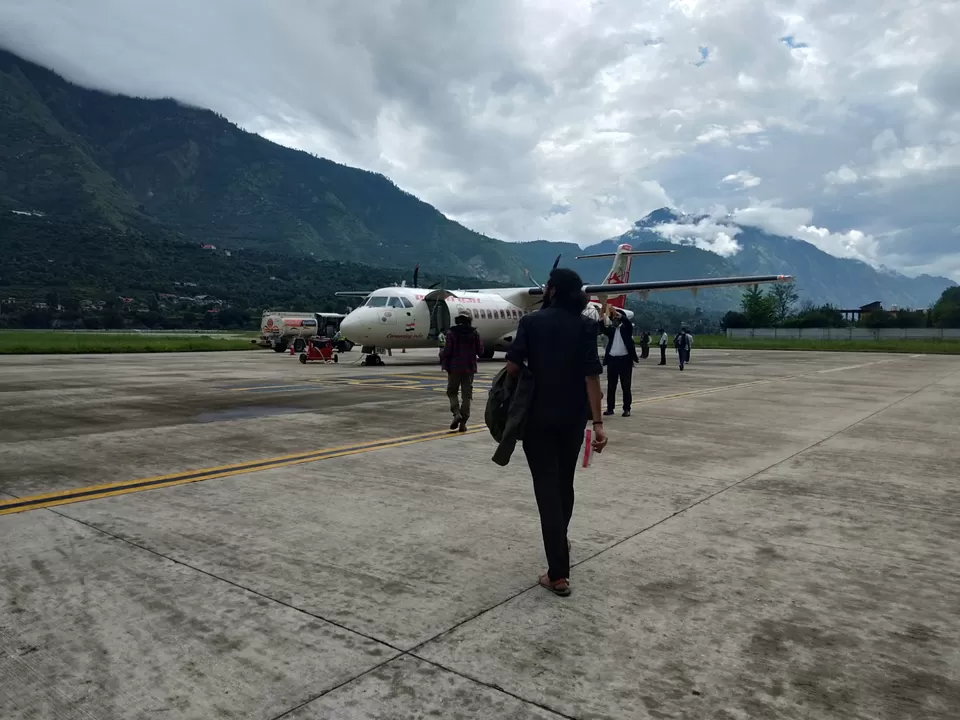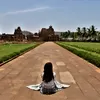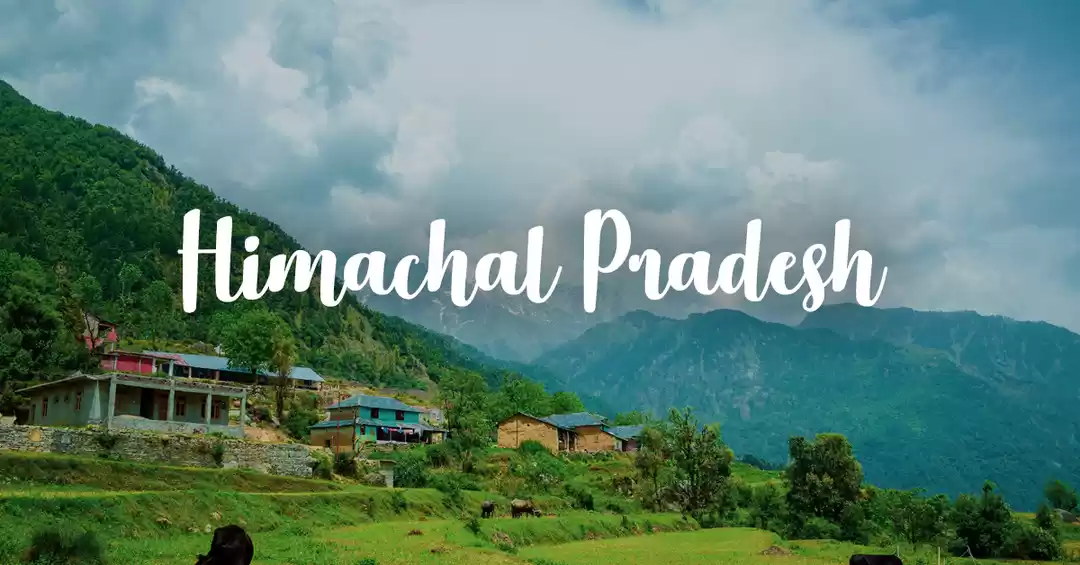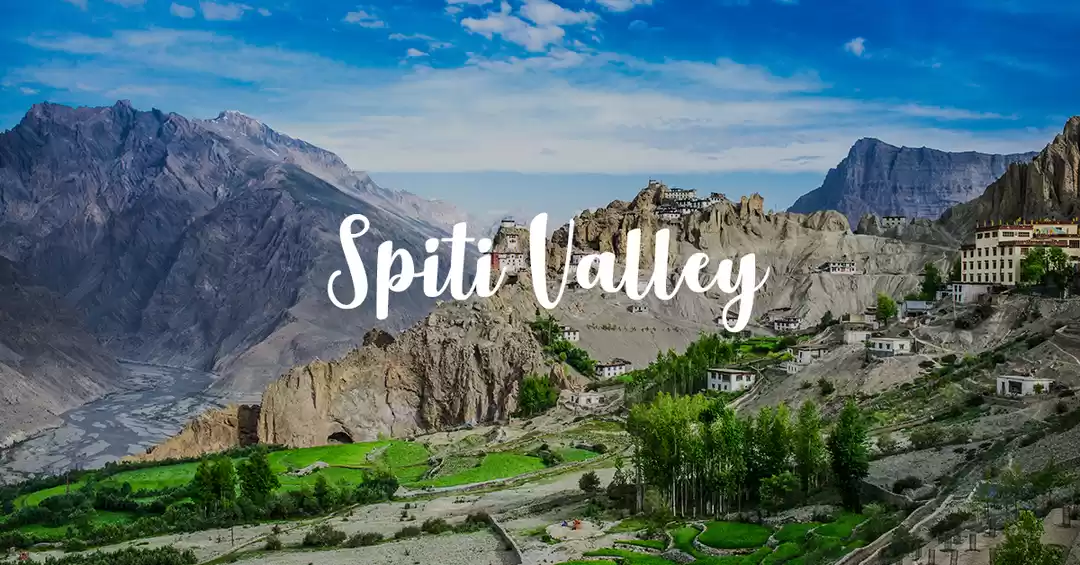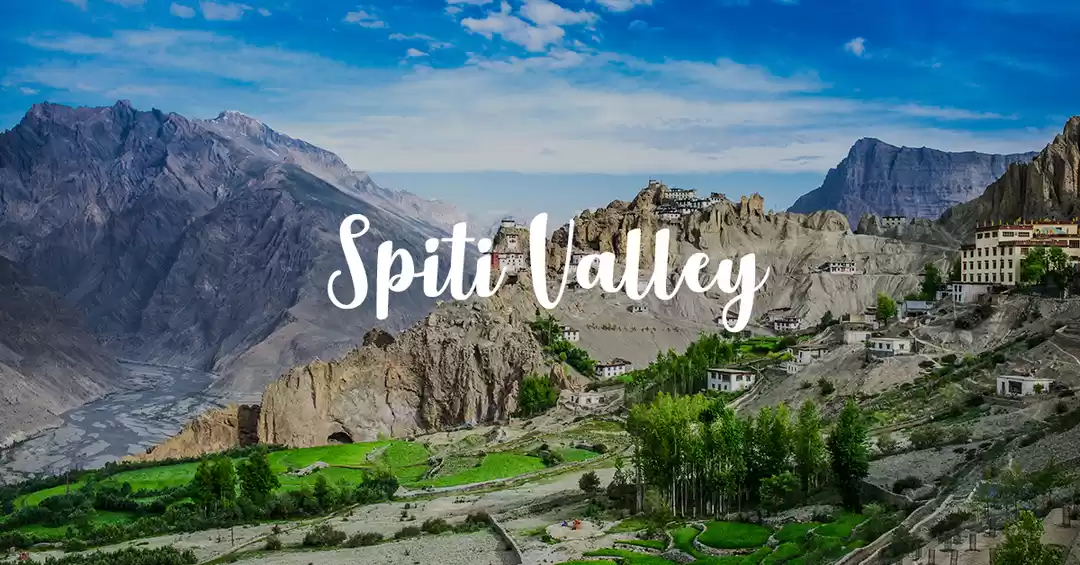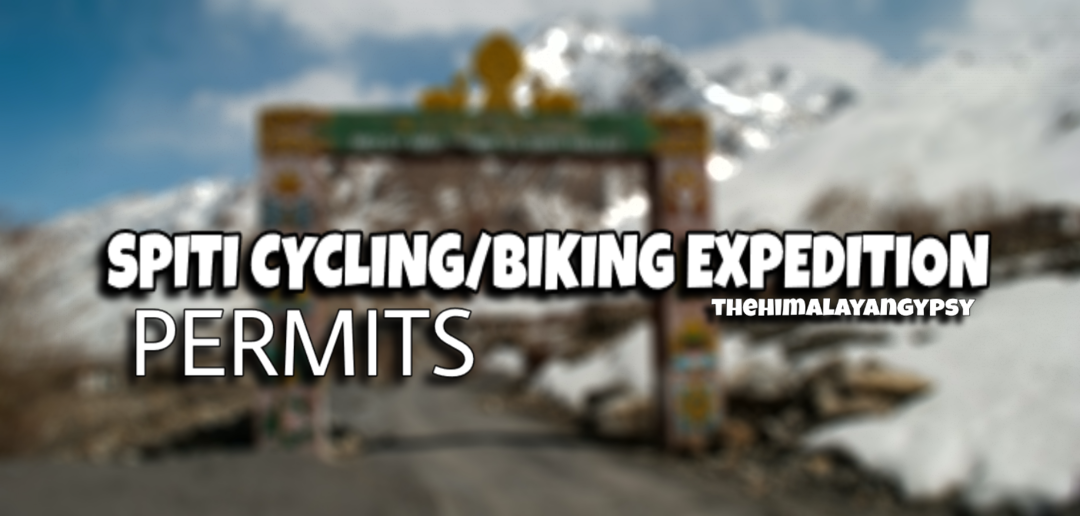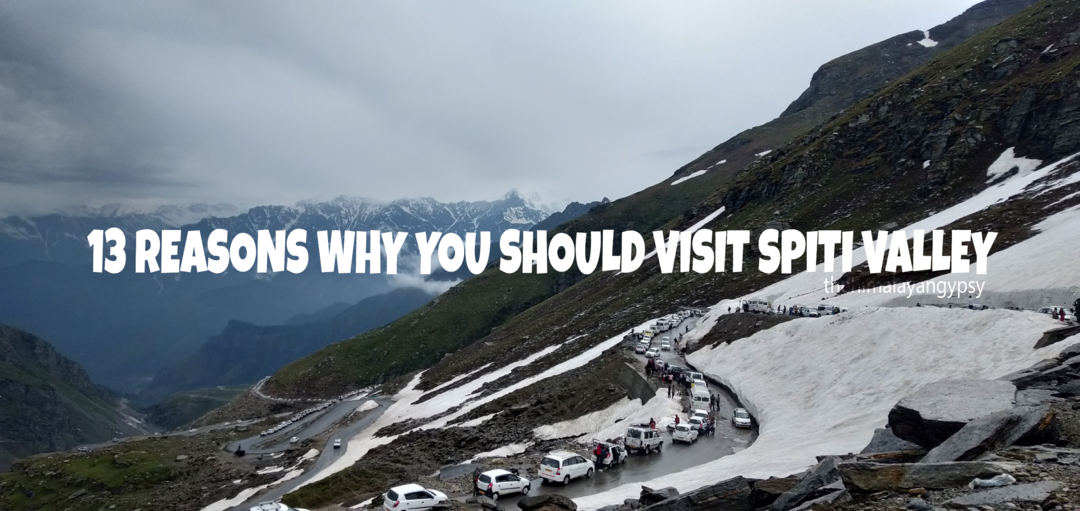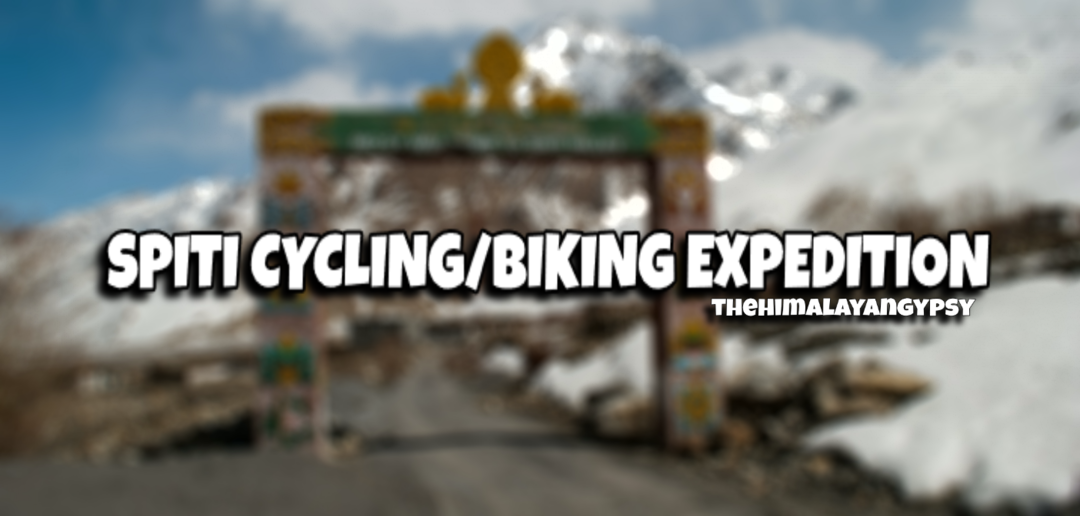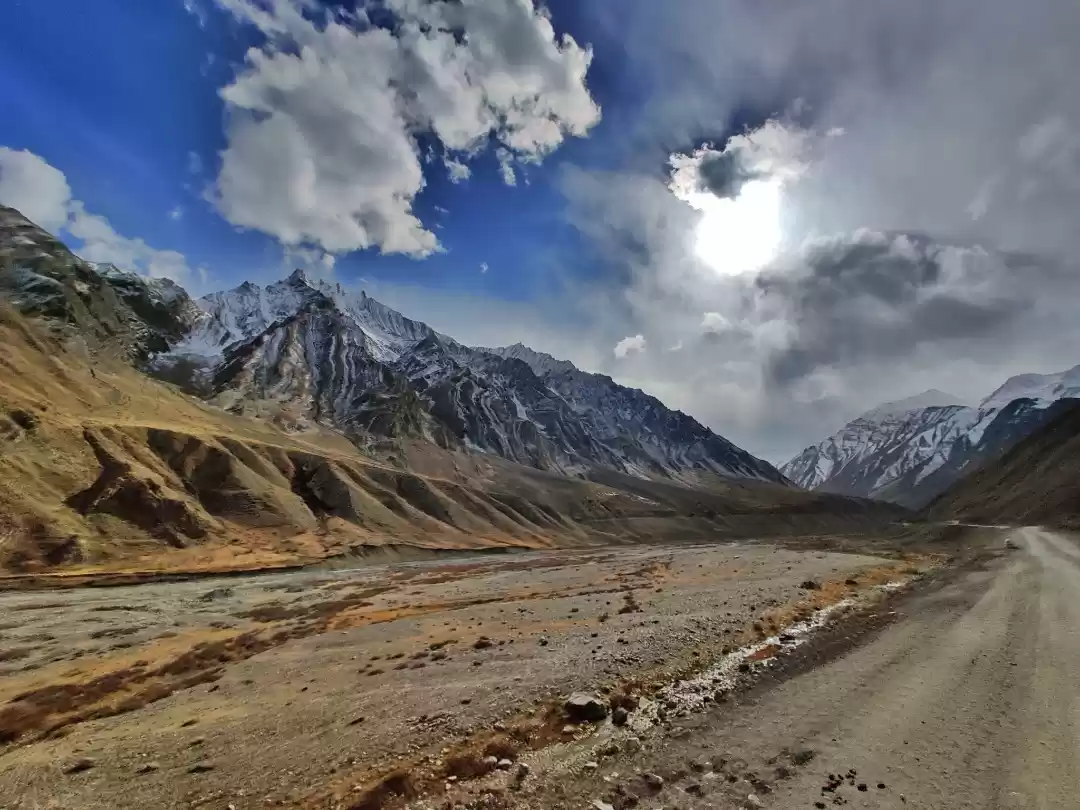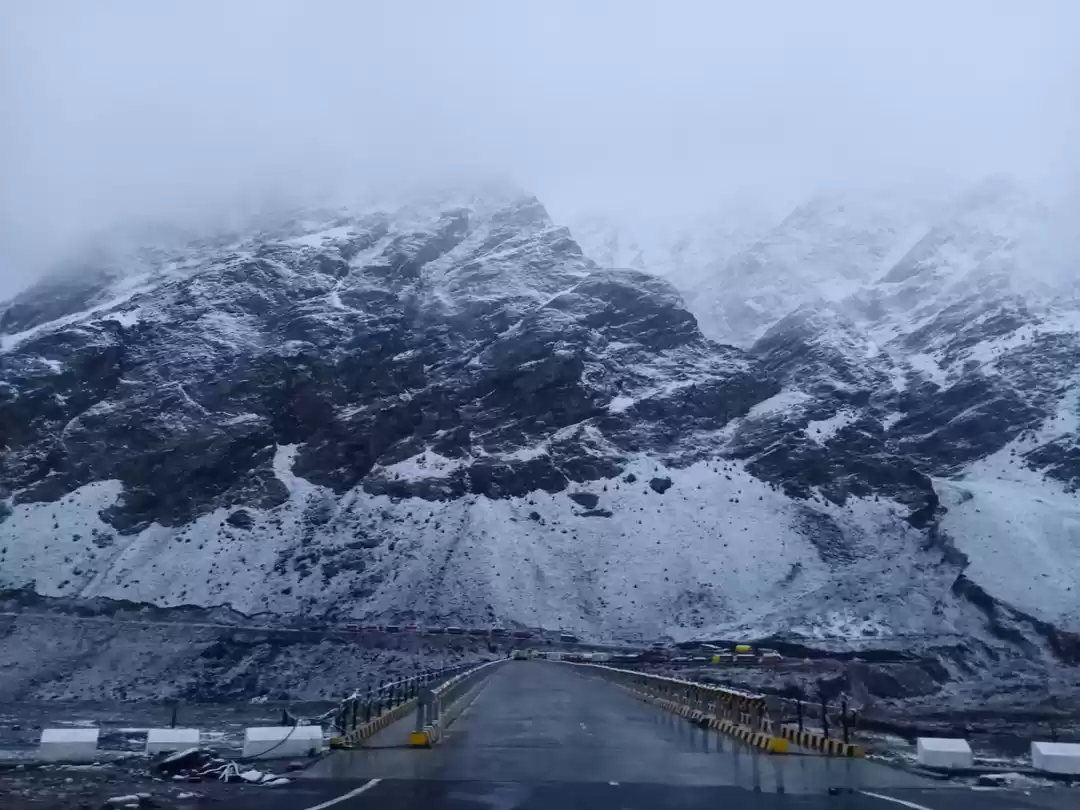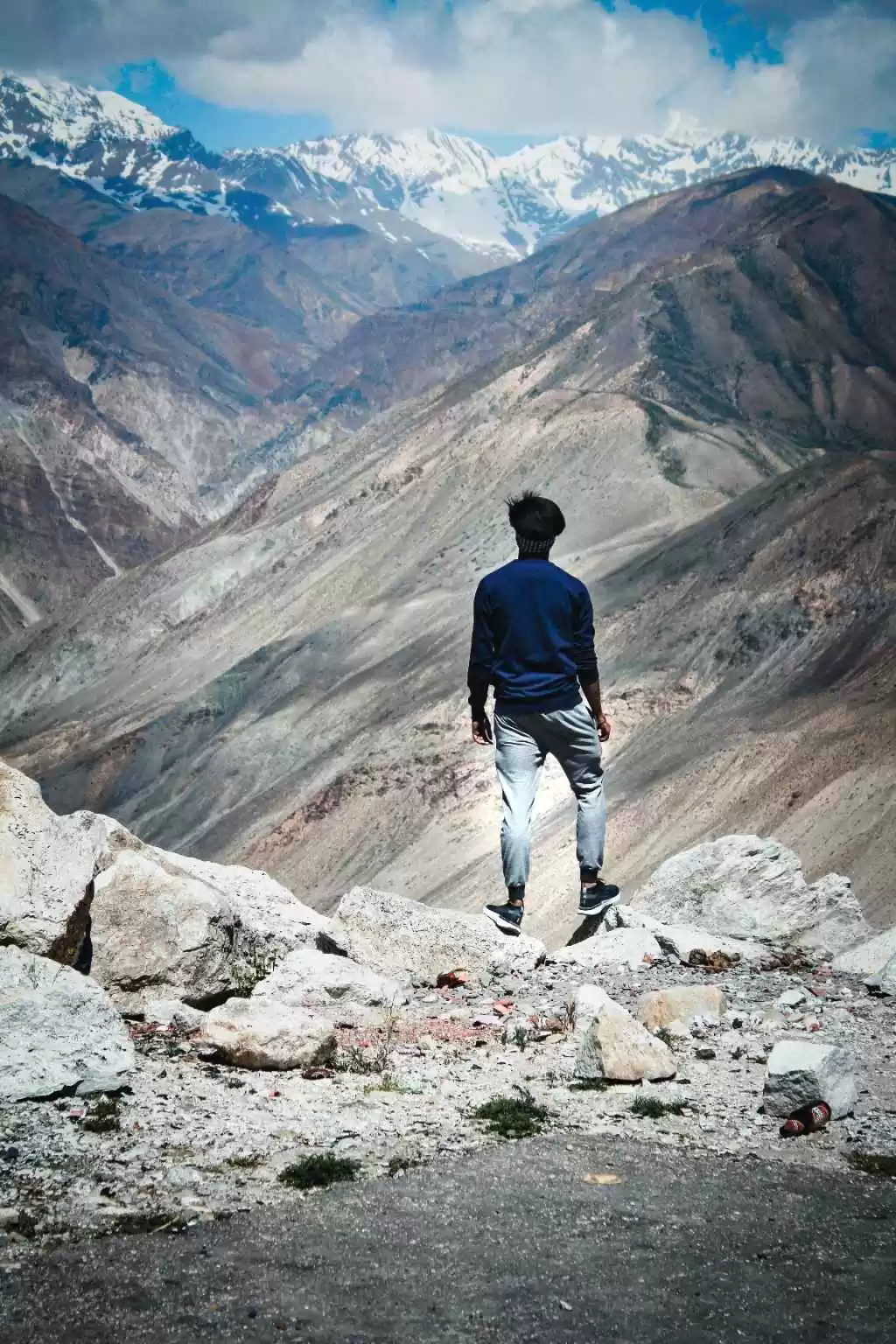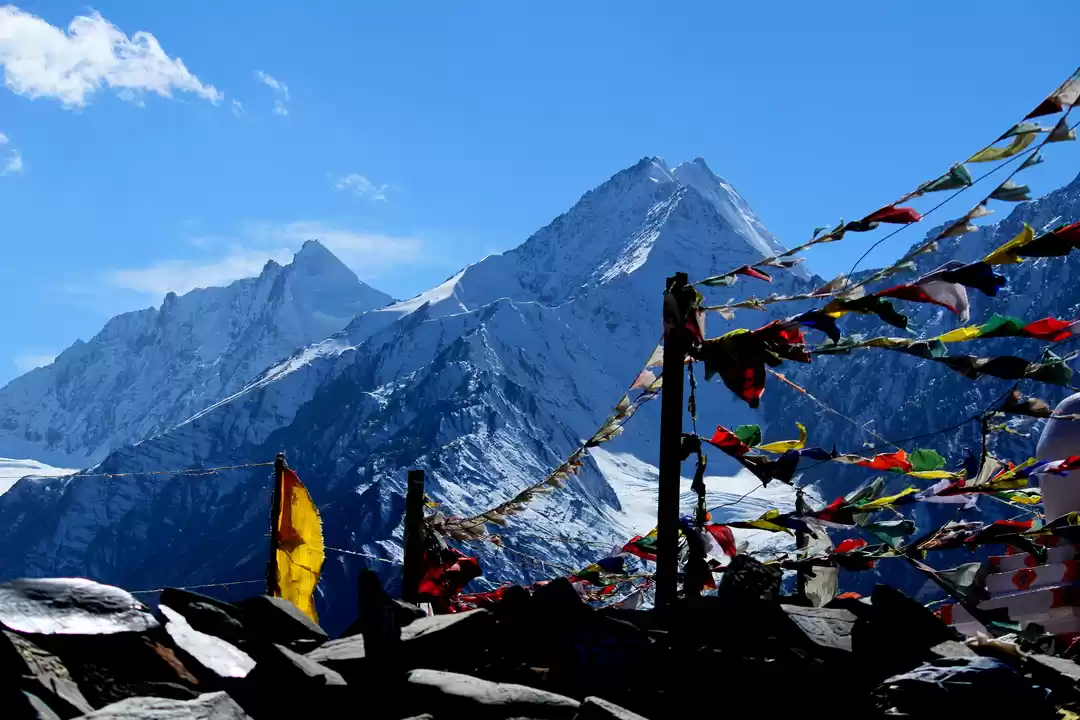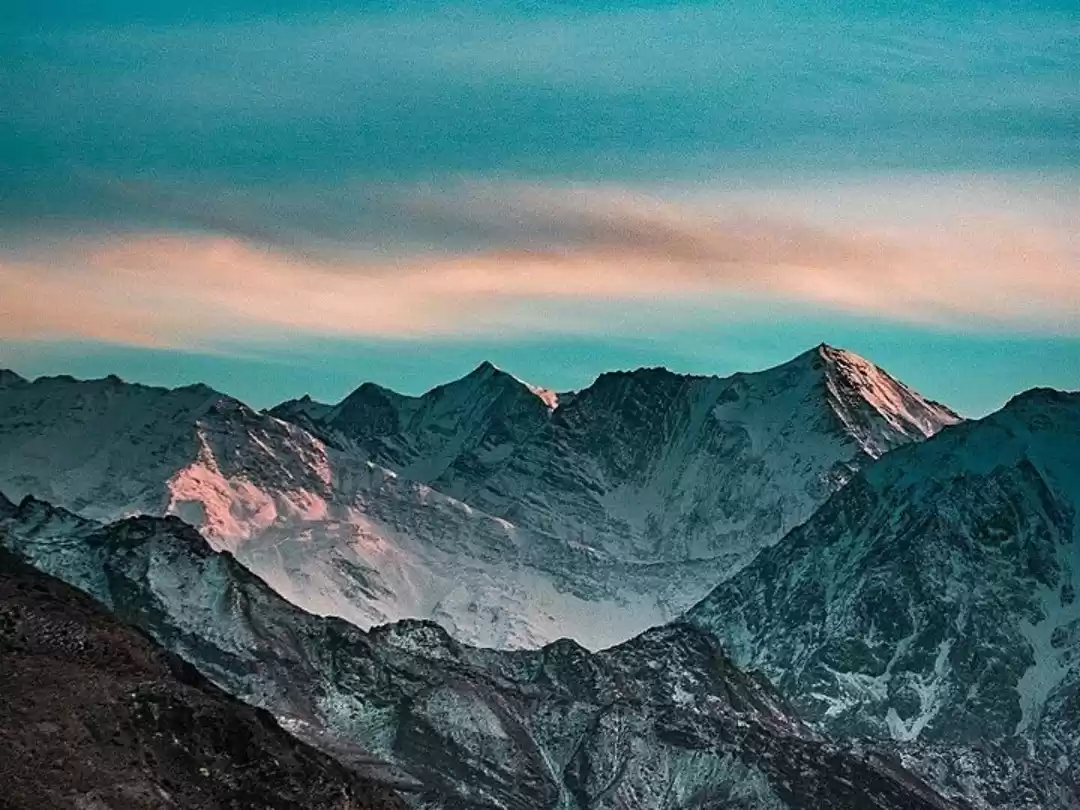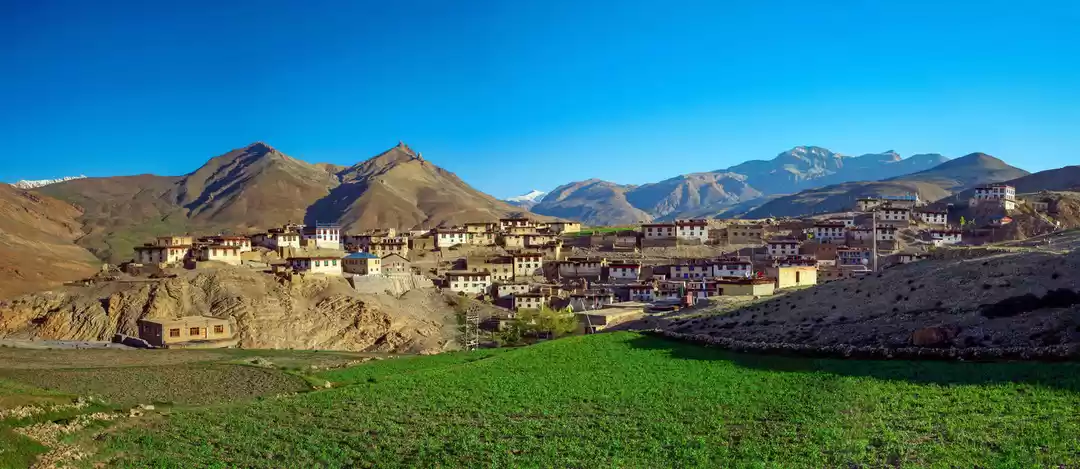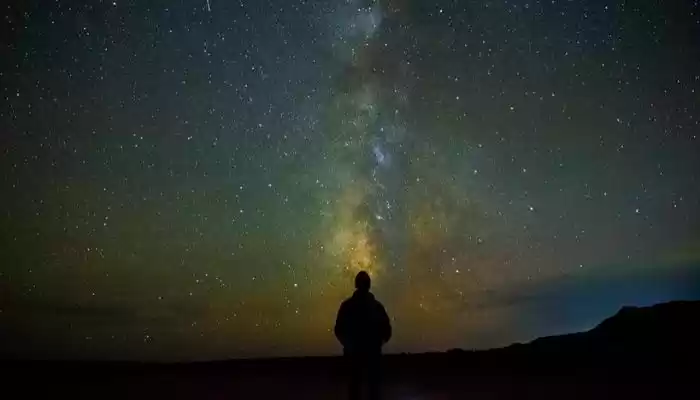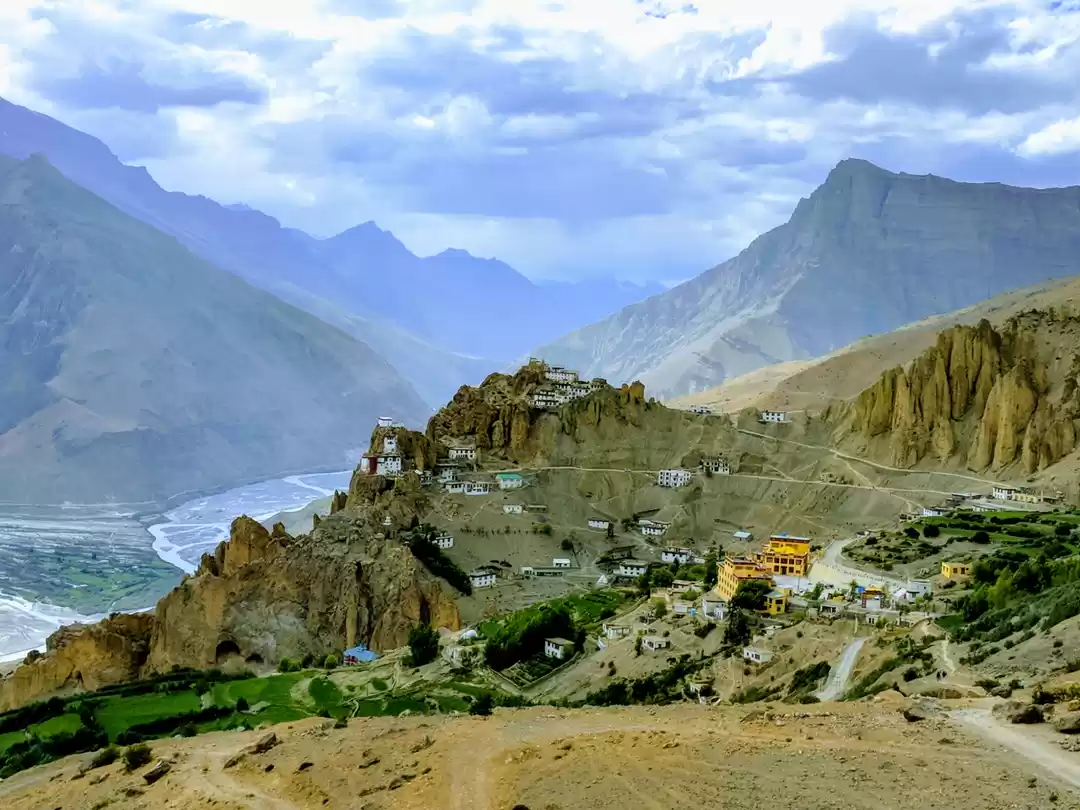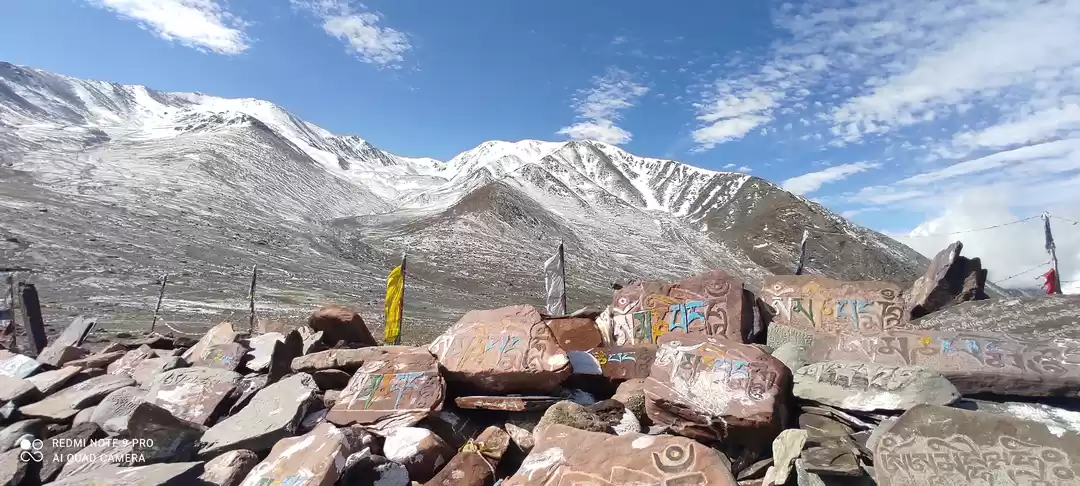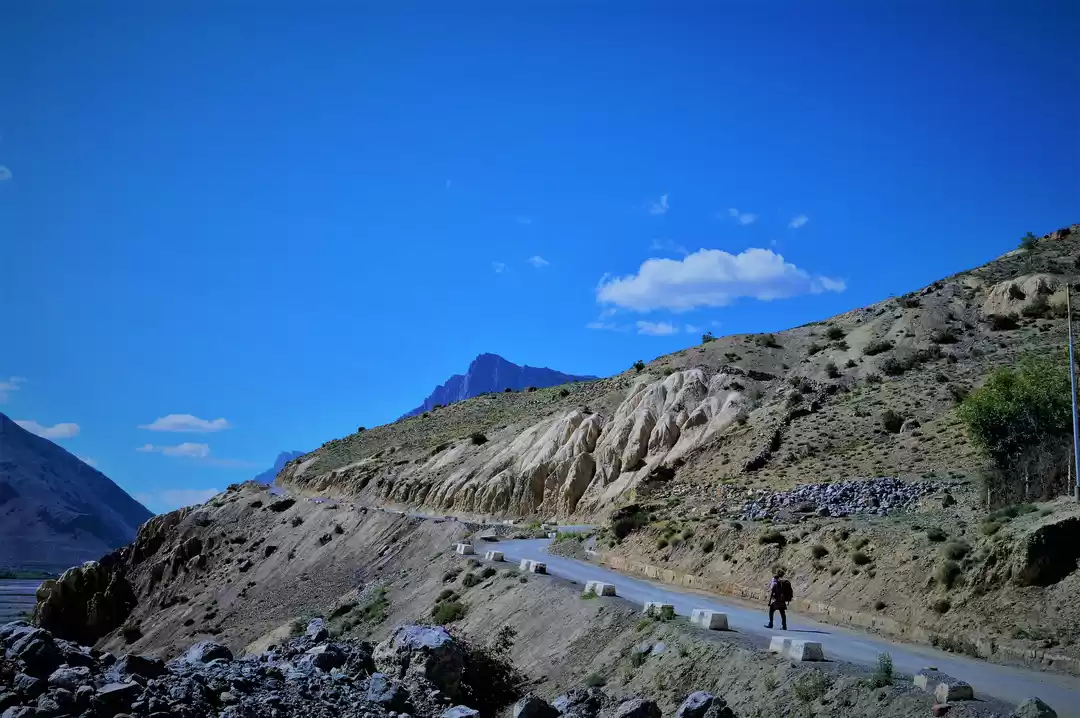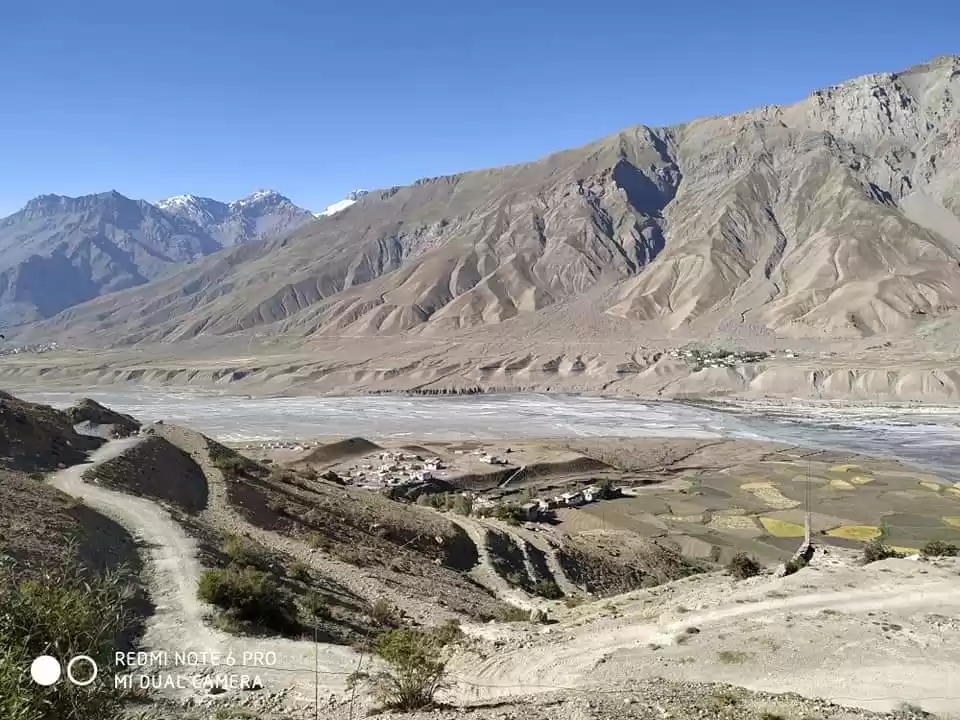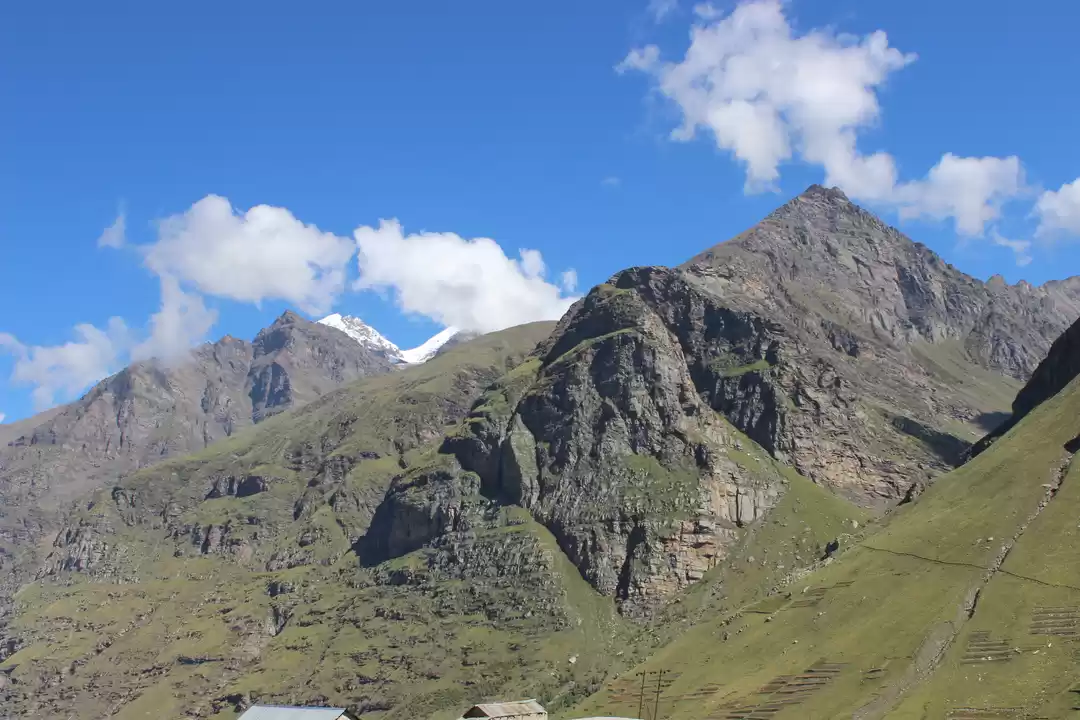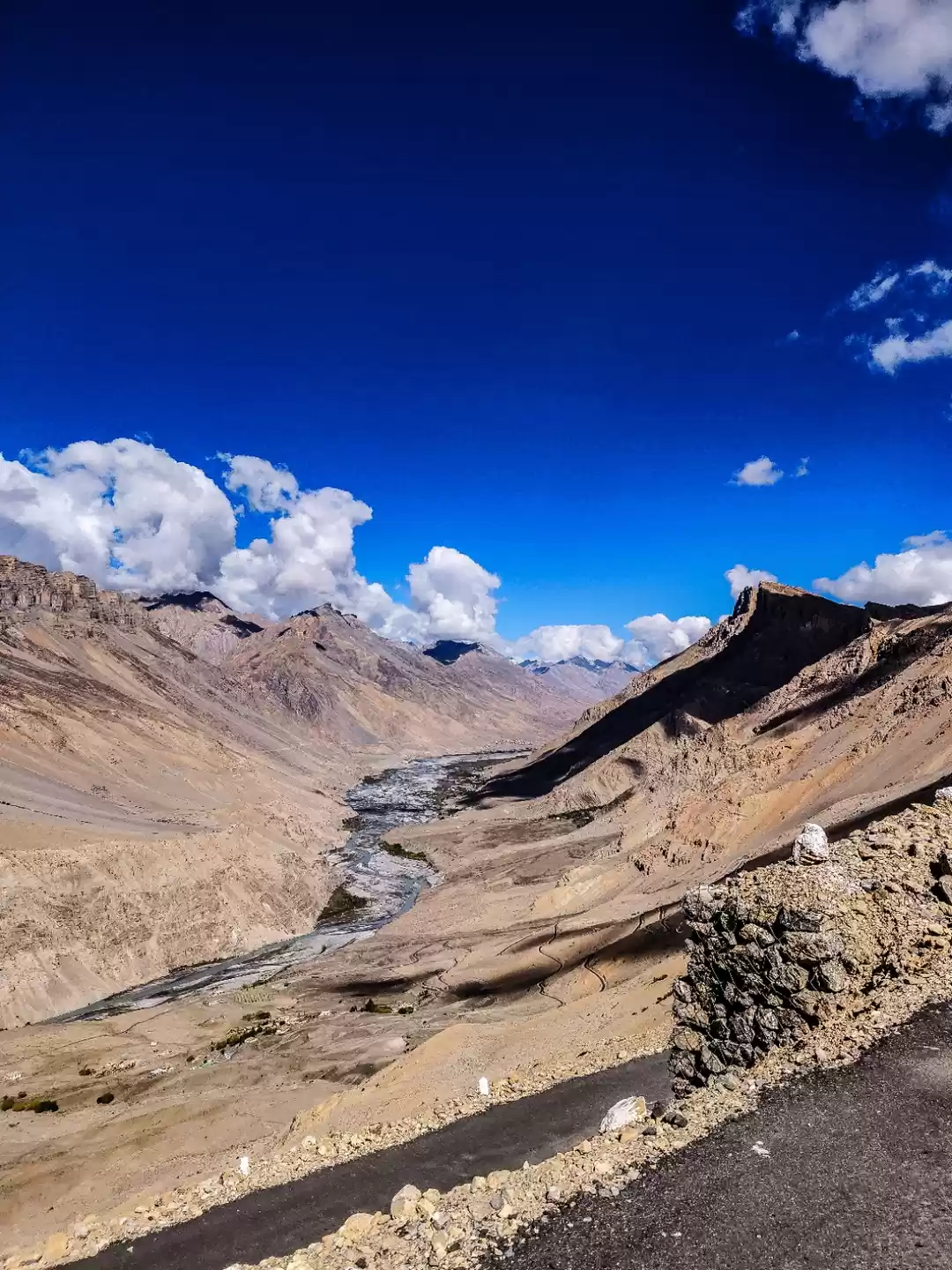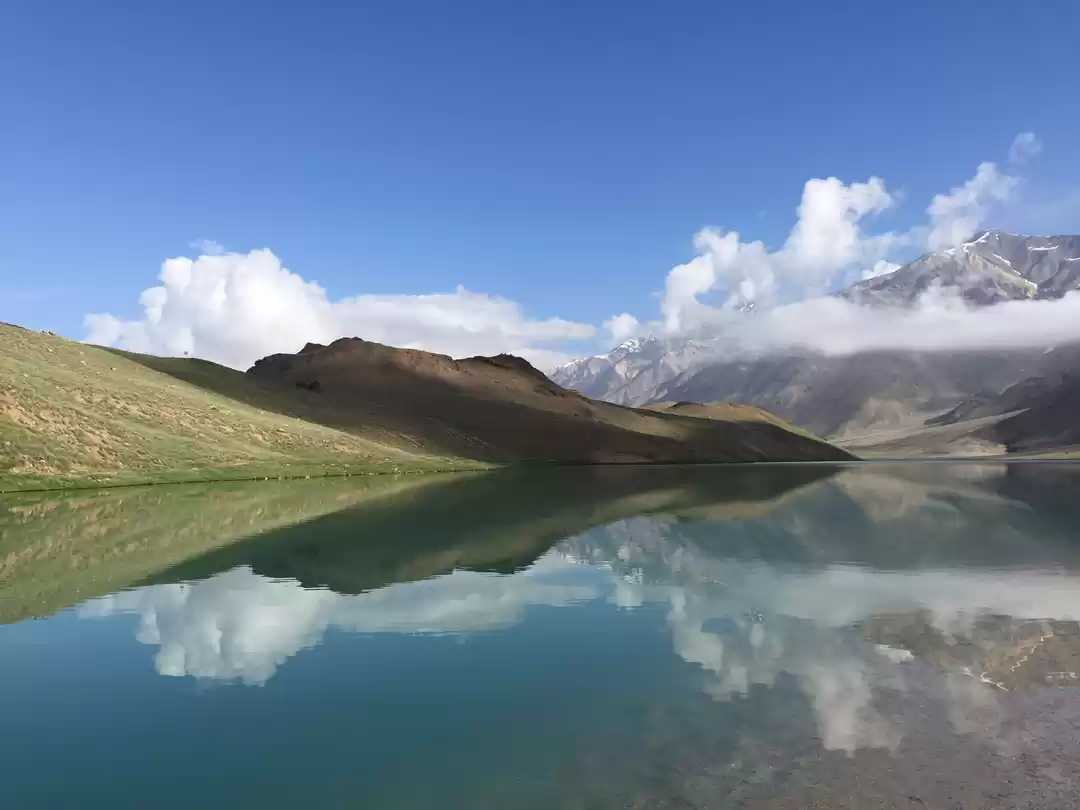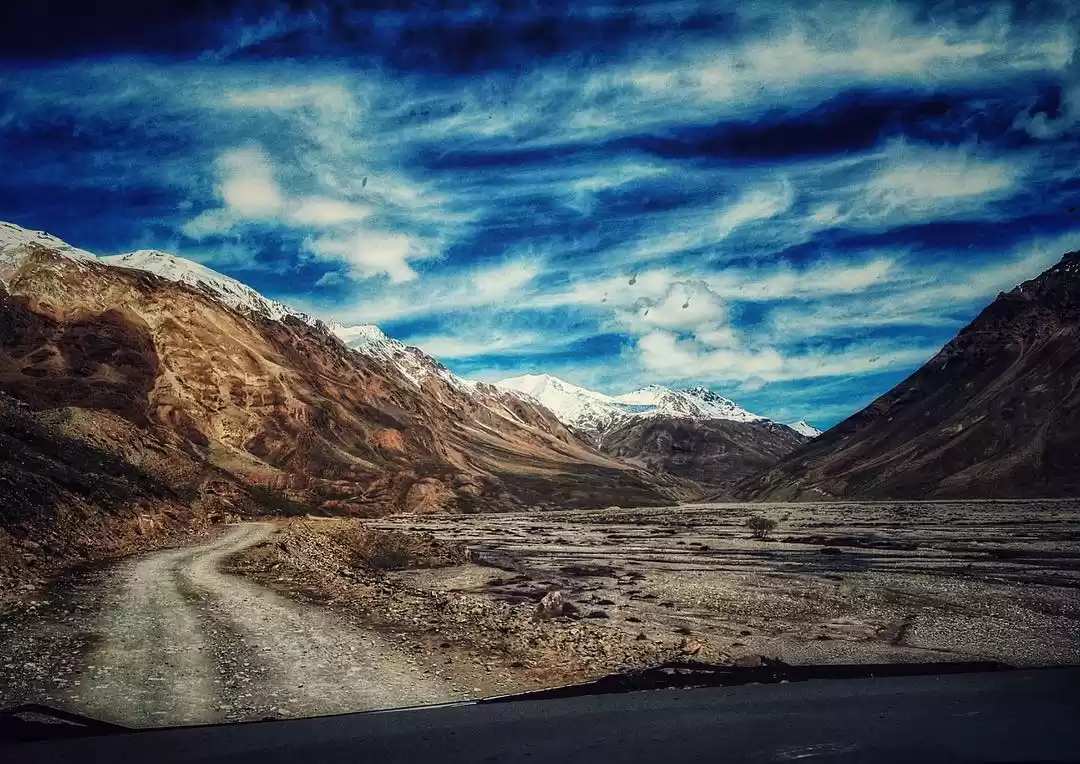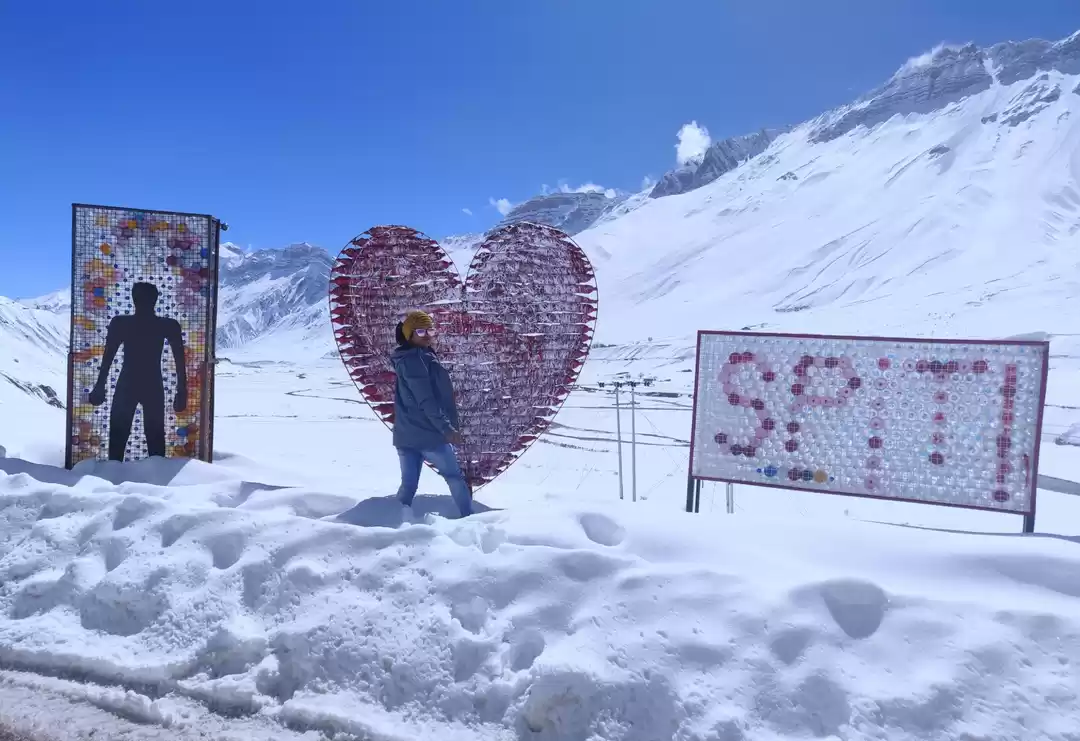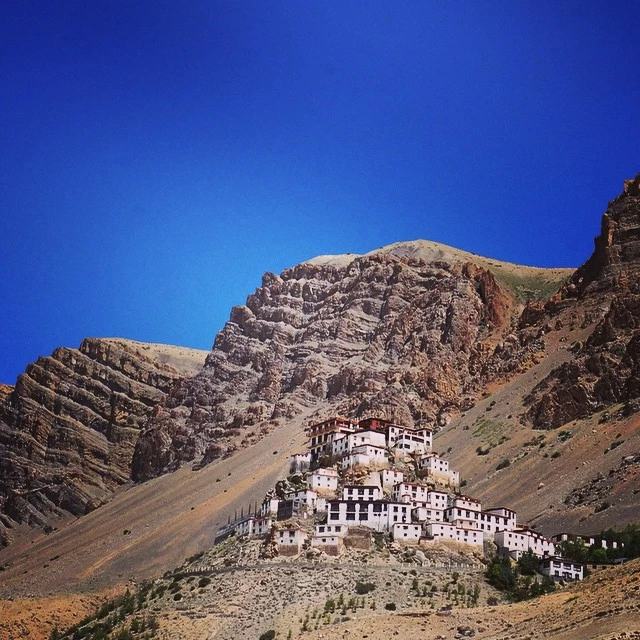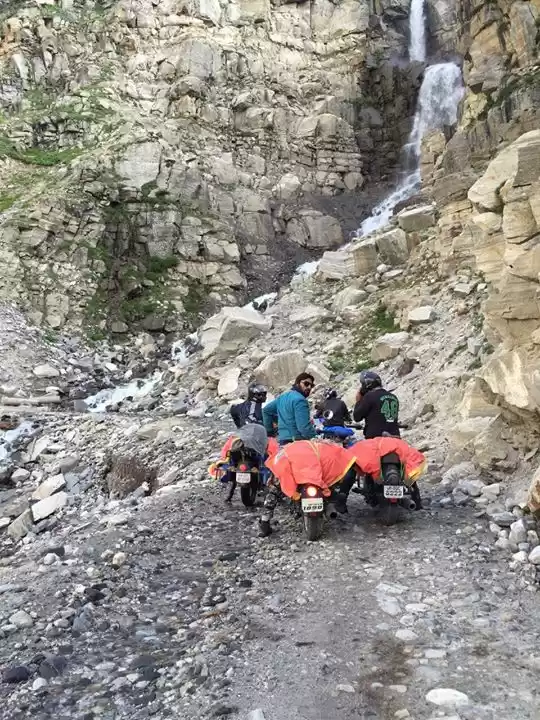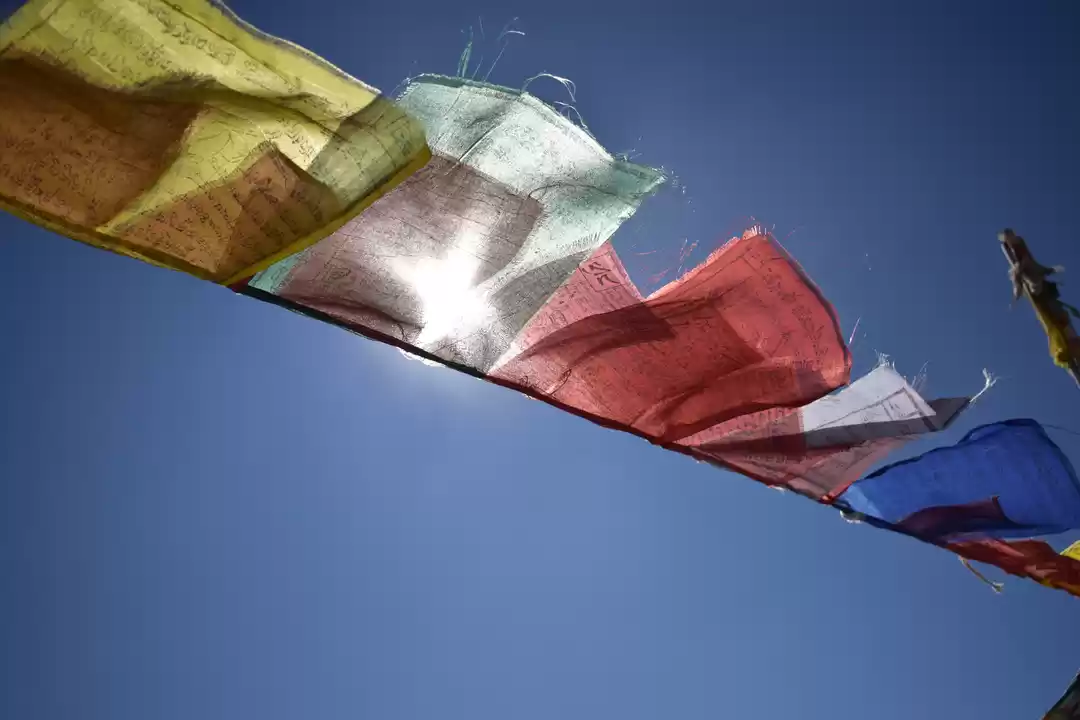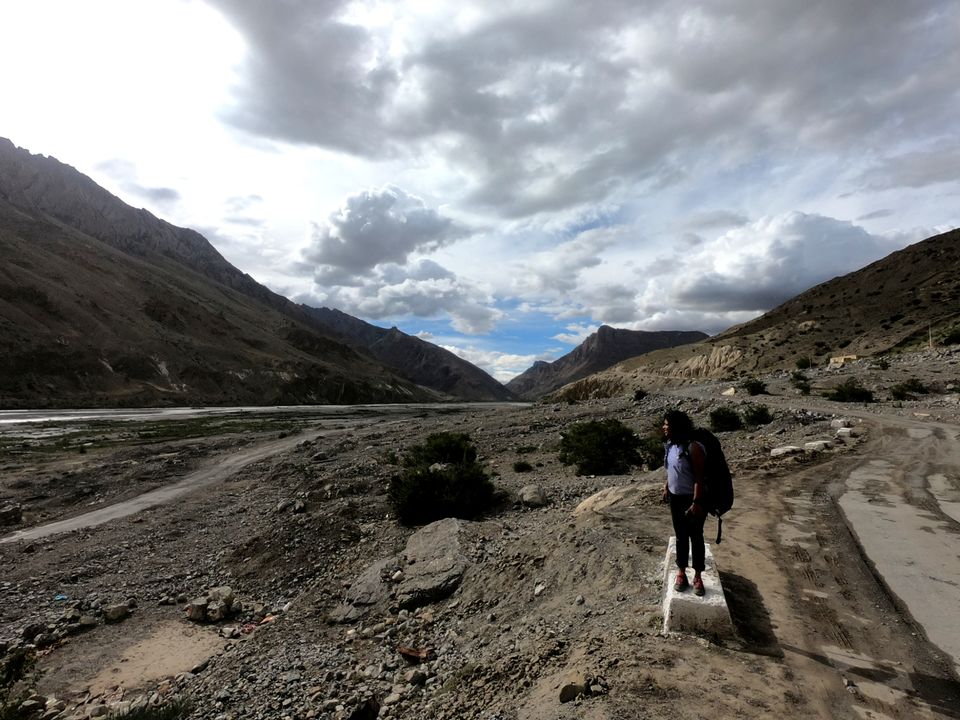
Day 1: Pre-Spiti
Today was just about getting to places pre-spiti -Delhi and Shimla in short.
So, we reached Delhi about midnight-ish and not having chalked out a clear Spiti itinerary, we decided to do that in the airport as our train to Kalka was at 5:35 in the morning from Old Delhi Railway Station. Since we hadn’t slept pretty much all night, we gratefully passed out on the train. When we were awake, we realised that it was way too hot to be awake. We also clicked some cliched pictures!
On reaching Kalka, we booked unreserved tickets on the legendary toy train! Pro-tip: book reserved tickets. The compartment was way too crowded and way too hot. The whole journey from Kalka to Shimla brought India’s population troubles in perspective. But we did have some fun!
On reaching Shimla, we took a cab to one of our favourite restaurants there – Hotel Marina. While it is a little expensive, the food is absolutely worth it. The cab dropped us halfway and the rest of the way we made it on foot and the “lift” and we are thankful for that. We witnessed the most gorgeous sunset ever in Shimla. It had been raining in Shimla and big clouds hung about everywhere like cotton candy tinged with the sun’s orange glow.
On reaching Shimla, we took a cab to one of our favourite restaurants there – Hotel Marina. While it is a little expensive, the food is absolutely worth it. The cab dropped us halfway and the rest of the way we made it on foot and the “lift” and we are thankful for that. We witnessed the most gorgeous sunset ever in Shimla. It had been raining in Shimla and big clouds hung about everywhere like cotton candy tinged with the sun’s orange glow.
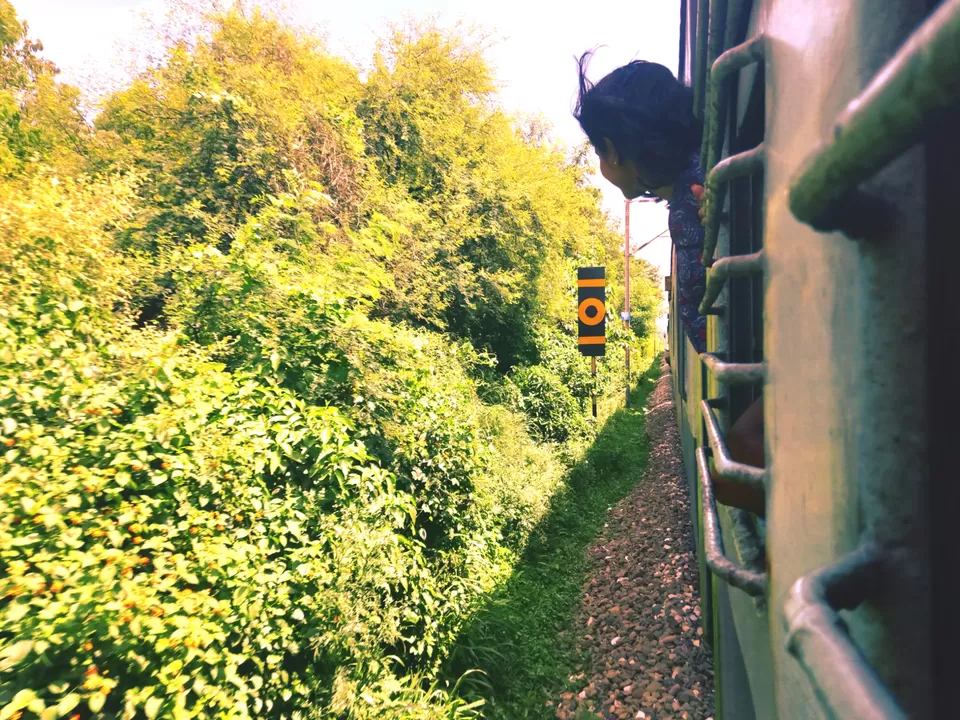
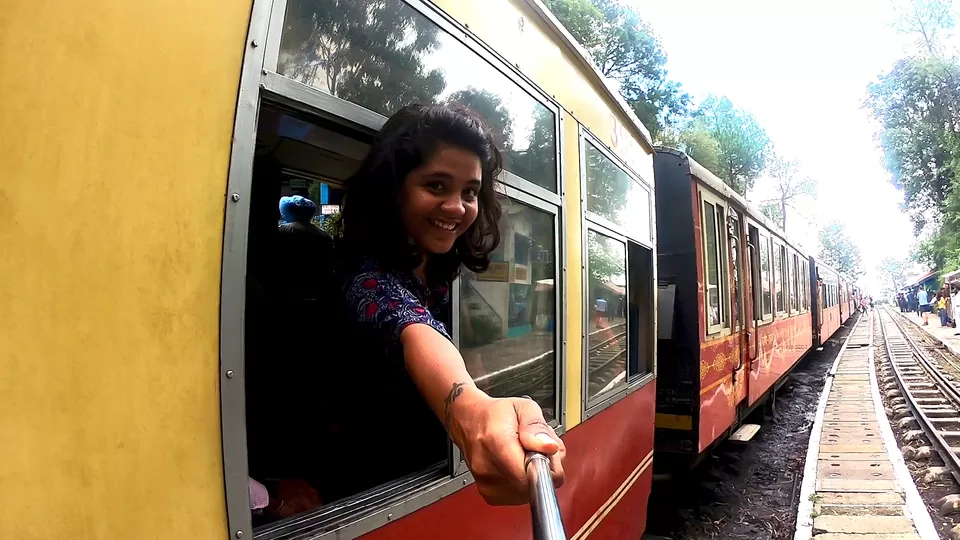
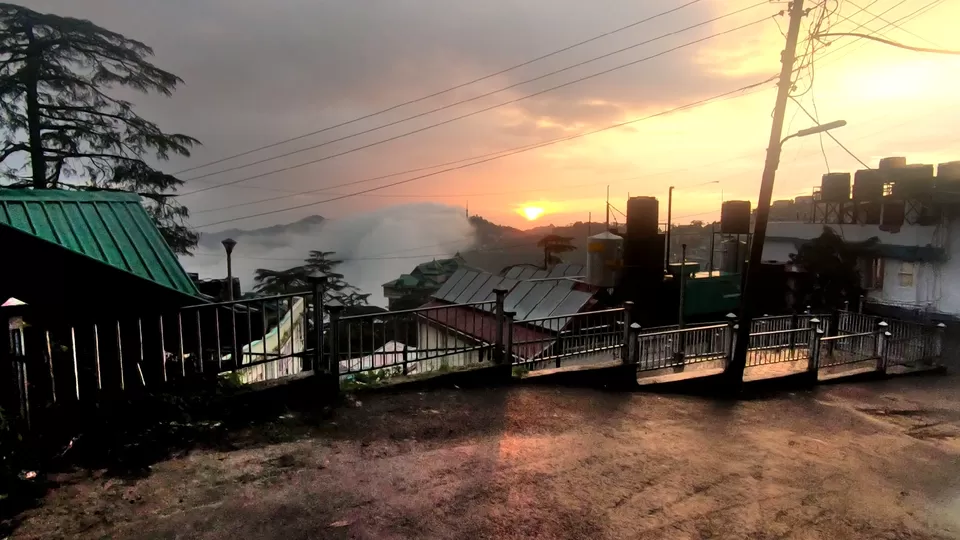
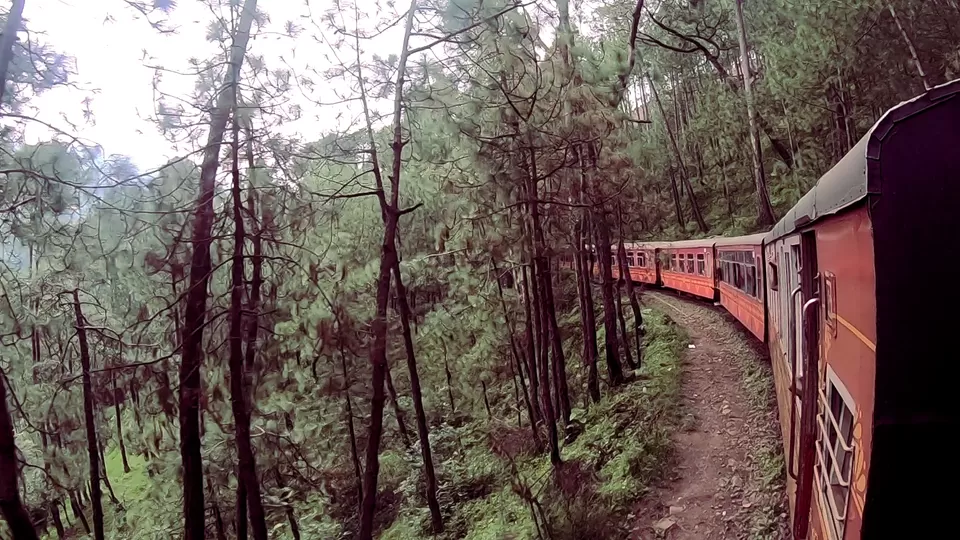
Day 2: Reckong Peo-Kalpa
We woke up in the bus very early in the morning, thanks to rocky roads, only to have our mouths drop. There was a rocky face on one side and a sheer drop into an angry, gushing Sutlej river on the other side. After a rocky, rocky ride, we reached Reckon Peo bus stop.
Reckong Peo is a small hamlet which is bordered by mountains which include the Kinnaur-Kailash range. We did not hang around much in Peo. We took a bus to Kalpa which is about an hour from Peo. We decided to go to Kalpa before entering into Spiti valley (Kalpa is in Kinnaur) because we needed the rest. Kalpa was absolutely gorgeous. In Kalpa, we stayed in a place called Chini Bungalow. We paid INR 1000 for a single night stay here.
Our host was Mr. TR Thakur – a really nice person – helped us plan our itinerary and told us where we can visit around. After freshening up and having hot aloo parathas in Dinesh Bhojanalay, we decided to walk to the next hamlet – Roghi.
Roghi is about 5 km from Kalpa and the road passes through apple orchards on either side. The road then winds and winds around the mountain. Pro-tip: Please be careful if you are walking because 4-wheelers can come barrelling down the road. About halfway to Roghi, there is a point called the suicide point which is a sheer drop. Thankfully, when we reached there, the place was empty. But very soon there were tourists around. So, we would suggest starting a little early. Also, please be very careful at suicide point. It did not get the name without a reason!
We reached Roghi village in time for lunch. But, Roghi being a small place, did not have any dhabas or restaurants. It had barely 2 stores. We picked up some dates from one of the stores and started walking back. We were starting to get tired. About halfway back, we hitched a ride towards Kalpa. Famished, we went to a tiny dhaba and had yummy thukpa and momos. We, then, headed back to Chini Bungalow for some rest.
Later in the evening, we decided to walk around Kalpa and visit its monasteries. From the backyard of one of the monasteries, we made a timelapse video of clouds moving. While we were guarding our GoPro, a very kind fellow tourist said the frame we were standing in was beautiful and clicked a few of our pictures. We went to the second monastery. By this time the night had fallen and the air was reverberating with fluttering flags, drums and chants from the monastery. It was a peaceful experience. After a quick dinner at another dhaba (chapati and aloo gobhi), we decided to turn in for the night as we would have another long day of travel the next day.
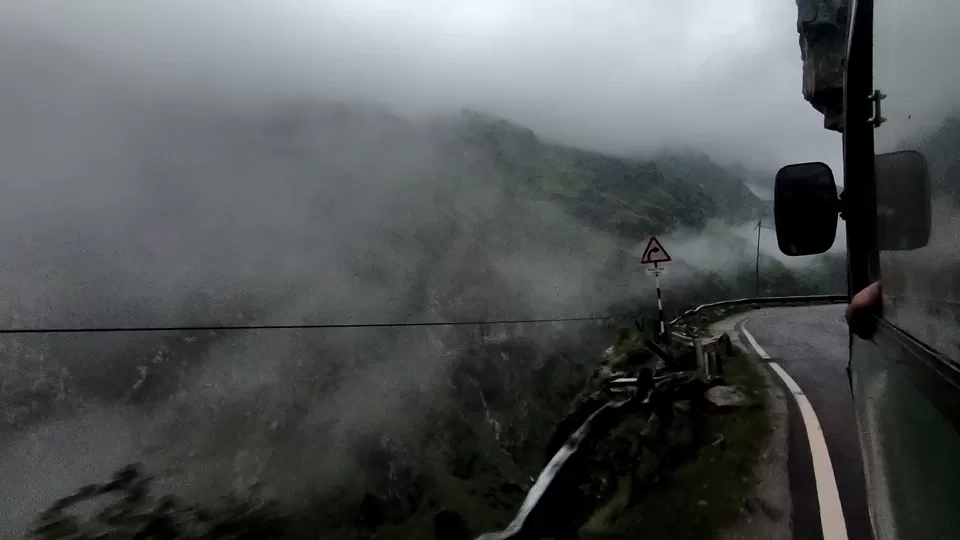
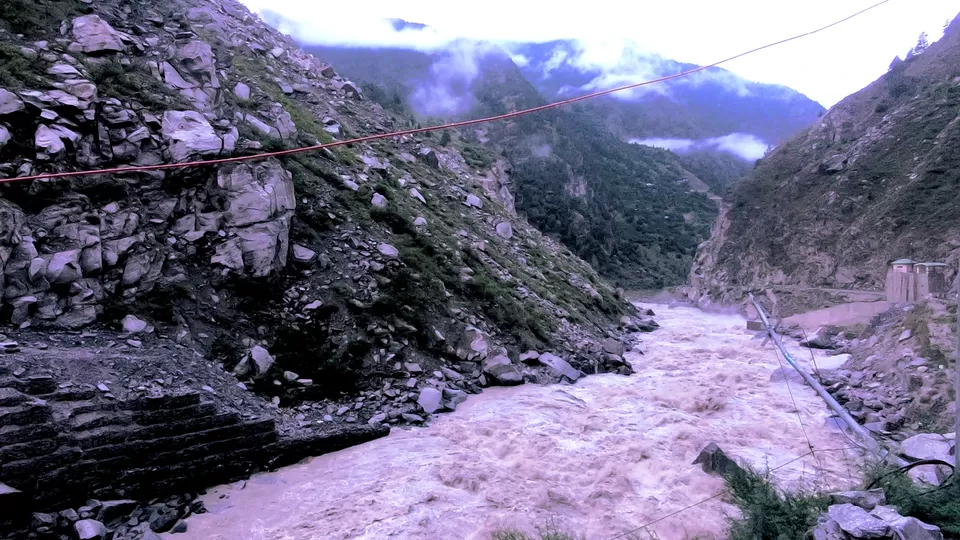
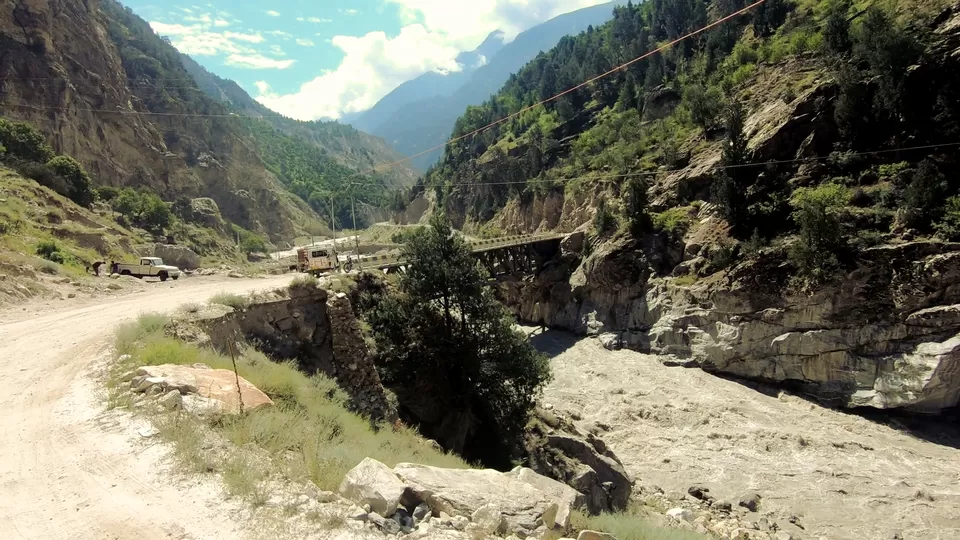
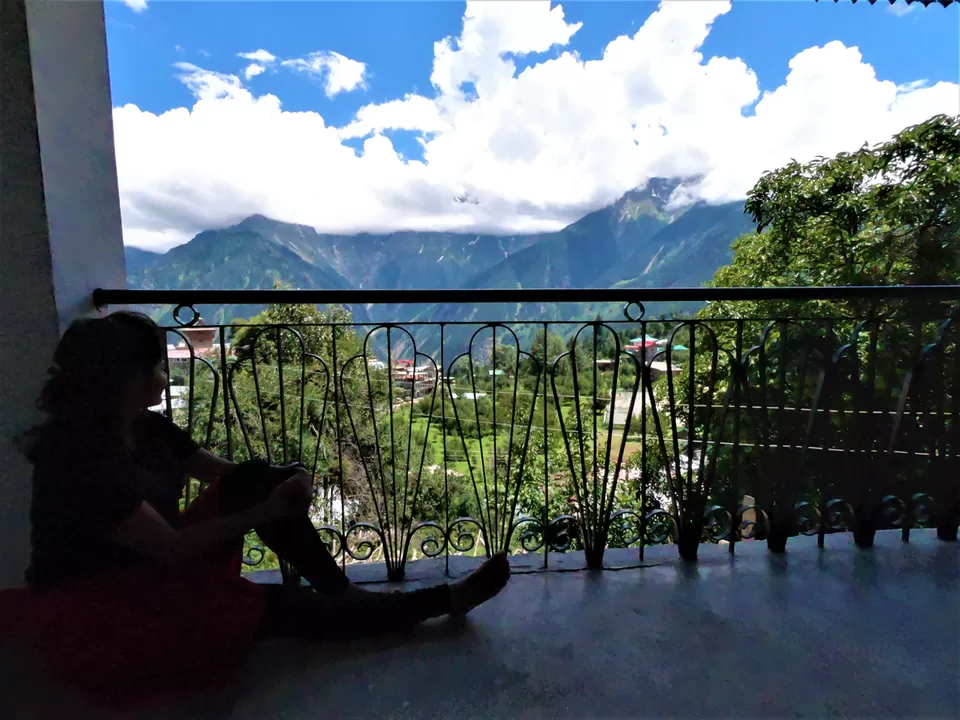
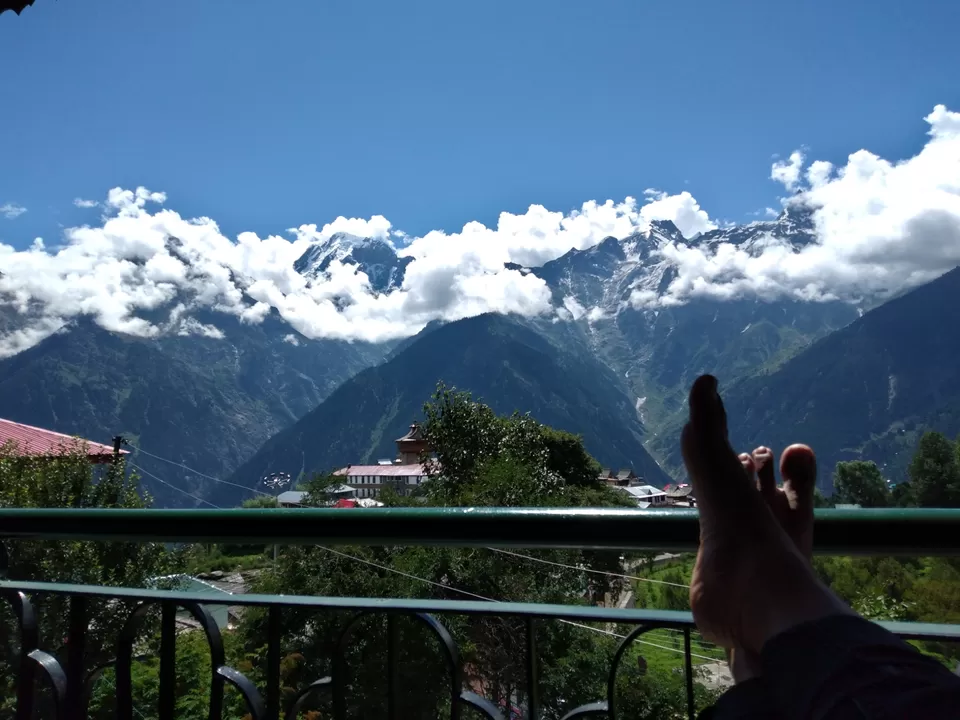
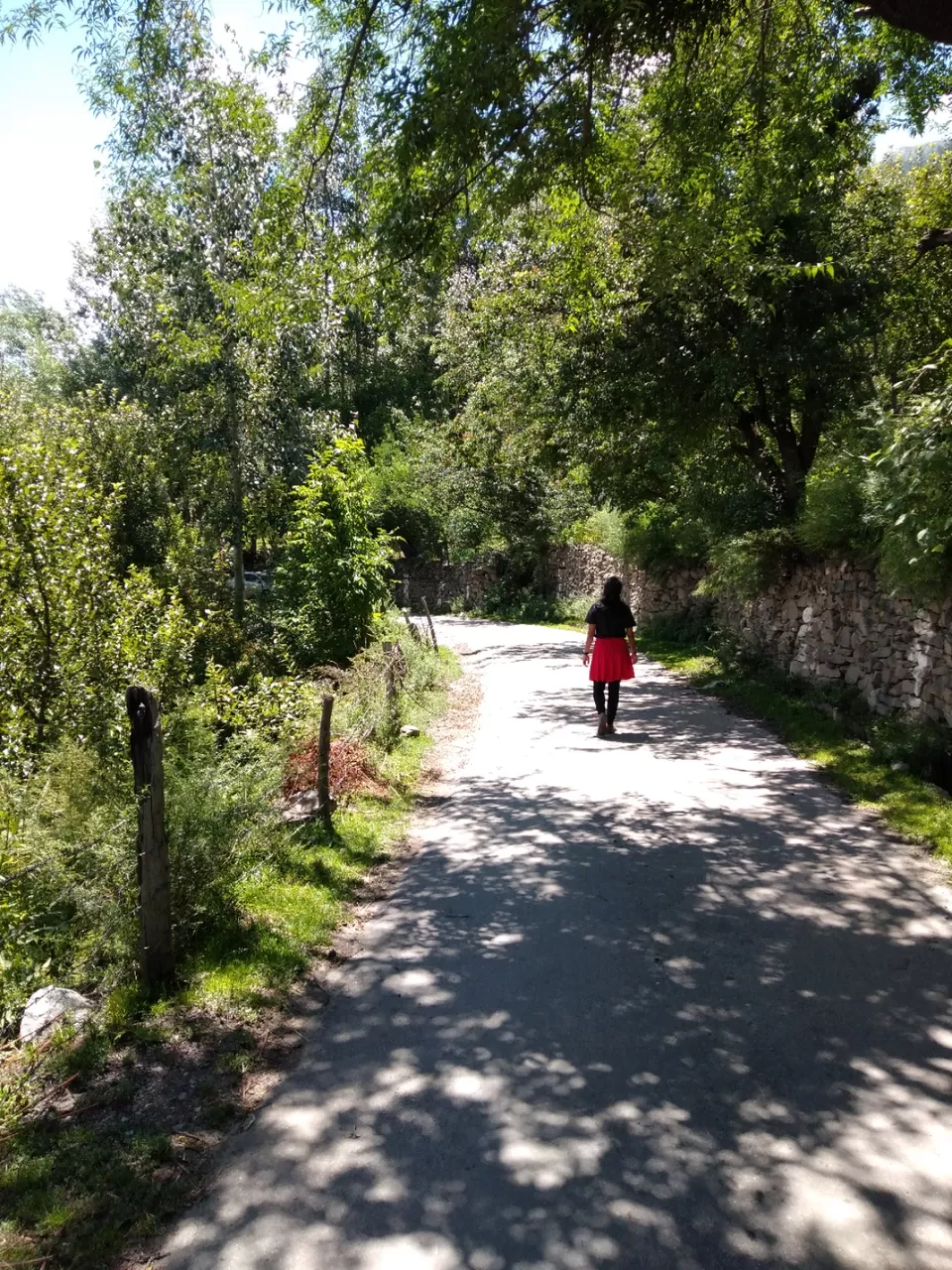
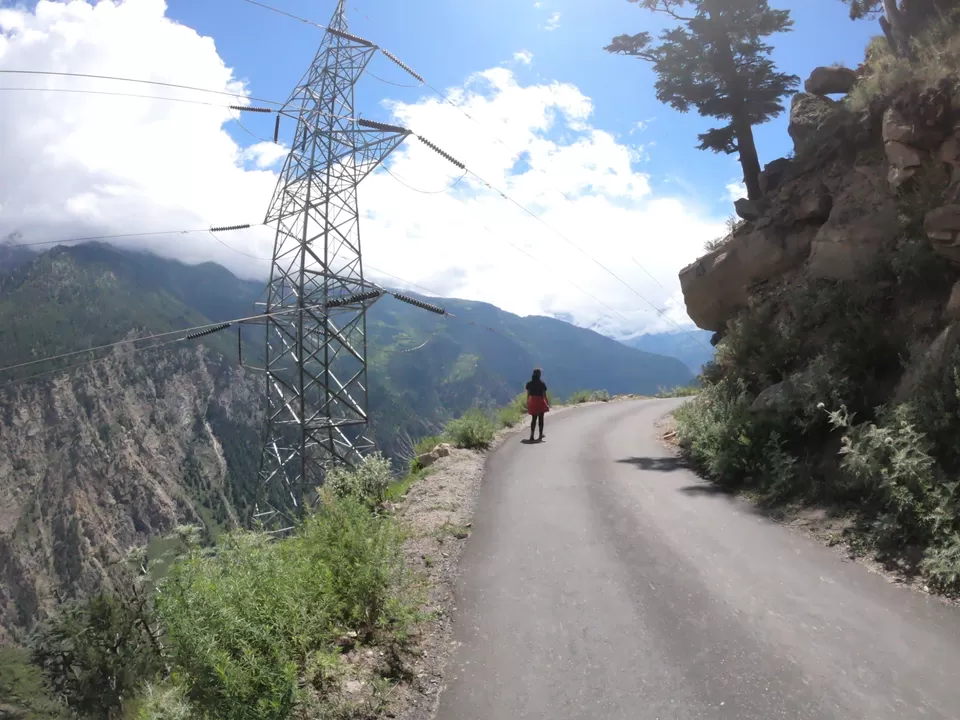
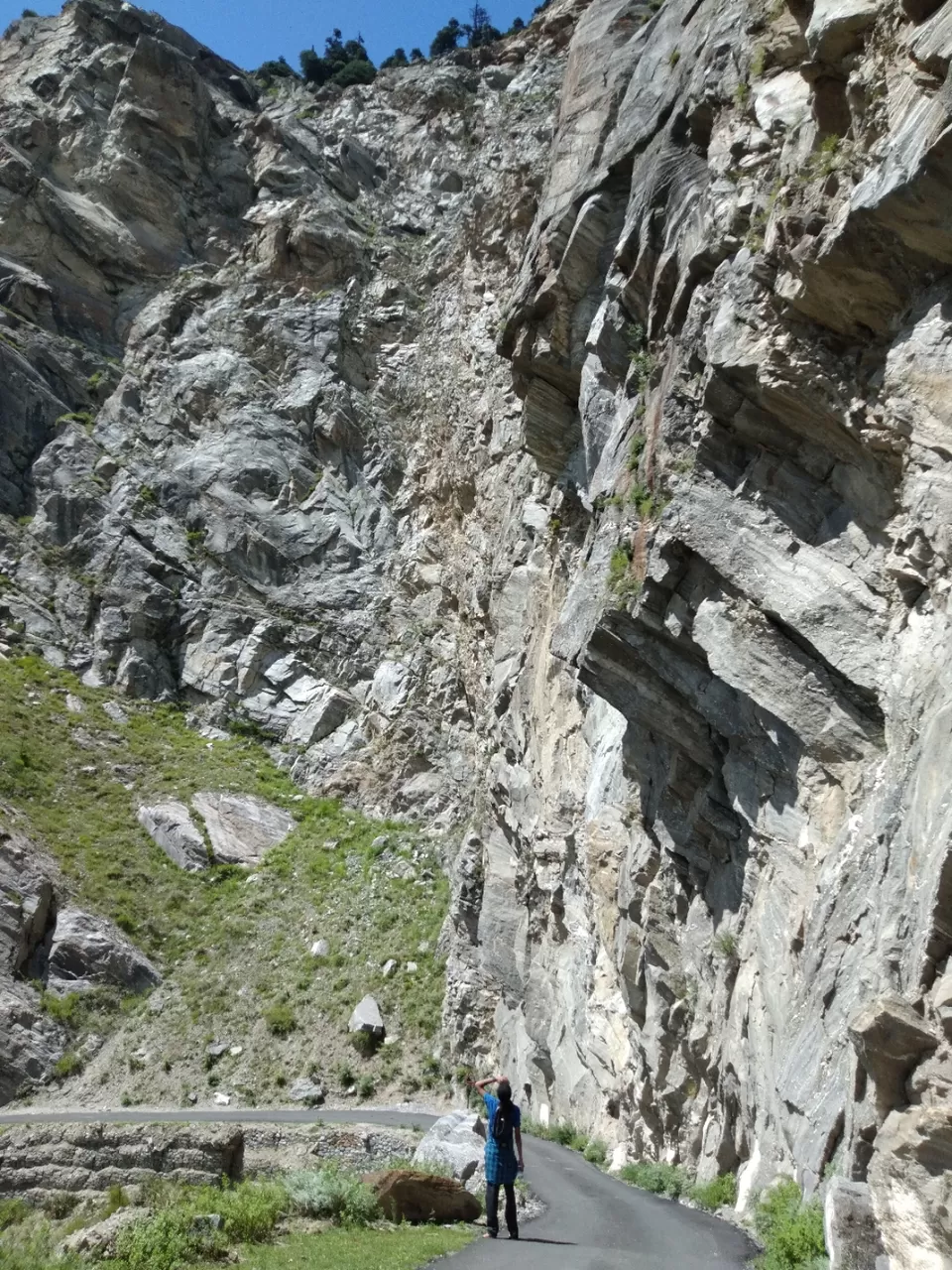
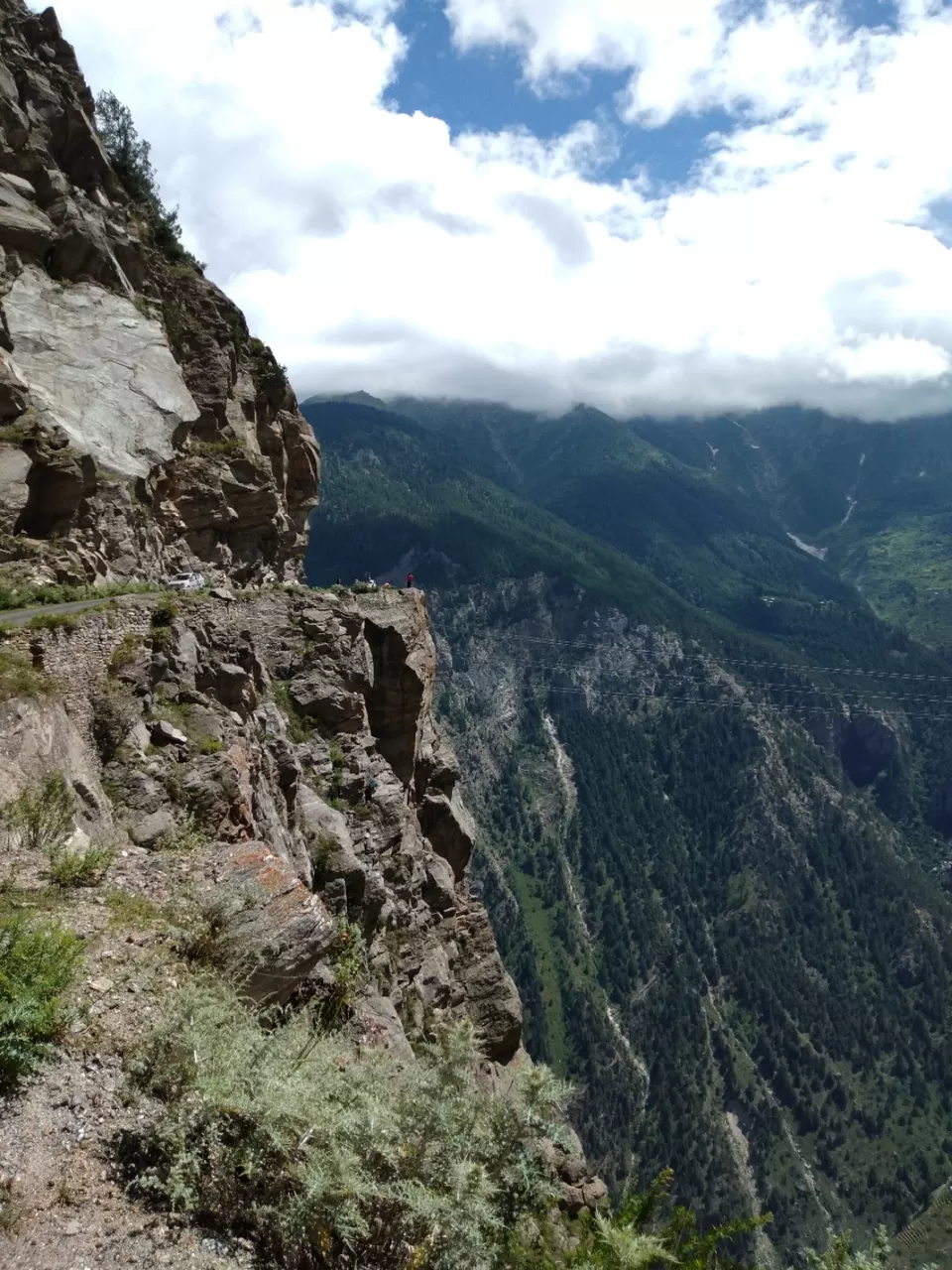
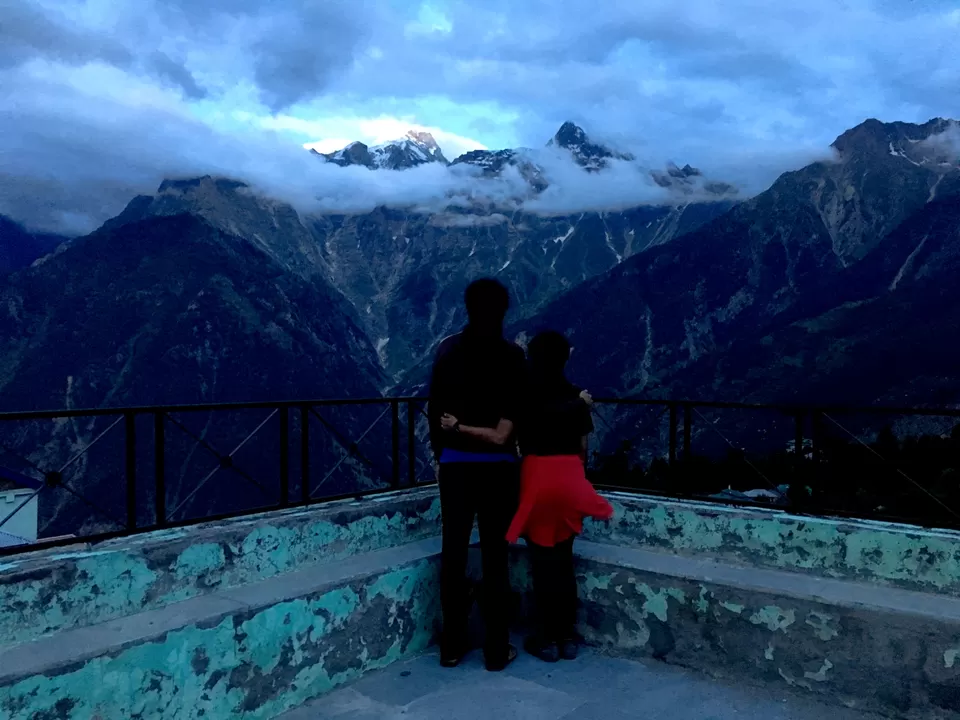
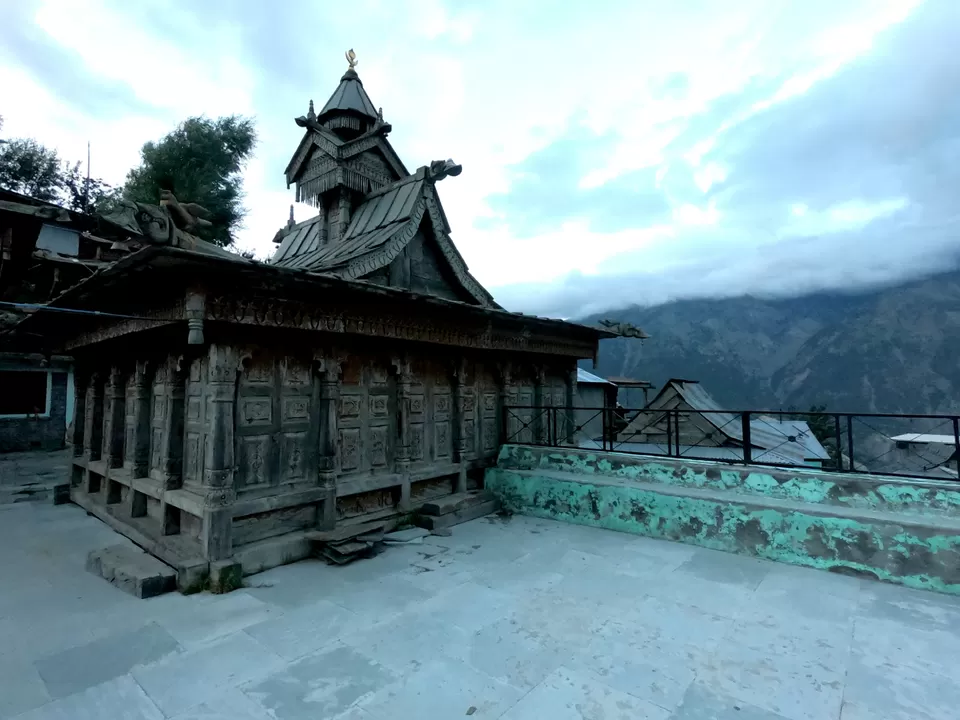
Day 3: Kalpa-Reckong Peo-Tabo
We left early in the morning from Kalpa towards Reckong Peo in the same bus which brought us to Kalpa. At Reckong Peo, we purchased tickets for Tabo. Ladies, please note that there are concessions on ticket costs for women. At the bus stop itself, reservations can be made for seats on the bus. The bus left for Tabo at 9 AM. At this point, we met another fellow traveller Aditya. The bus route to Tabo was also very rocky and above all else, dusty, because of rock falls and dynamite clearance for road building. A majority of the route was hot and sunny. So, for a major part of the journey, we kept the windows up and used a shirt as a curtain for the windows. The route had many bridges over the gushing and frothing Sutlej.
The road to Tabo passes through another hamlet called Nako which is known for its lake. While our initial plans included stay in Nako, we decided to move on towards Tabo. However, we got some gorgeous shots when the bus stopped for a brief lunch.
From Nako, we had the most breathtaking experience the second we entered Spiti Valley. There are very few things which make me go silent. The landscape in Spiti is one of those. I went silent and there is not really any other way to appreciate the beauty of Spiti. Huge, majestic mountains stood sentinel around the valley where the Spiti River wound its way. The mountains had all shades and mixtures of brown and green possible and were all striated at the exact same angle forming parallel lines. We reached Tabo a little over 3 PM. I don’t think I have felt so peaceful in a place. I am not kidding when I say that the mountains stood guarding the entire valley. The landscape was open for miles but closed by mountains on all sides giving a very very disorienting sense of not knowing whether I am in a closed space or an open space. On one particular mountain, a mantra (Om Mani Padme Hum) was painted.
We started walking towards the main areas of Tabo asking each homestay that we passed on the way for costs. We soon realised that it would be best for us to find dormitories in Tabo monastery. So, Tabo has two monasteries. The first is the oldest Buddhist monastery in India and built-in 996 A.D. It was overwhelming to be in the presence of such an old structure. The second one is a newer monastery, probably built in the last 10 years or so. The monastery was attached to dormitories. The dormitories were fairly clean and had a common bathroom. We paid about INR 350 for the night.
After freshening up, we decided to go around Tabo. We first went to the old monastery. As we were already delayed, the monastery was closed. However, we were able to walk around the complex and admire the architecture. We then walked towards the new monastery. The new monastery had a huge stupa resting on a platform surrounded entirely by prayer wheels. I have gone around spinning the prayer wheels innumerable times. The main monastery building was open till late that day because of visit from a minister. We were able to explore within the monastery. Outside the monastery, we spoke to a monk who pointed us towards a stupa and meditation caves in the mountains and guided us on how to go there. As it was late, we decided to just chill at the new monastery.
During the time when we were sitting and chatting on the monastery steps, two kids came running up to us. They were naughty and kept trying to tease us. The girl was especially mischievous – running and jumping around like a little monkey. After the minister’s visit, we were offered some local salted Butter Tea. It was not my cup of tea. However, it is worth a try.
After freshening up, we decided to go around Tabo. We first went to the old monastery. As we were already delayed, the monastery was closed. However, we were able to walk around the complex and admire the architecture. We then walked towards the new monastery. The new monastery had a huge stupa resting on a platform surrounded entirely by prayer wheels. I have gone around spinning the prayer wheels innumerable times. The main monastery building was open till late that day because of visit from a minister. We were able to explore within the monastery. Outside the monastery, we spoke to a monk who pointed us towards a stupa and meditation caves in the mountains and guided us on how to go there. As it was late, we decided to just chill at the new monastery.
During the time when we were sitting and chatting on the monastery steps, two kids came running up to us. They were naughty and kept trying to tease us. The girl was especially mischievous – running and jumping around like a little monkey. After the minister’s visit, we were offered some local salted Butter Tea. It was not my cup of tea. However, it is worth a try.
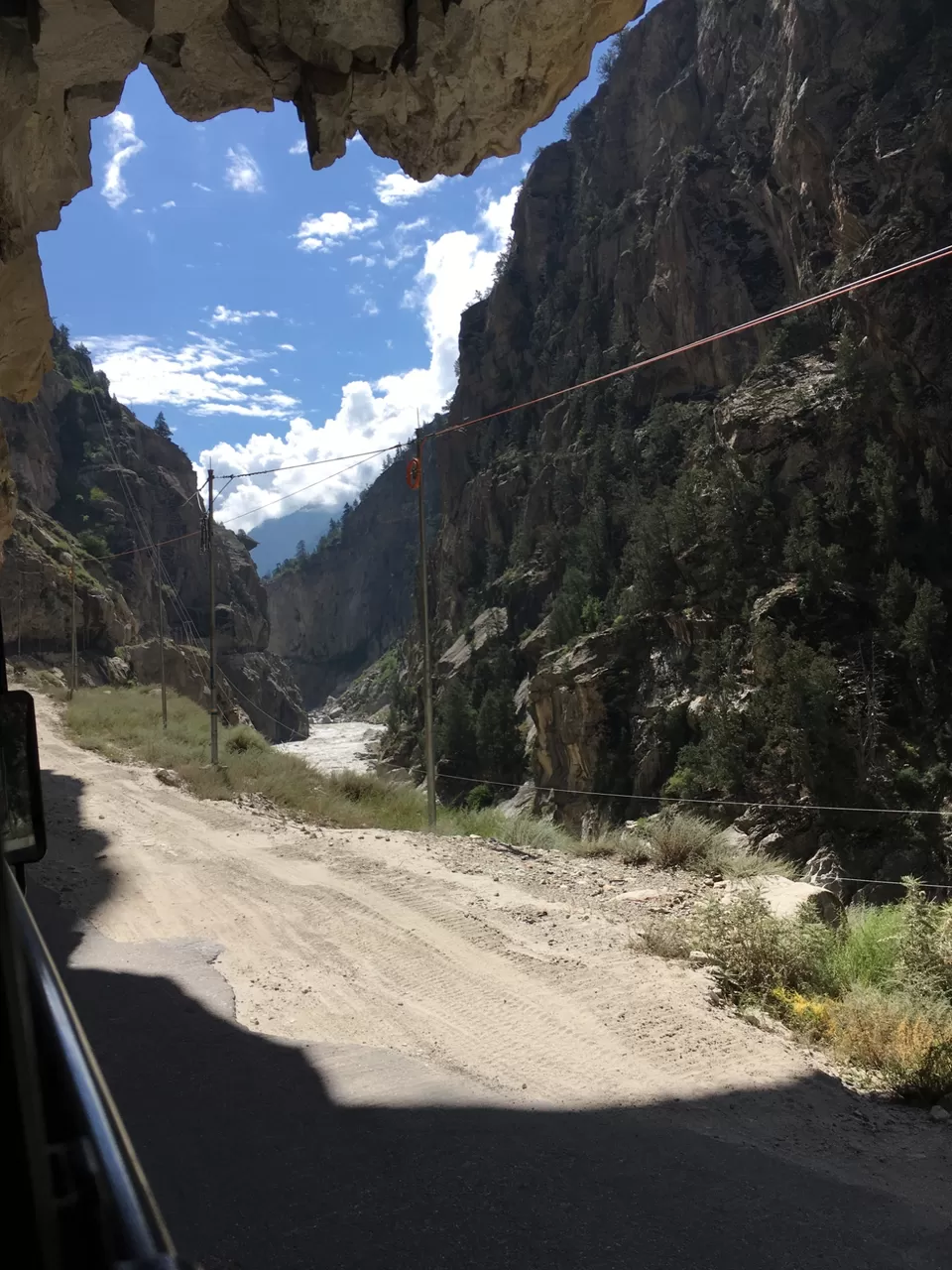
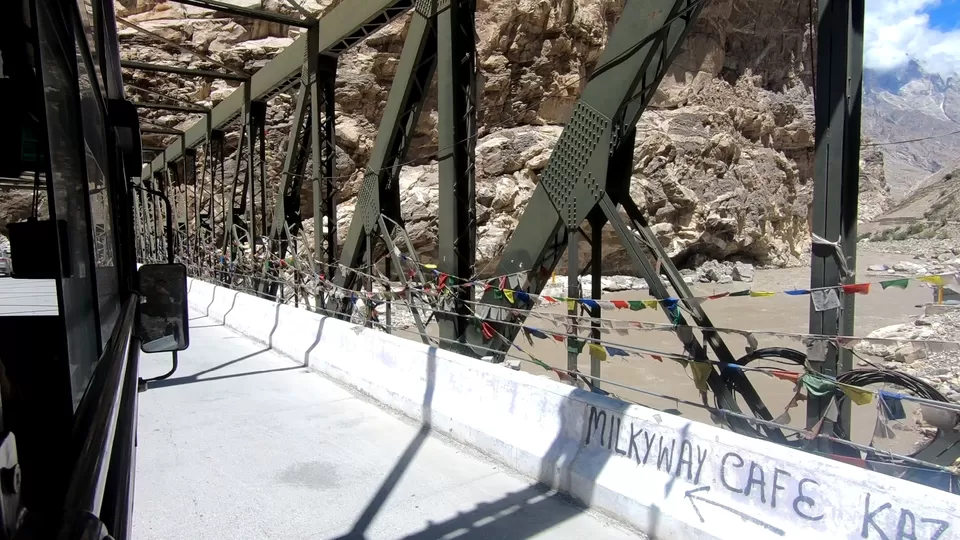
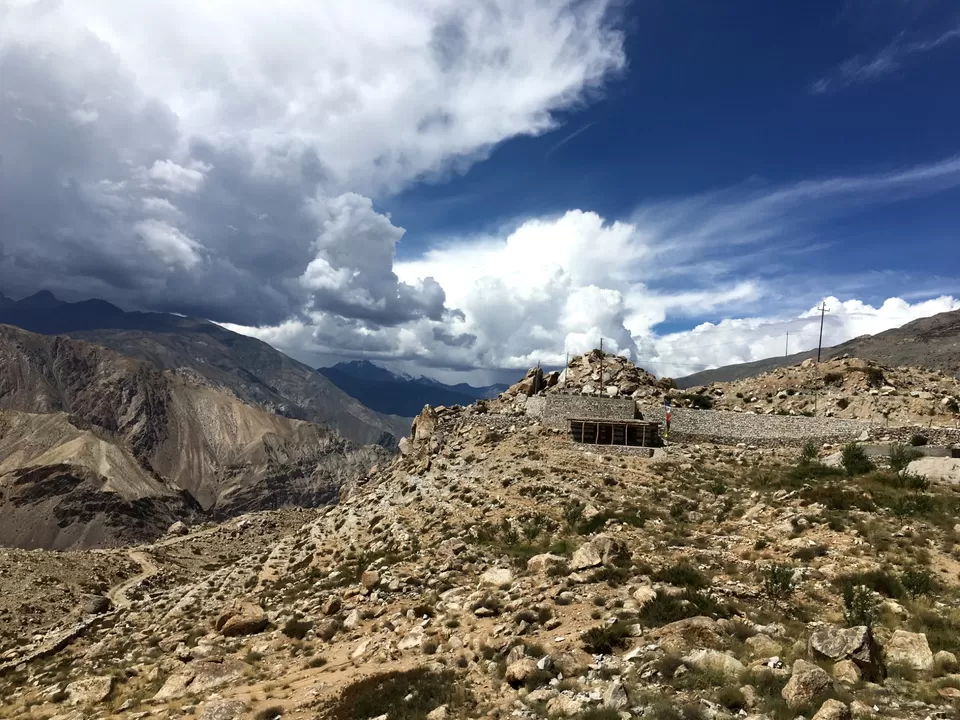
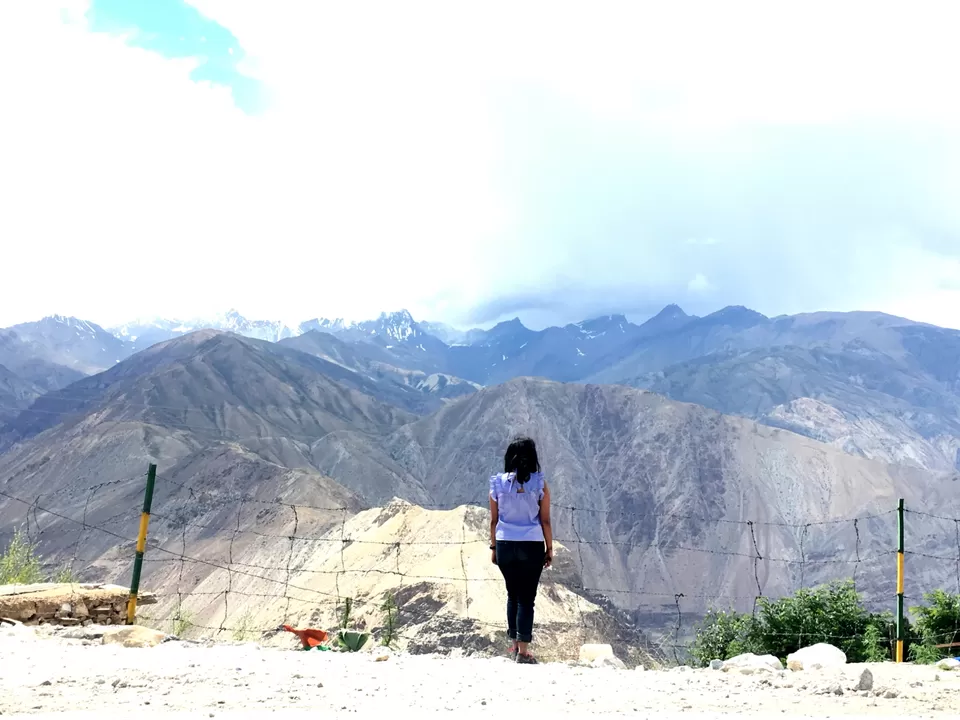
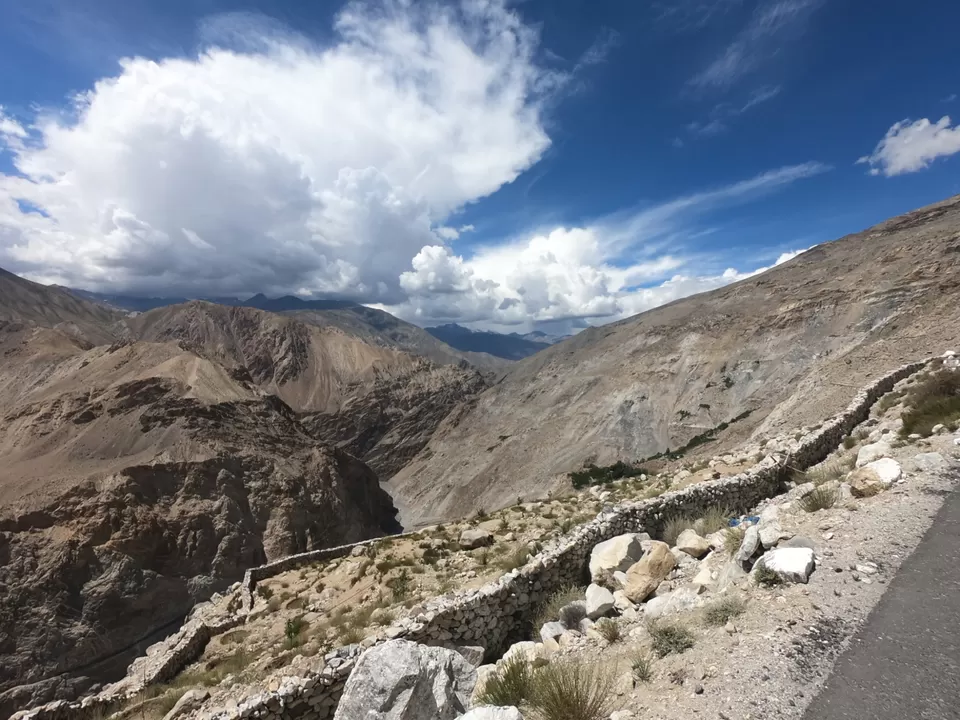
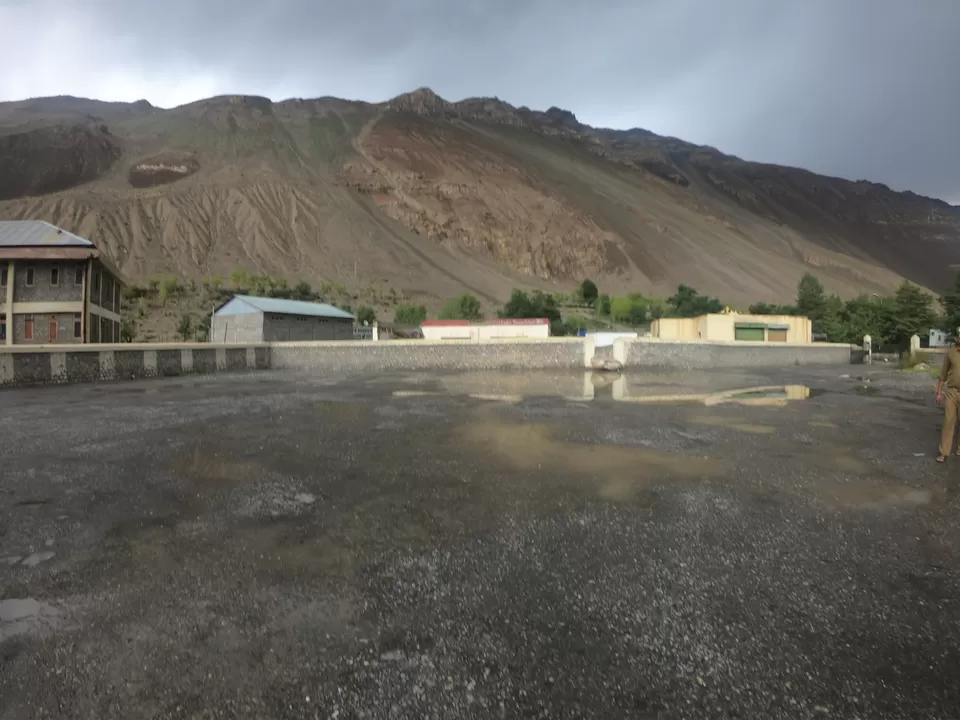
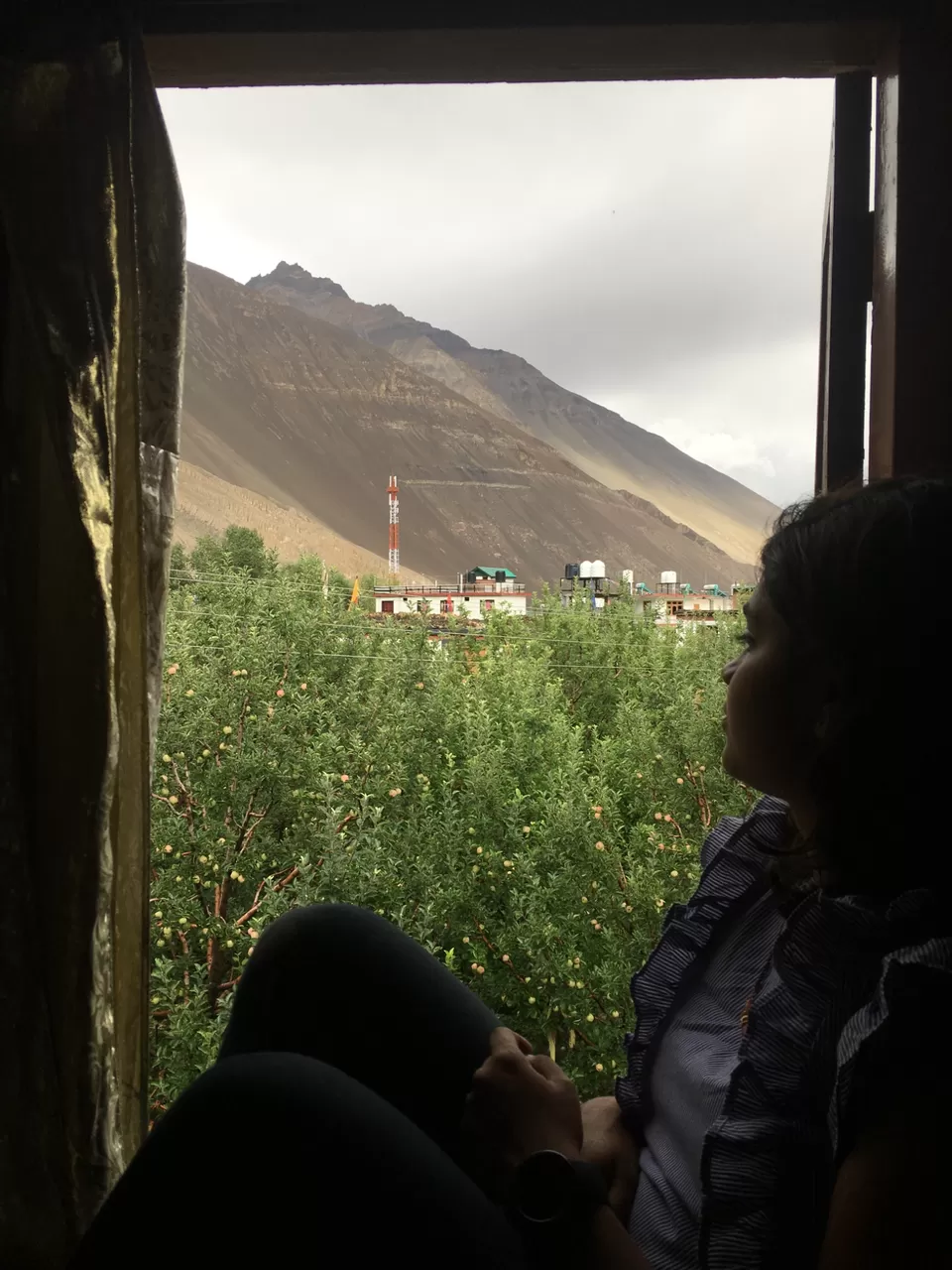
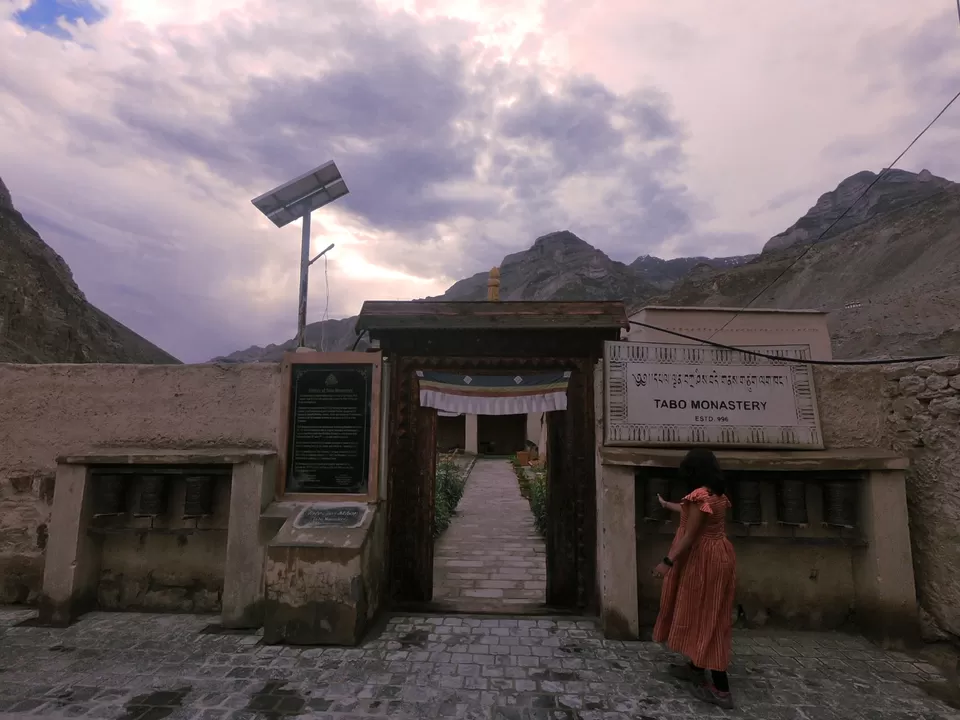
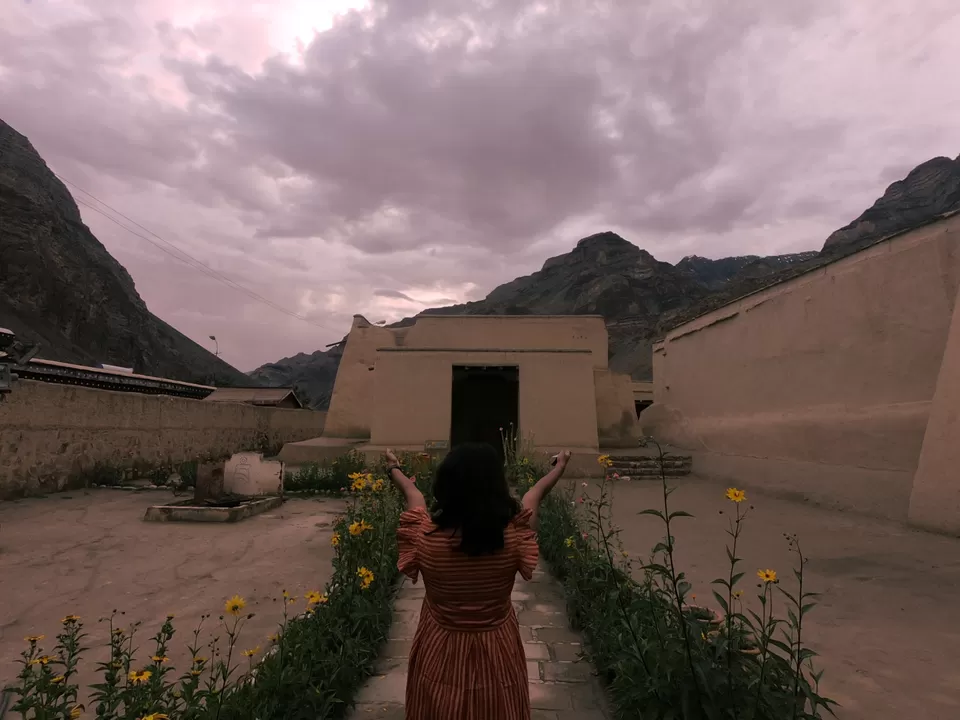
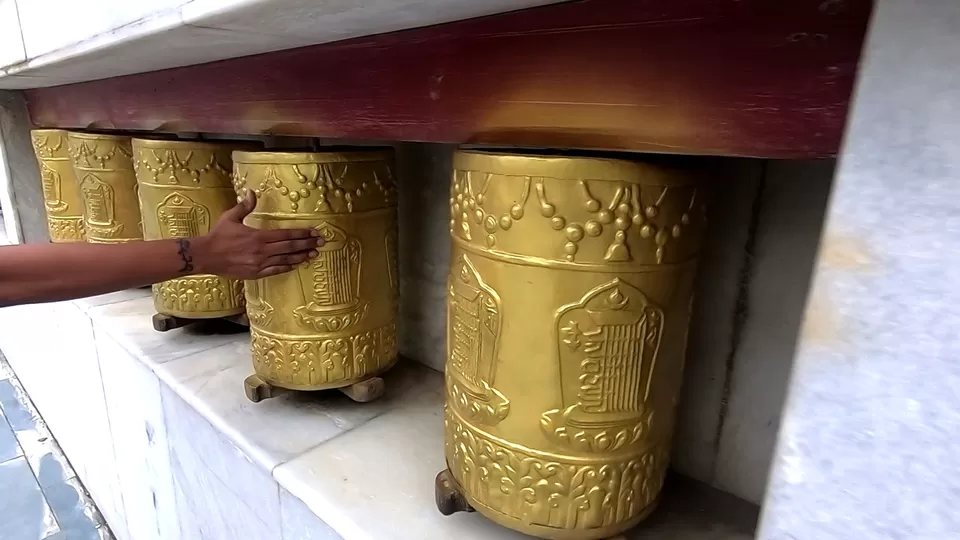
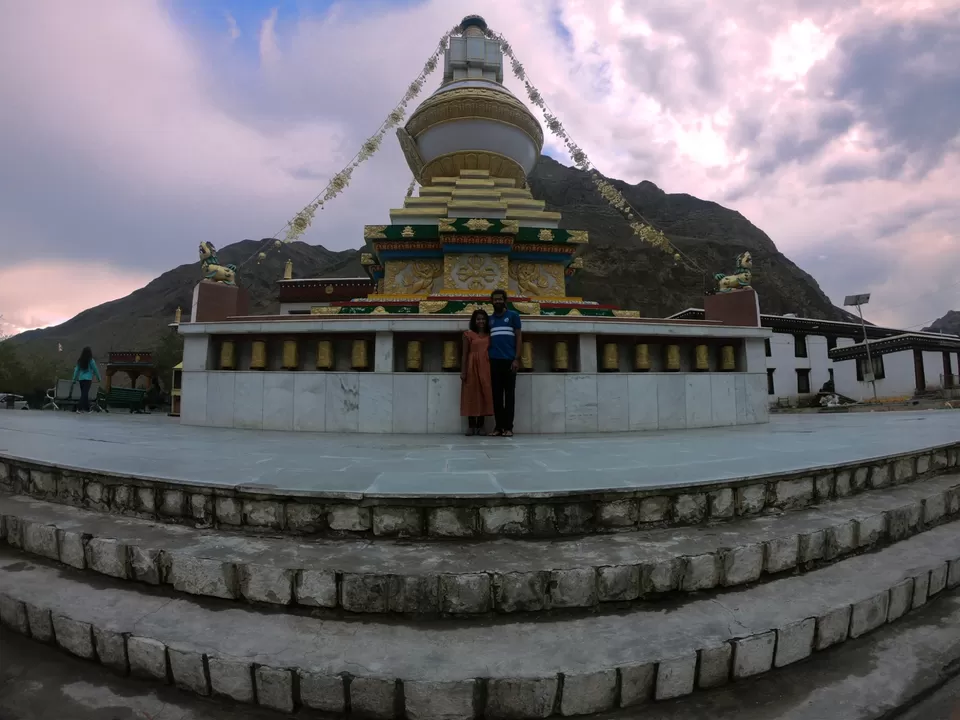
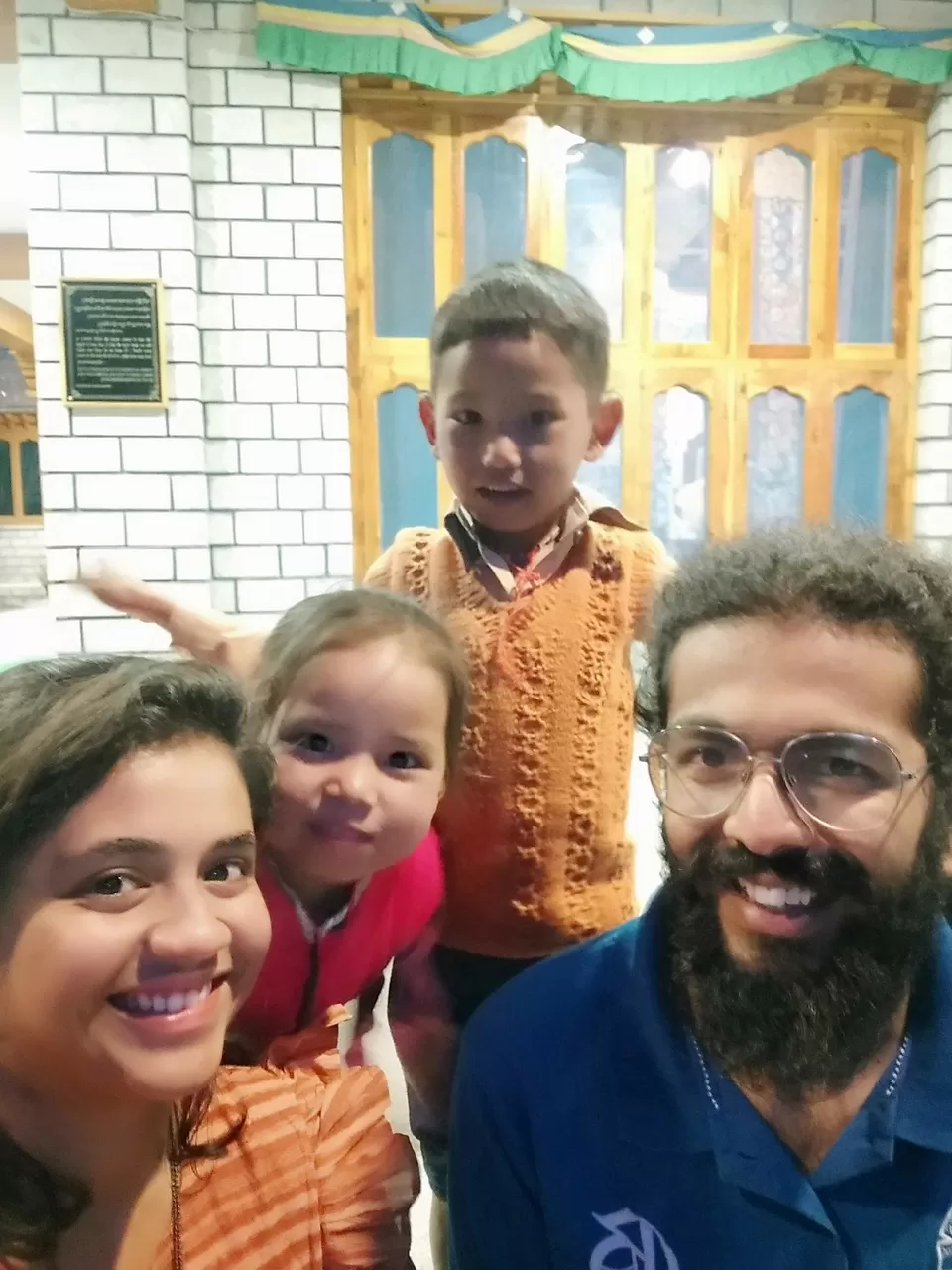
Day 4: Tabo-Dhankar
After a Tsampa breakfast in Cafe Kunzom Top, we hiked to the meditation caves which was pointed to us on the previous day by the monk. We were a little annoyed to see that previous tourists had littered around the meditation caves. We request people to please not litter and, in fact, to try and leave the place a little cleaner than how you found it. From the meditation caves, we were able to see the entire Tabo hamlet including the old and the new monastery and the Spiti river winding through the valley. The meditation caves had trails all around them.
Adventurous as always, we decided to try a few of the trails. The first trail we tried was towards the mantra painted on the mountain face. We went for a bit and realised the trail was a bit too steep. So, we returned back to the meditation caves. We tried another trail to get to a stupa on the mountain which we had seen from the new monastery. However, no matter in which direction or which trail we took, the stupa kept evading us. After a few tries, we gave up. Since we had not been able to visit the old monastery on the previous day, we went there next.
The old monastery has many temples together which form the monastery complex. The main temple welcomed us with a big board which said “Julley!” and asked us to deposit our camera and phones with a guardian outside the building and for good reason. We only had a torch with us as we entered. The entire place was dark but the painting on the walls gave us goosebumps. I will reiterate the fact that this is the oldest monastery in India. It was nothing short of overwhelming to be there. The main building had three rooms: a first low ceiling entry hall (Go Khang), an antechamber and a main prayer room (Du Khang). Each one was painted with stories of Buddha, teachings, depictions of good and bad. The antechamber had statues which at first glance are a little scary but mesmerizing in their own way. The main prayer room was the obvious cherry on the cake.
The walls of the prayer room were dotted with tapestries and paintings of various incarnations of Buddha. Clay busts of gods and demons were provided all along the walls of the prayer room. The prayer room also includes this huge and absolutely spell-binding statue of Buddha resting on a lotus leaf. We spent a long time gaping at the gentle flicker of diya light on the statue. Once we had our fill of the main temple, we walked to the other temples, namely, Ser Khang or the Golden Temple. The paintings within the temple were being restored. We actually saw a live restoration and spoke to the art conservators.
We then had a quick lunch and decided to move to Dhankar. The bus was delayed. We tried to hitch a ride to Dhankar but eventually we ended up taking the bus. Note: The bus goes from Tabo to Kaza and not to Dhankar. To reach Dhankar, you have to get off at Sichling and either hitchhike or trek towards Dhankar. We did the former. On reaching Sichling, we met Animesh with whom we hitched a ride in a tractor to Dhankar. The views of the Spiti River left us gaping. The tractor dropped us midway and we had to trek to Dhankar. But the trek was worth it. We came across this stretch of green bordered by stones carved with mantras. We later came to know that during winter months, when tourism all but stops, the locals, to pass time, carve the mantras on to the stones.
Having not pre-booked a stay, we resorted to staying in a dormitory of a hotel right outside the monastery. We were the only ones there, so it was pretty much like having our own room, anyway. We quickly freshened up and went up to the monastery. The Dhankar monastery is built on a spur which overlooks the confluence of the Spiti River and Pin River. It is a thing of wonder, really. Within the monastery, on the first level, there is a tiny door through which you can get onto a ledge. There are no barricades and it is a sheer, sheer drop. But the view is actually worth dying for. It really shows how insignificant we are in the grand scheme of things.
Tired as we were, we treated ourselves to more Tsampa delights and called it a night.
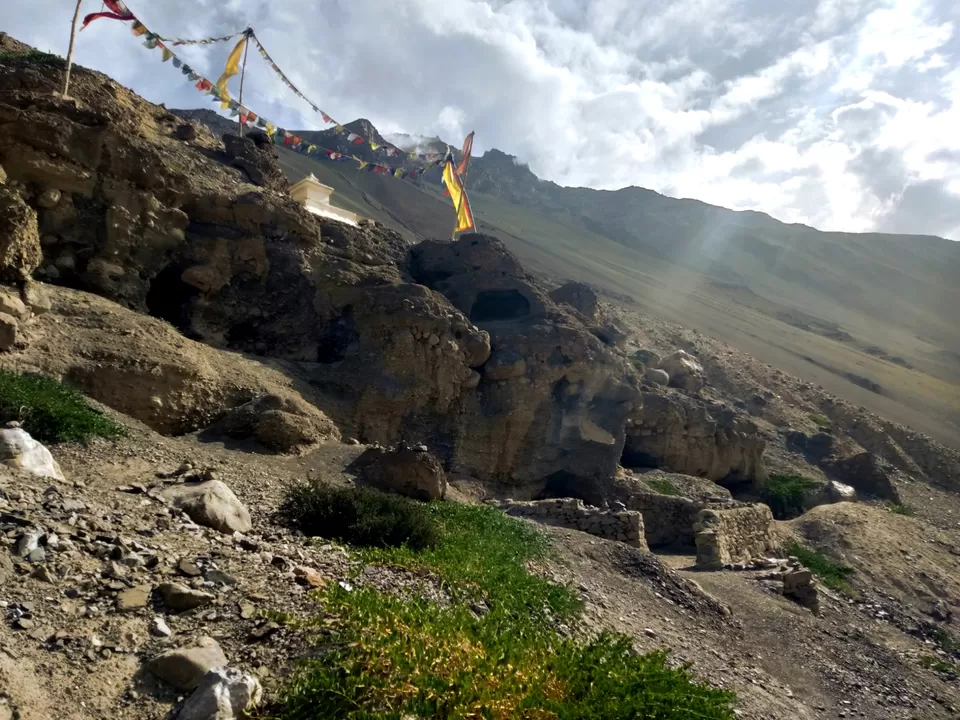
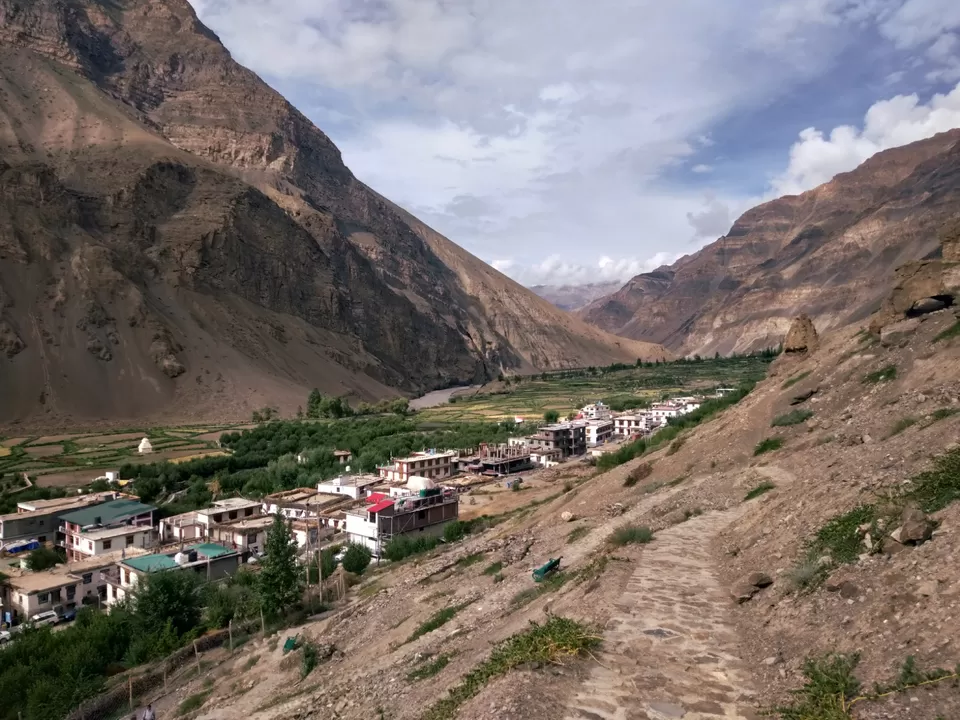
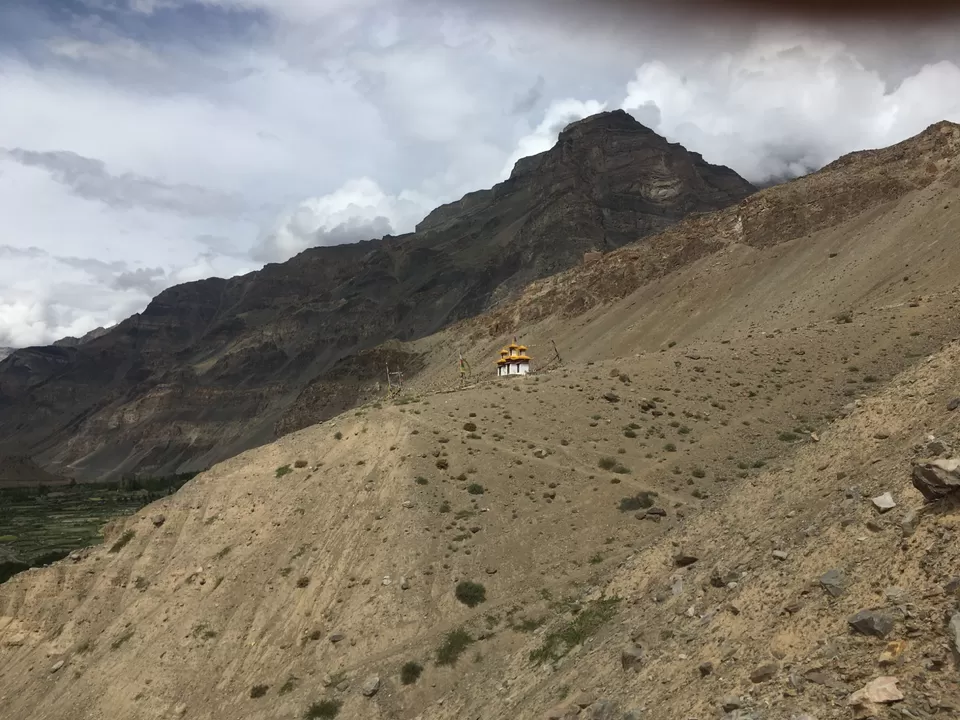
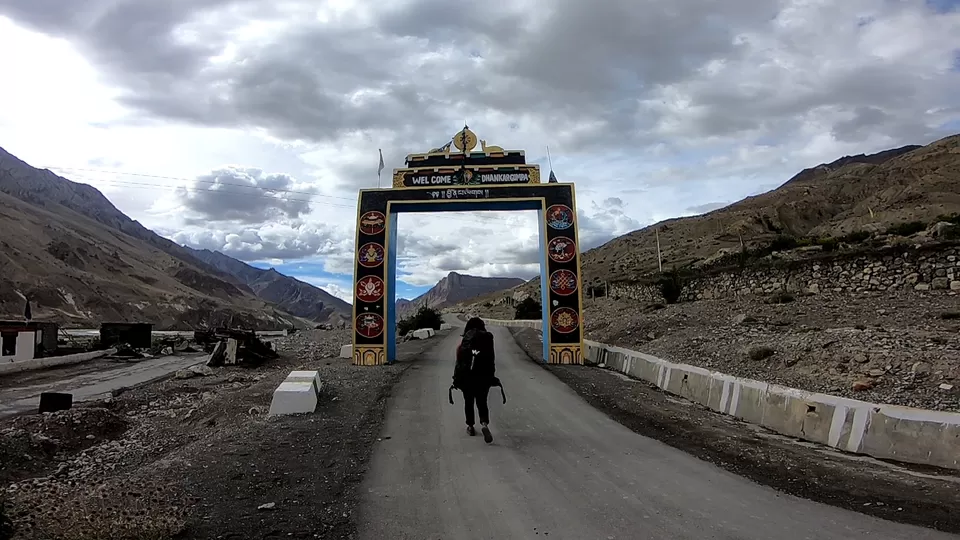
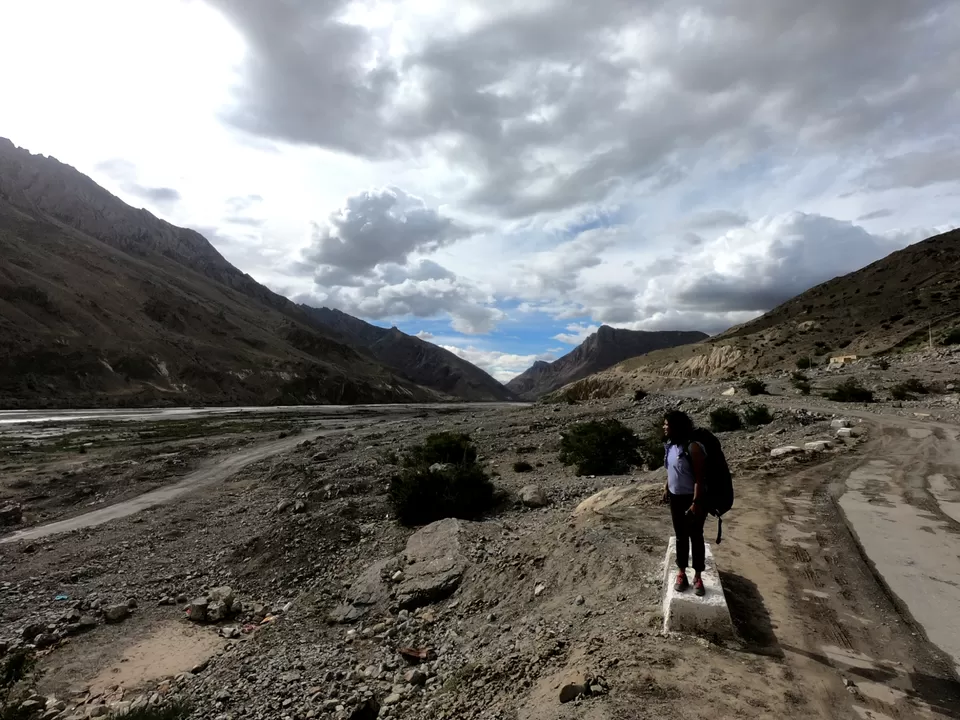
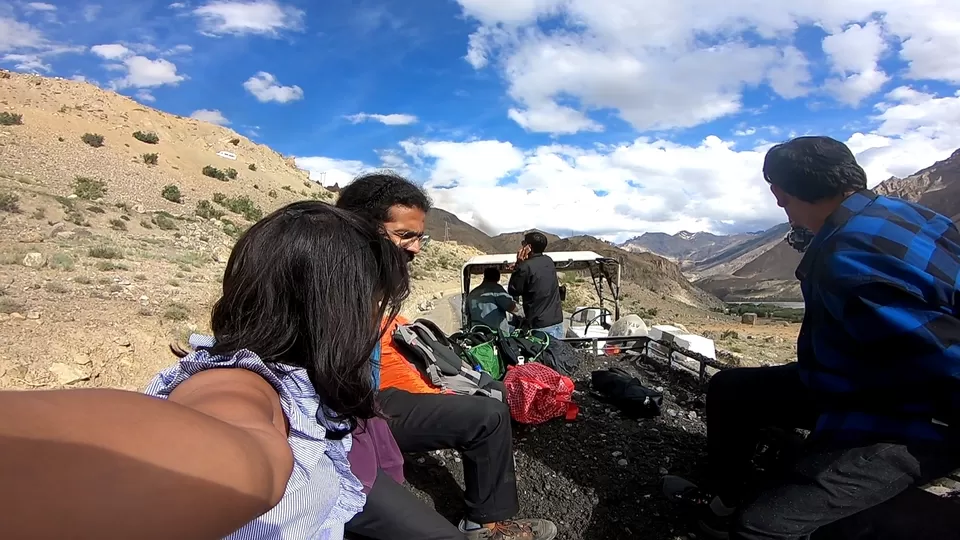
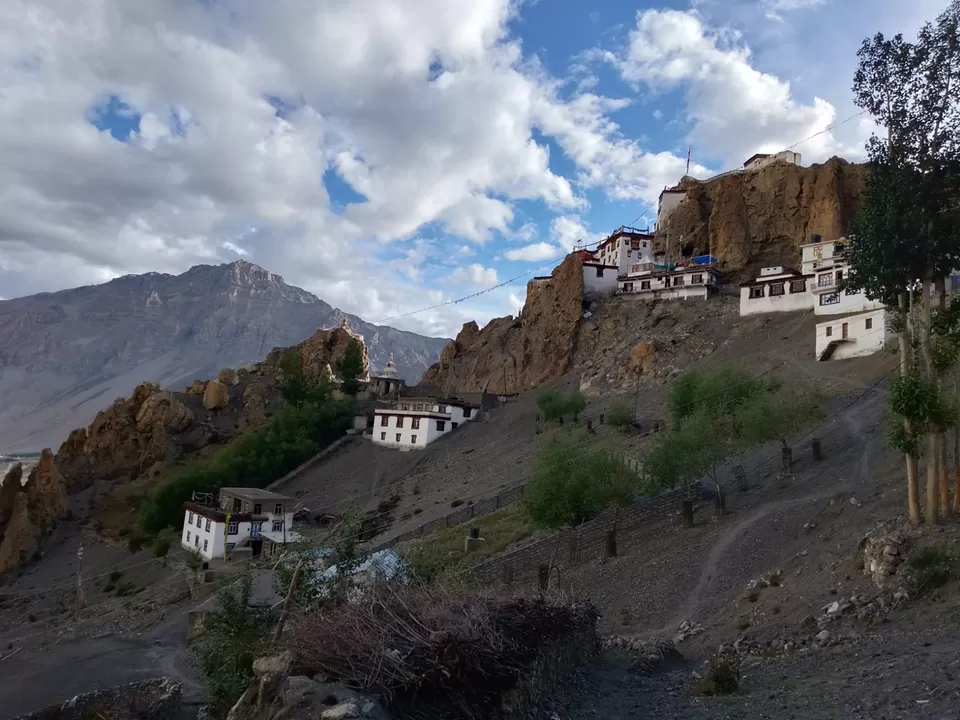
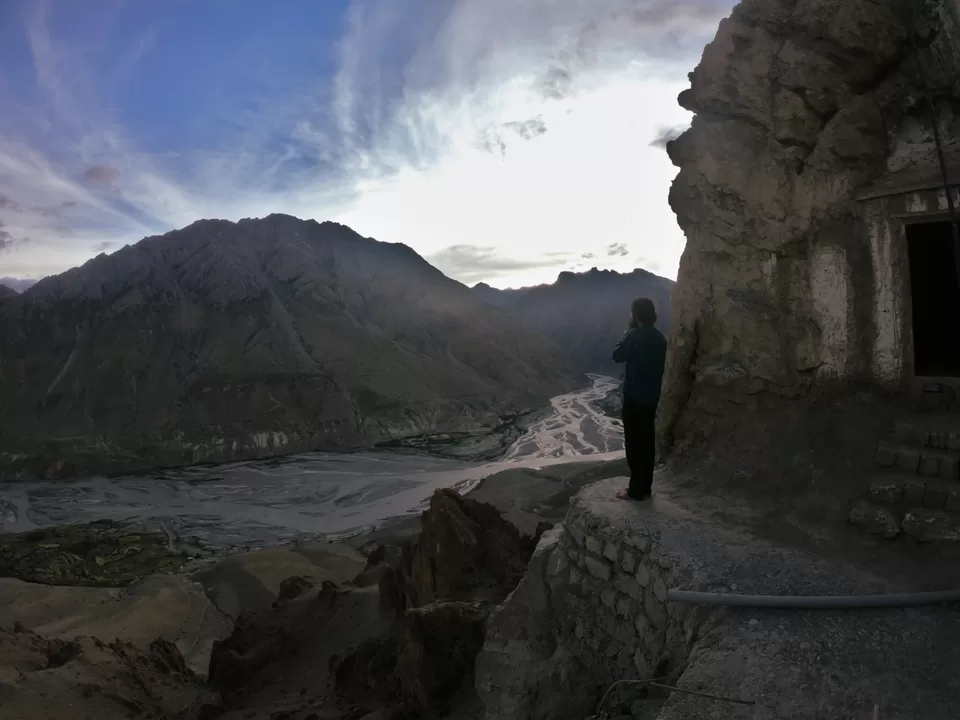
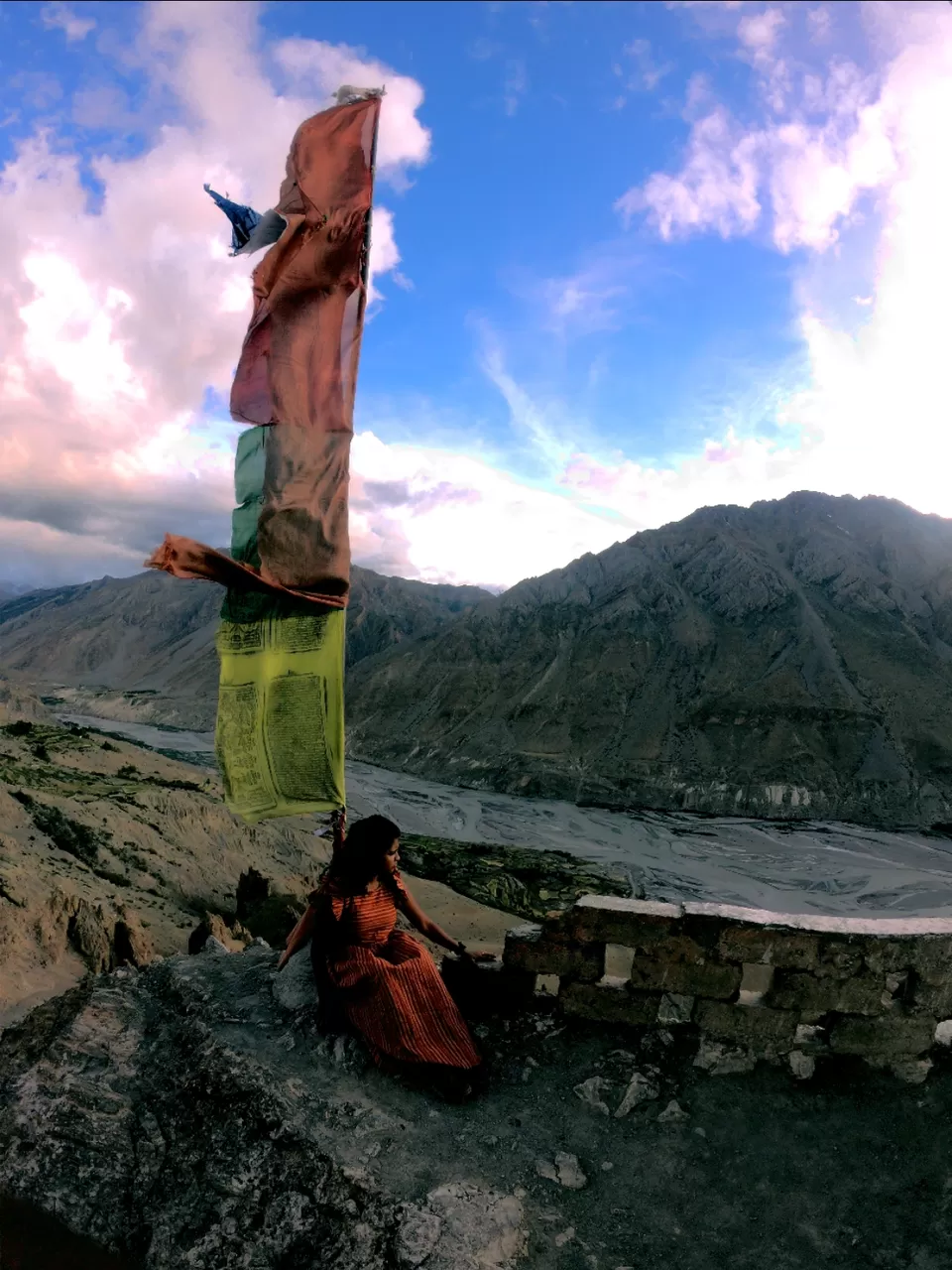
Day 5: Dhankar – Kaza
Dhankar, other than its monastery, is also known for Dhankar lake. To avoid being scalded by the sun, we left really early on our hike to the lake. The route was good. However, we were a little disappointed, as the lake was almost dry. But we got some gorgeous reflection photos (Can you spot the lake in the picture?). There was also this really pretty stupa next to the lake. Since we did not have very much to do on the lake, we hiked a little higher on the surrounding mountains. And, even though the lake disappointed us, snow-capped mountains did not.
We hiked back to our dormitory, packed, and had a really quick Tsampa porridge breakfast. During breakfast, we met Arron, a teacher and an artist from Australia. He was working on an art piece and we got to talking. The caretaker and cook of the hotel we stayed in made arrangements for us to reach Kaza with one of his friends who was riding his pick-up truck to Kaza. Daman and I decided without even consulting each other to ride in the open truck instead of within the cozy warmth of the cabin. We had the most amazing time getting bumped around while it drizzled lightly!
We reached around noon to Kaza. Having spent our time in places with very less people, Kaza came as a little bit of a shock to us. Kaza is quite a commercial place with a load of cafes and restaurants. We went to this cafe called The Himalayan Cafe – a quaint little place with amazing food. We then went about looking for a place to stay. We finally decided on Kunzum Spiti Inn which was about INR 1000/- per night.
We then rented out a Royal Enfield to visit some places close to Kaza – Hikkim, Komic, and Langza. Hikkim is about half an hour from Kaza and has the world’s highest post office in the world from where you can send postcards out to your loved ones. You can buy the postcards there. However, it would be better to buy them in Kaza because by the time we reached there, they were out of postcards.
We then moved to Komic which is the highest motorable village in the world. We request you to not to miss this place. There is a monastery and there is also the world’s highest restaurant as well. But, what takes your breath away are the snow-capped mountains on all sides! What a view! That is why we would totally suggest not missing this place.
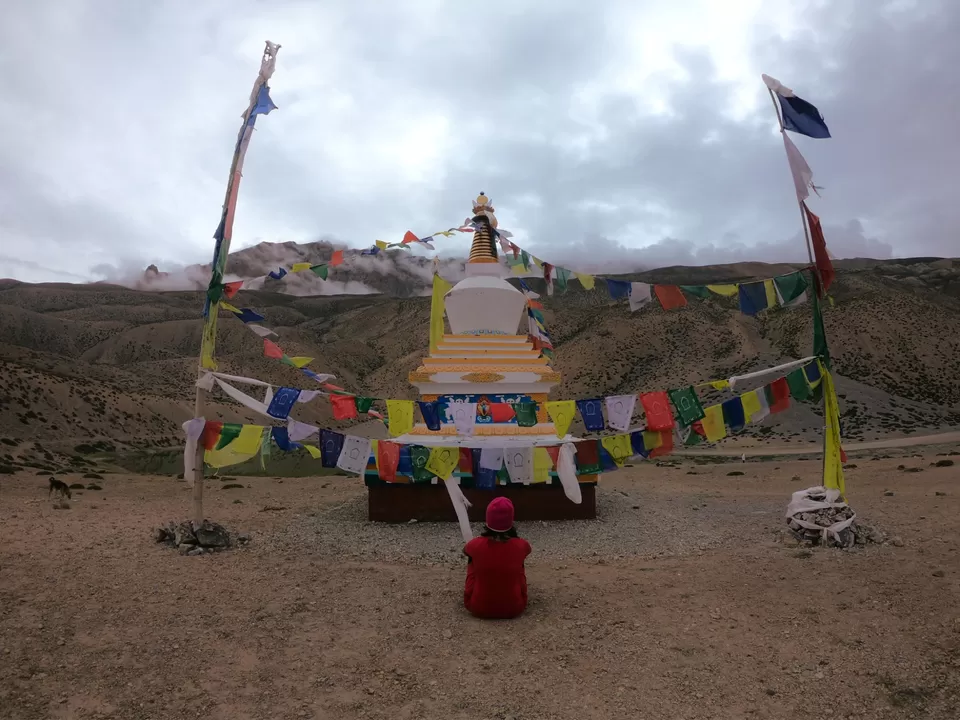
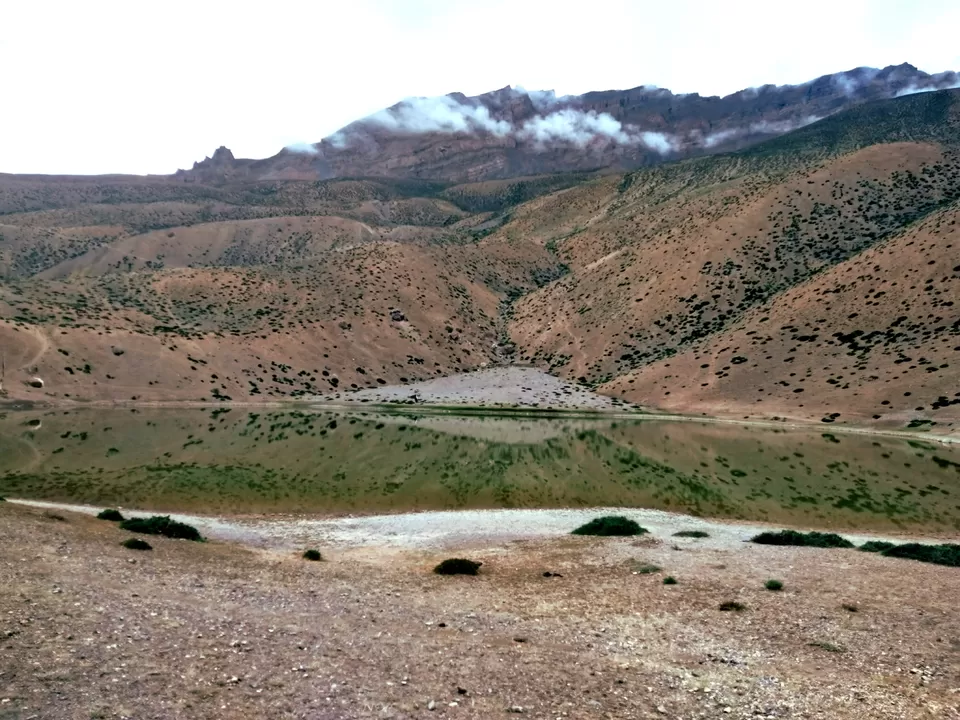
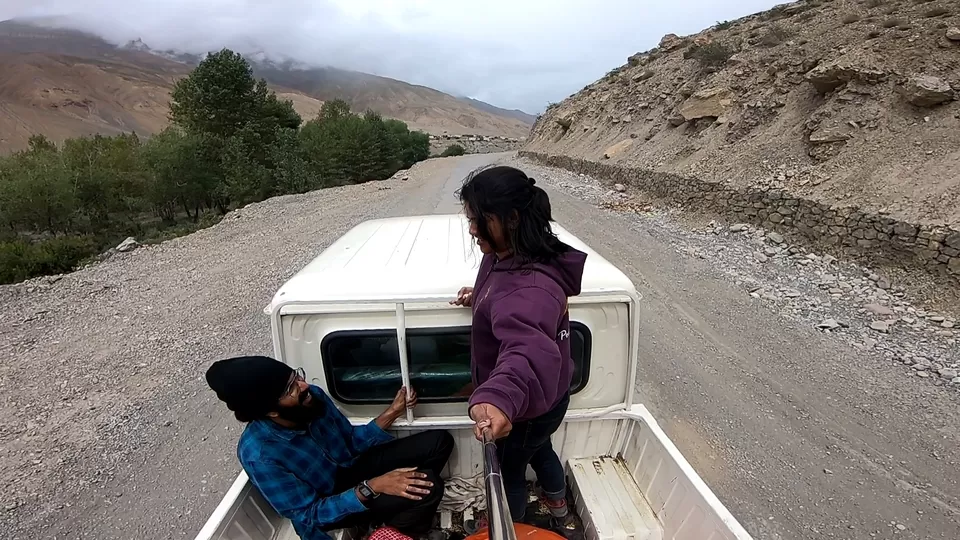
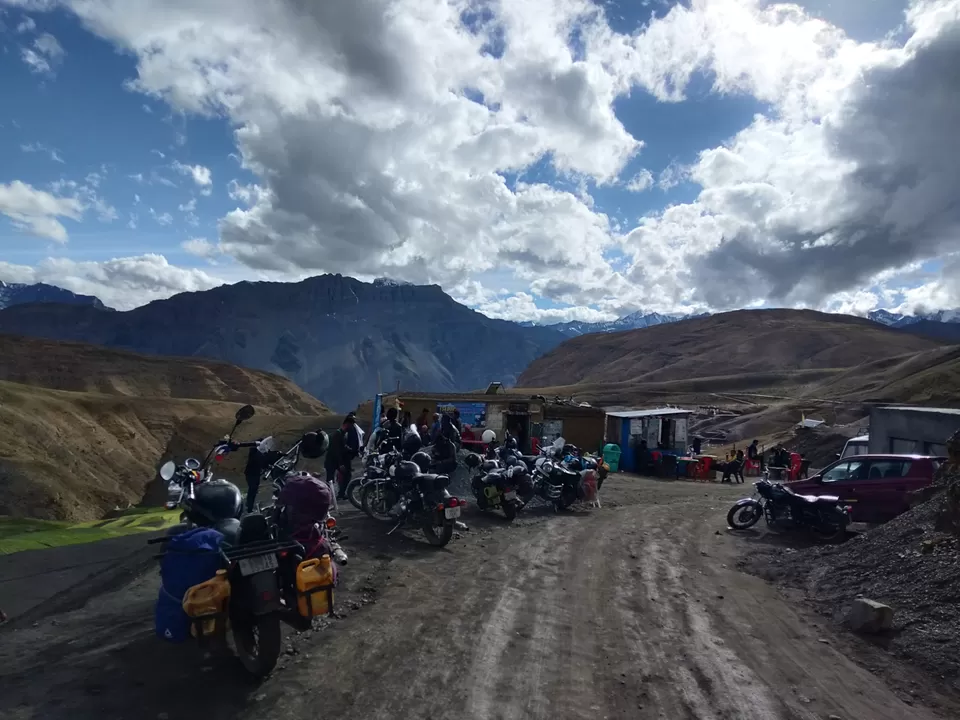
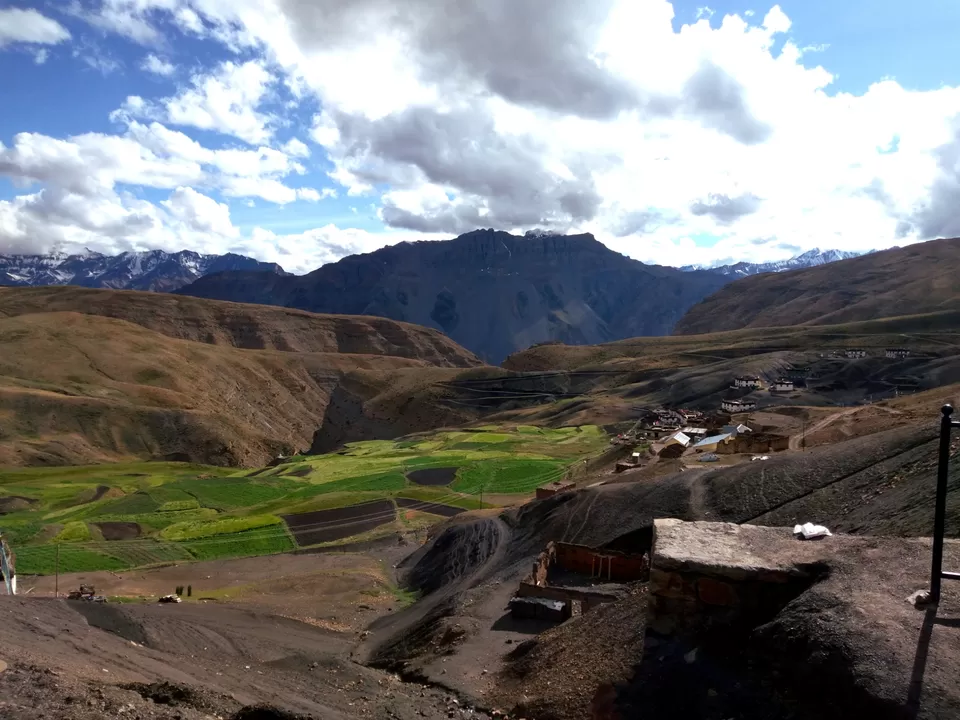
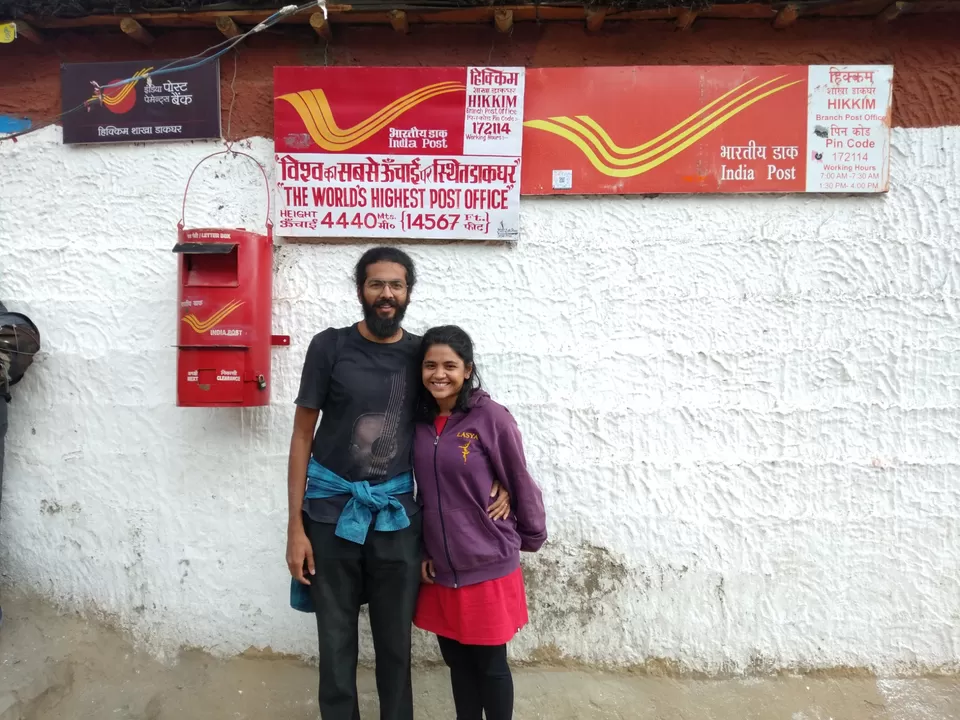
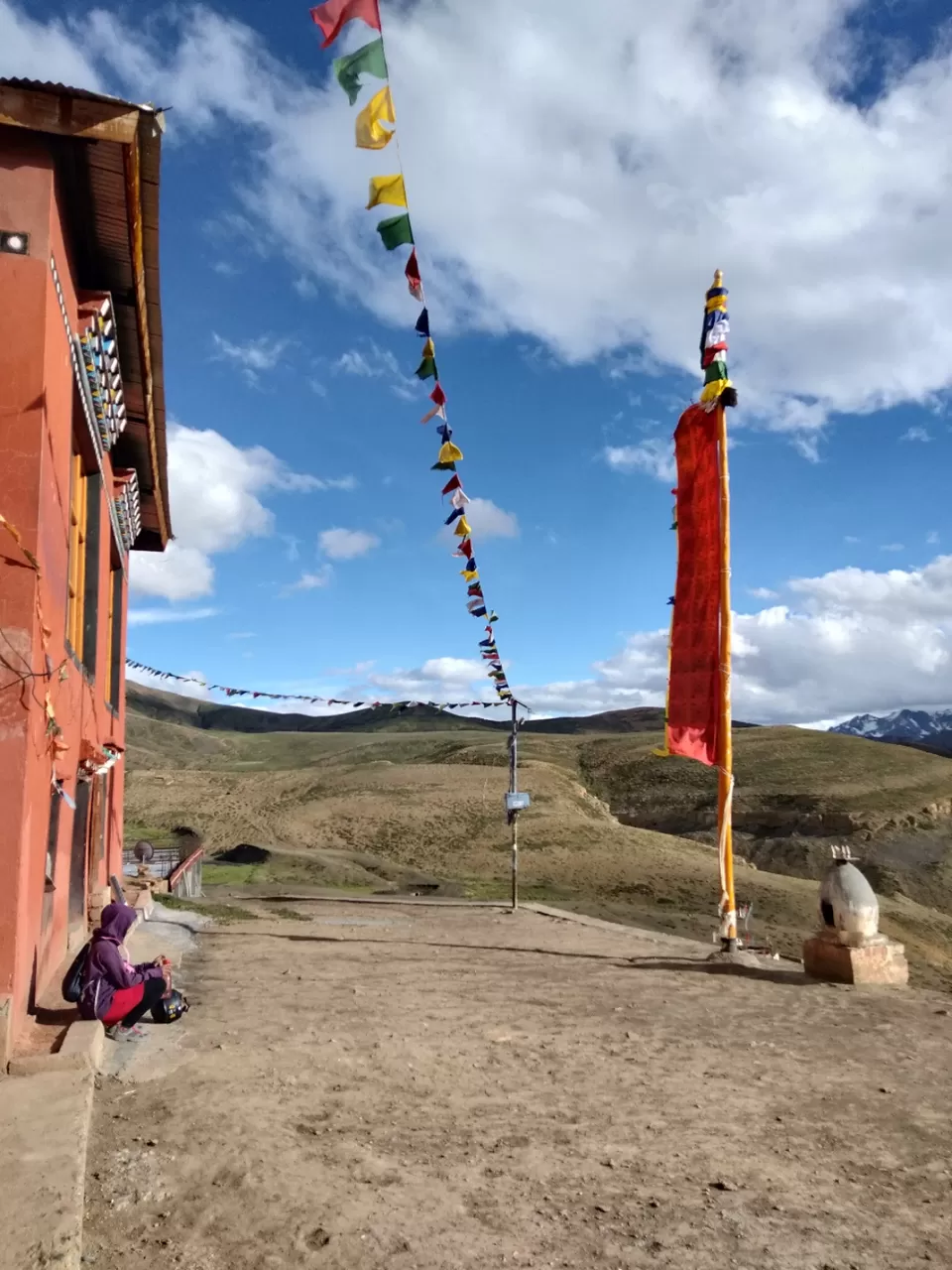
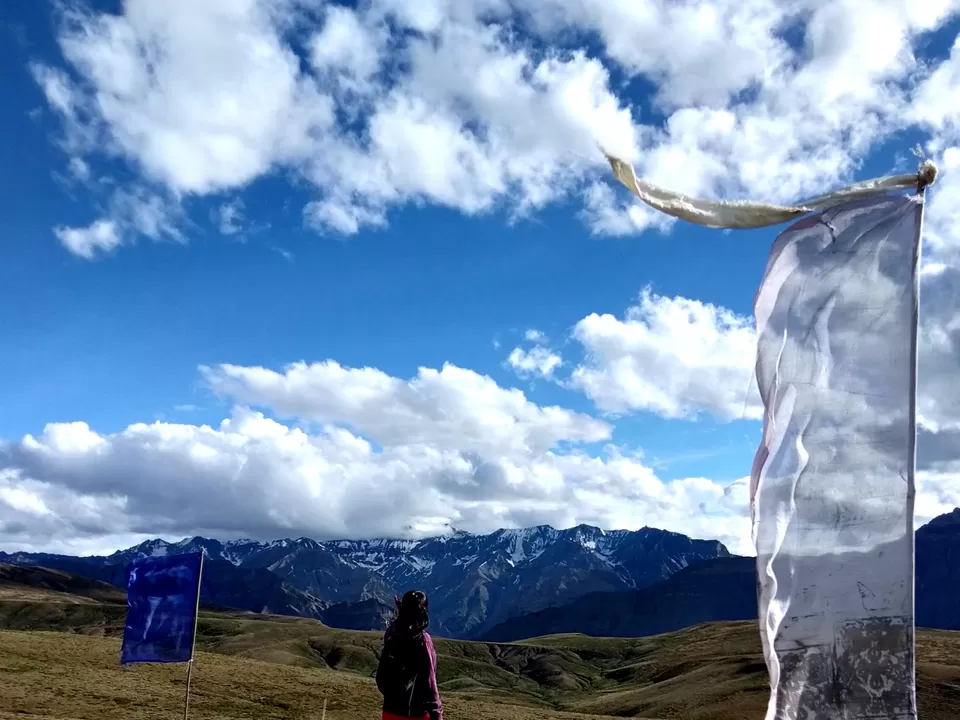
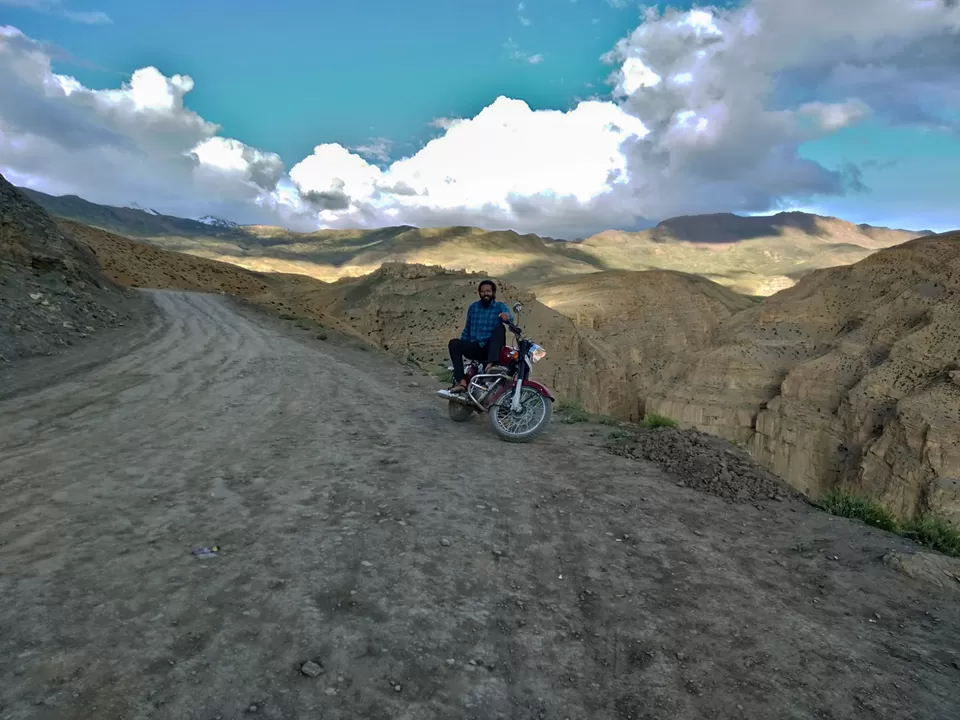
Day 6: Kaza-Rangrik-Kibber-Key-Kaza
We had a quick breakfast at Zangchuk (also one of the few places where you get Wi-Fi) and packed some aloo parathas for the road. We did not rent a vehicle today. Himachal, especially Spiti, is a very traveller friendly place and we decided to hitch hike to Key Monastery. One of the locals that we hitchhiked with told us that a school in Rangrik (which was a detour from Key Monastery route) was having Independence Day celebrations and he would drop us there if we wanted to watch it. As we did not have much planned, we decided to go along with him. At the school, we watched the flag being hoisted by one of the monks from Key Monastery and then we started hiking back towards Key Monastery. After a short walk, we hitched a ride with a person who was going towards Kaza and who dropped us halfway.
Again, we started hiking until we could hitch another ride. This person told us about his life and travels and dropped us close to Key Village. While close to Key Village, we changed our mind and decided that we would instead go to Kibber. We hitched a ride with a tractor carrying silt to go to Kibber. Kibber is another tiny hamlet and has a wildlife sanctuary. We filled up our water bottle at a pump, explored Kibber a little and decided that we would hike to Gete Village and climb down towards Key Monastery. We started off but soon the altitude started wearing us down and we decided against it. We turned and decided to hike back to Key Monastery. Mercifully, another person who was on the way to Key Monastery dropped us almost to the doorstep.
At Key Monastery, we sat on the steps and ate the aloo paratha which we had packed in the morning. Key Monastery is the biggest monastery in Spiti Valley and is a training center for Lamas. The Monastery is a beautiful structure perched atop a hill with the Spiti River flowing beside it. It was a very very very humbling experience for us. The monks in Key Monastery are some of the nicest people we met. They offered us tea and answered every question that we had on every painting and every depiction on the walls of the temples and rooms in the monastery. At Key Monastery while we were leaving, we also had the privilege of meeting Key Monastery’s current spiritual leader Lochen Tulku, the 19th reincarnation of Losatwa Rinchen Zangpo, the Great Translator wand former abbott who was instrumental in revitalizing Buddhism, translating all the original Sanskrit sutras, and building new monasteries in the 10th-11th centuries.
After exiting Key Monastery, we trekked up a hillock to get the view of Key Monastery as shown in the photo above and below and also to try and capture the sunset behind the monastery. Very soon we were joined by many people. Of this, Vivek was one of the people we met. He is a wedding photographer based out of Bangalore. And it was our lucky day because we not only got to hitch a ride with him to Kaza, he also took some amazing pictures of us.
At Kaza, we again had an early dinner with Vivek at The Traveler’s Shed. We checked out of Kunzum Spiti Inn as we would be leaving really early in the morning to our next destination.
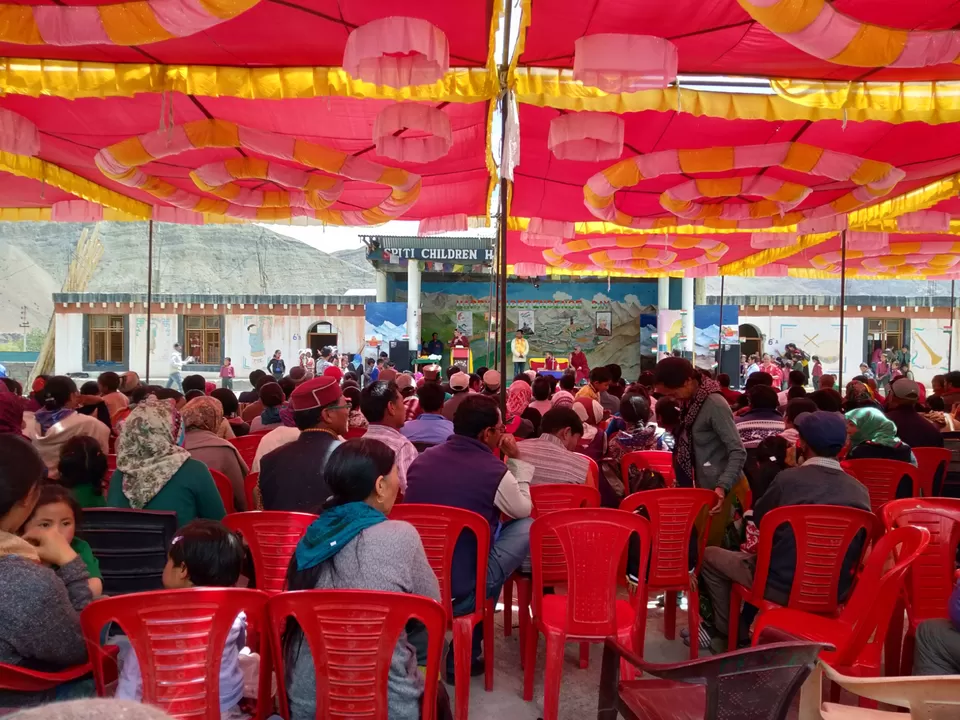
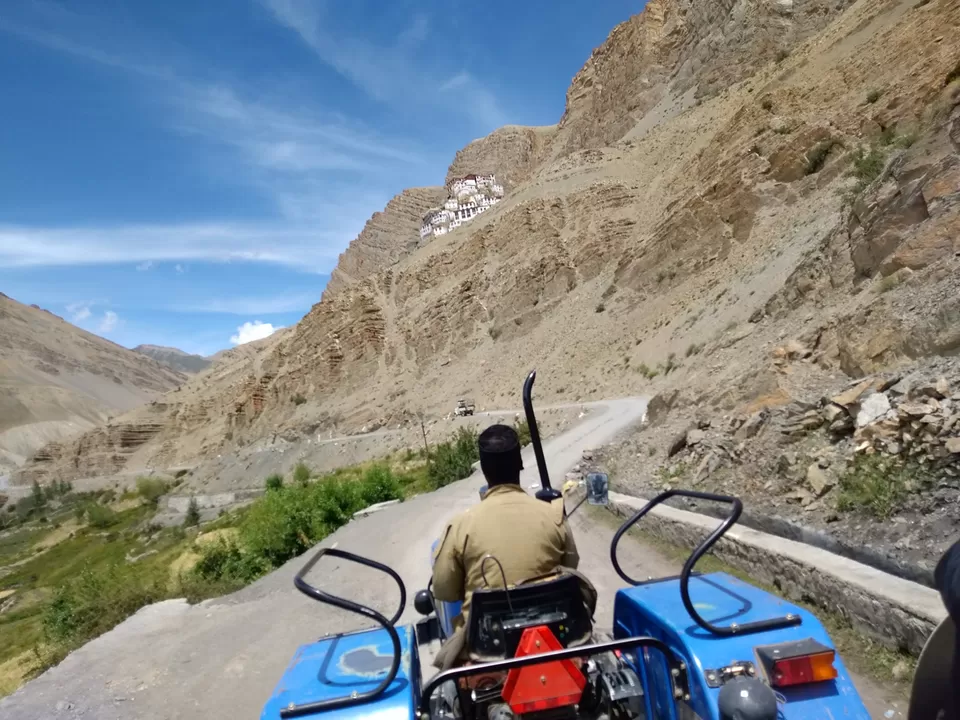
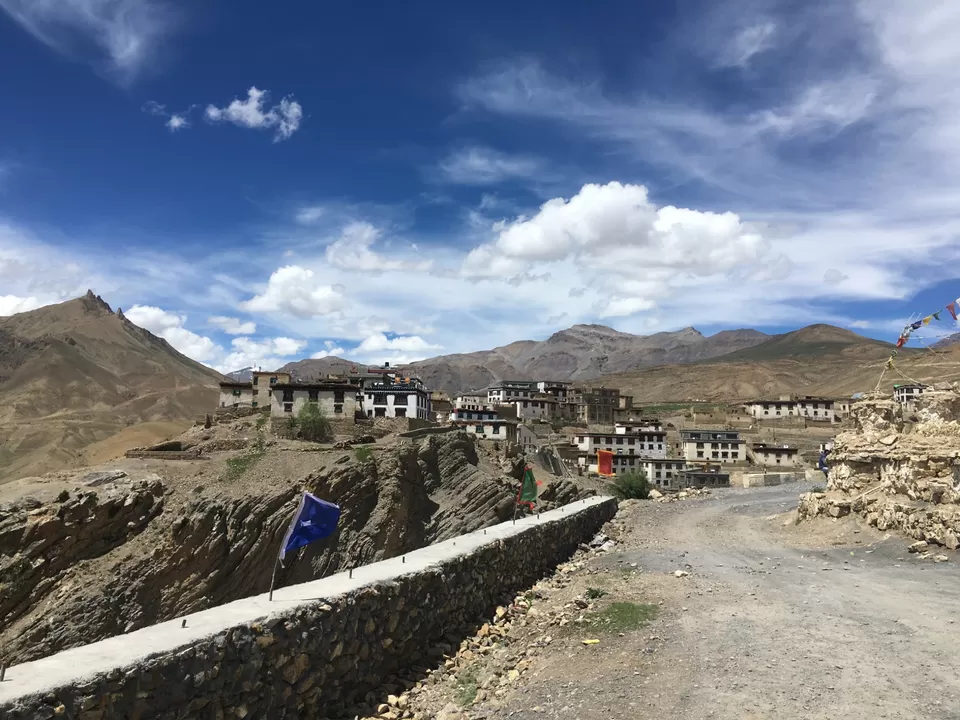
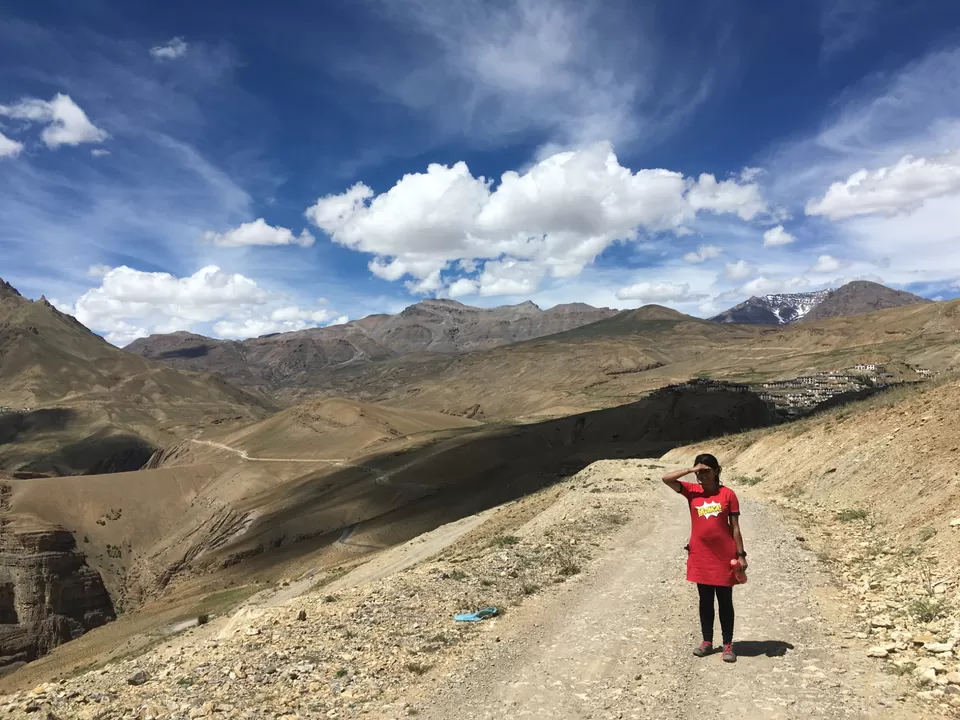
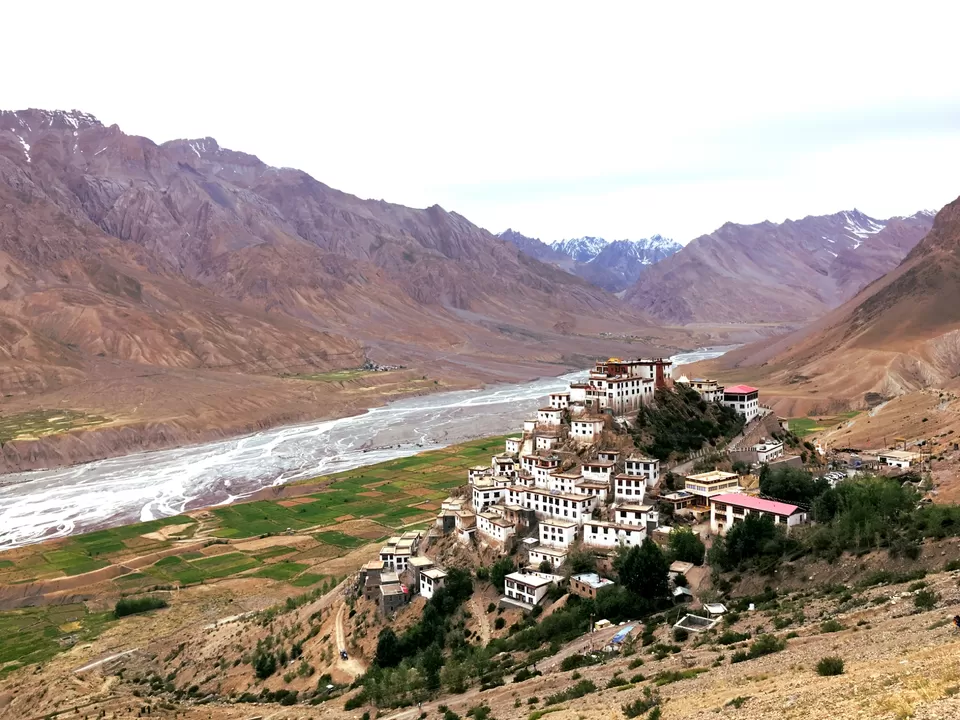
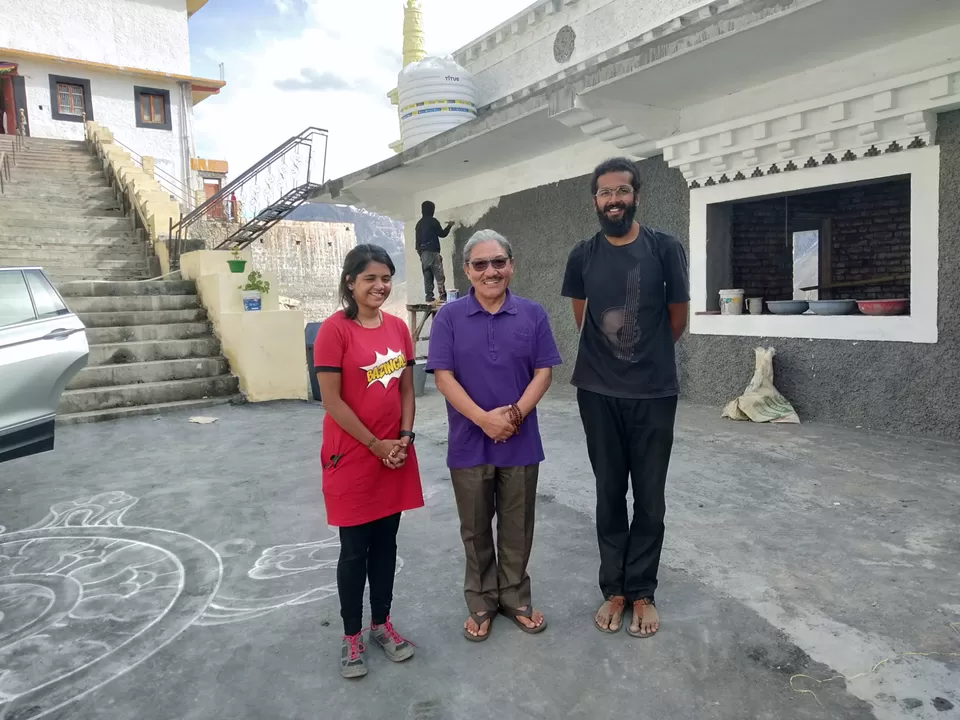
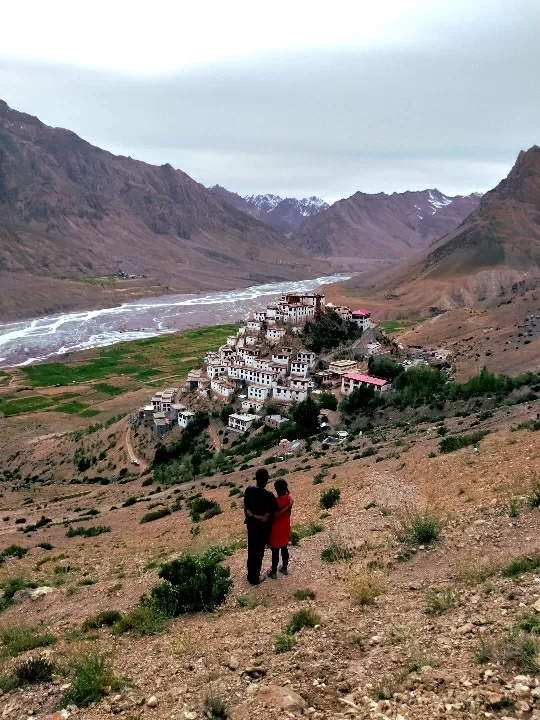
Day 7: Kaza-Kunzum Pass-Chandrataal-Batal
There is a single bus which leaves at 4:15 am from Kaza towards Batal. While most people decide to go all the way to Batal and then hitchhike back to Chandrataal lake, we decided that we would get off at Kunzum Pass and trek towards Chandrataal lake. We got into the bus which was very very crowded because of a mistake made by the conductor. But, generally, we understand that reservations can be made on the bus if you go to the bus stop around 3:30-3:45 am. The route towards Batal was amazing. We saw all kinds of landscapes – mountains to plains and yaks grazing in meadows.
At Kunzum Pass, there is a temple devoted to Kunzum Devi and it is considered auspicious to pray to this deity before continuing on the journey. Kunzum Pass was a serene beauty. The clouds felt so close – like cotton candy that you could just almost touch. The hike from Kunzum top to Chandrataal was a whooping 11 kms and while we thought that most of it would be downhill, it turned out to be an absolute task on my knees, at least, thanks to an 11 kg backpack and a steady drizzle.
While Spiti Valley varied temperature-wise from warm to hot, Chandrataal lake and Batal were the polar opposite. It was drizzling, wet, windy, and cold. You’d think it would not be dusty, but you are so so so wrong! We reached Chandrataal lake, spent some time taking in its beauty and decided to hitchhike towards Batal.
While Spiti Valley varied temperature-wise from warm to hot, Chandrataal lake and Batal were the polar opposite. It was drizzling, wet, windy, and cold. You’d think it would not be dusty, but you are so so so wrong! We reached Chandrataal lake, spent some time taking in its beauty and decided to hitchhike towards Batal.
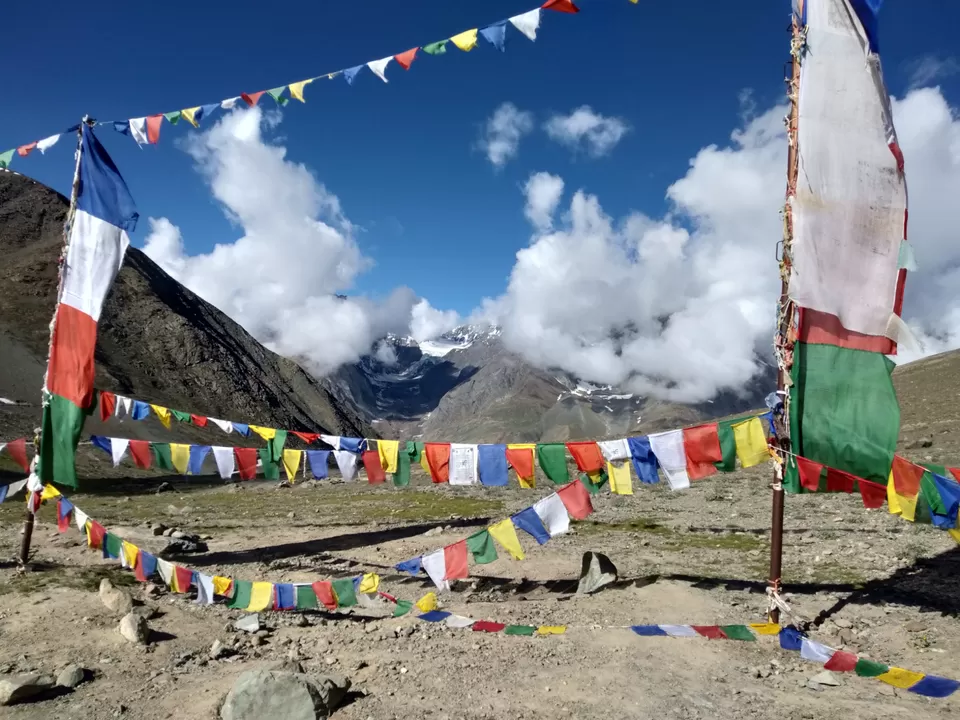
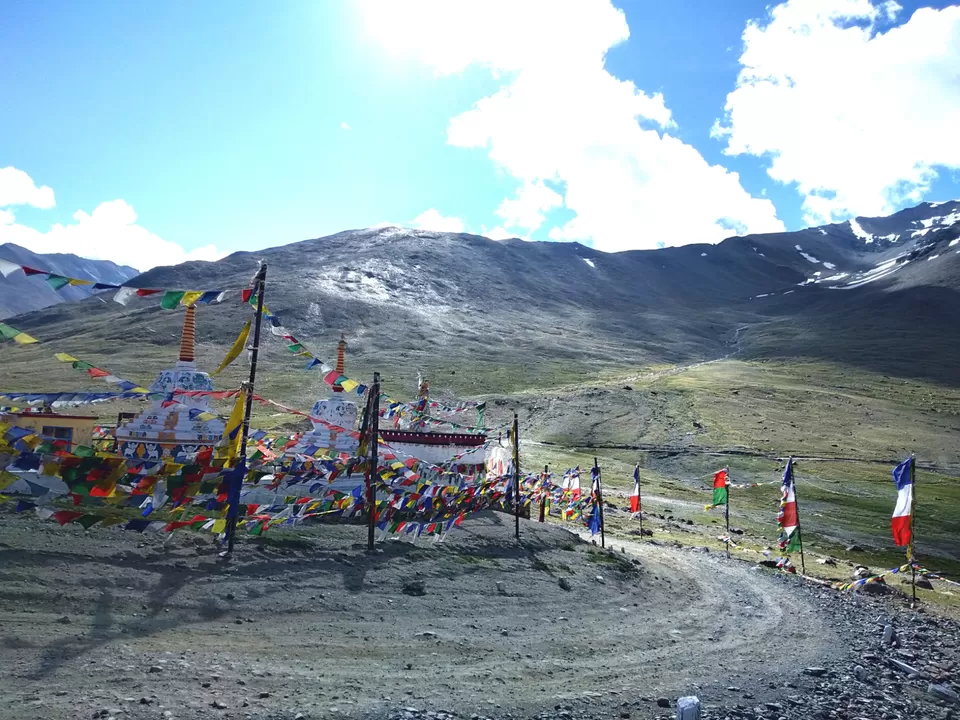
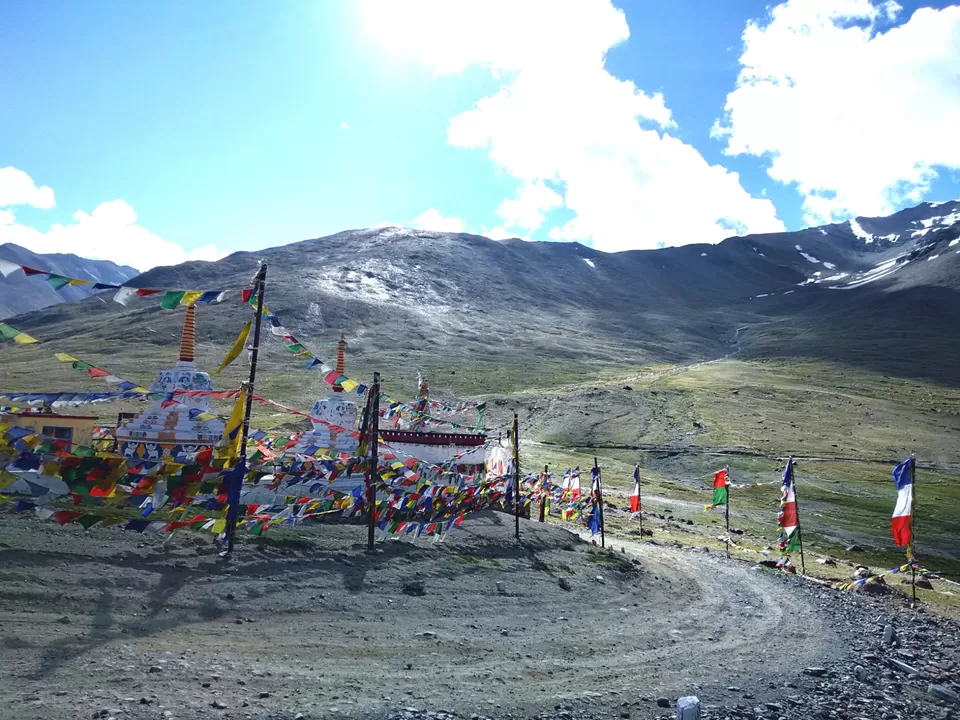
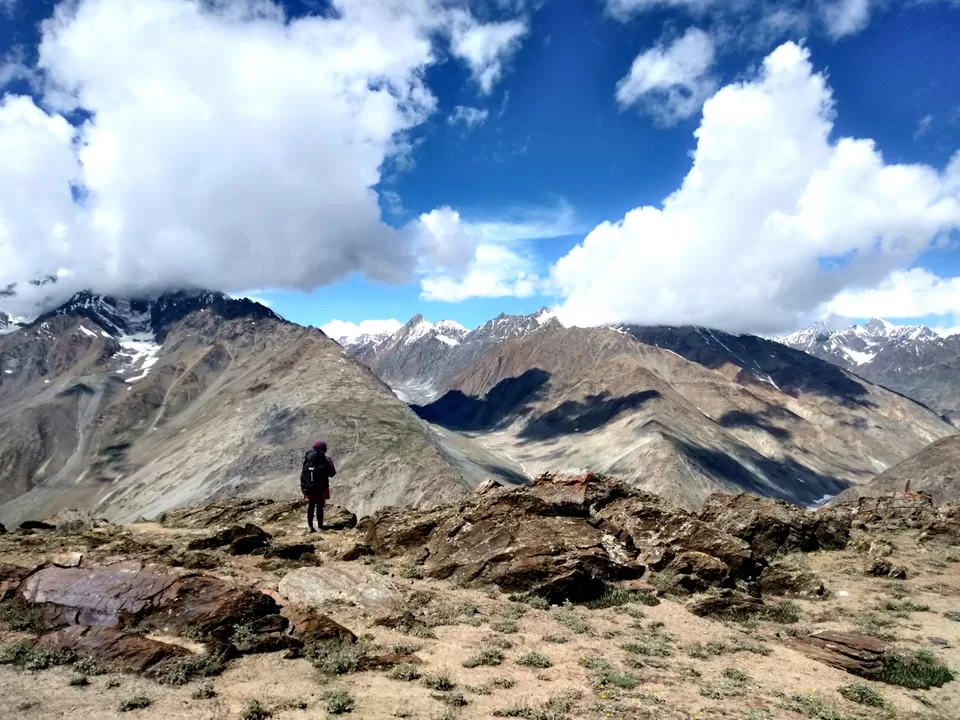

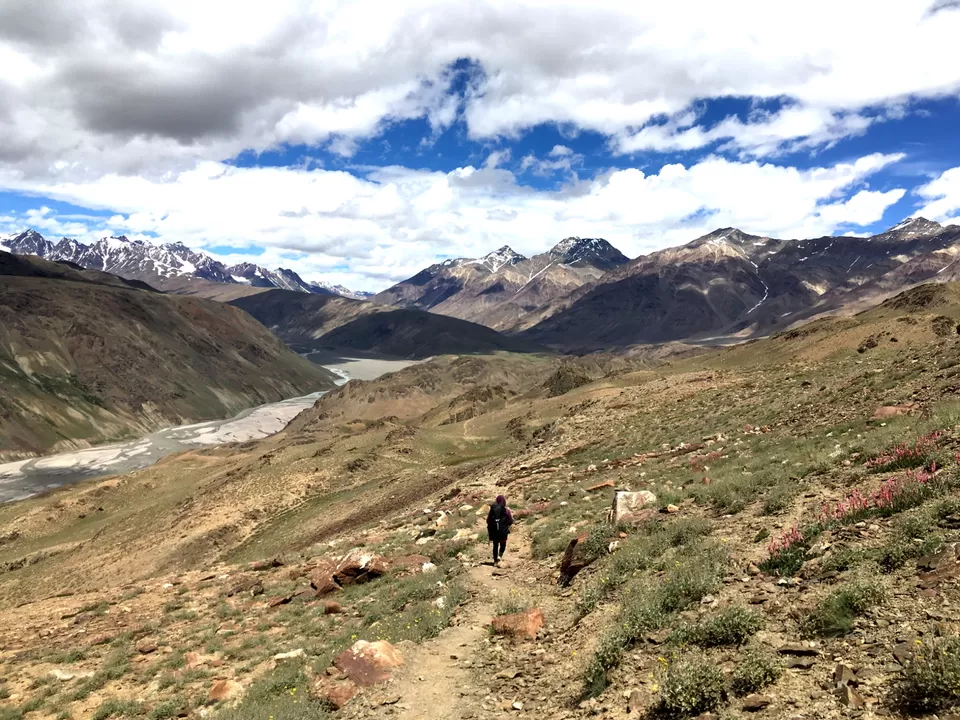
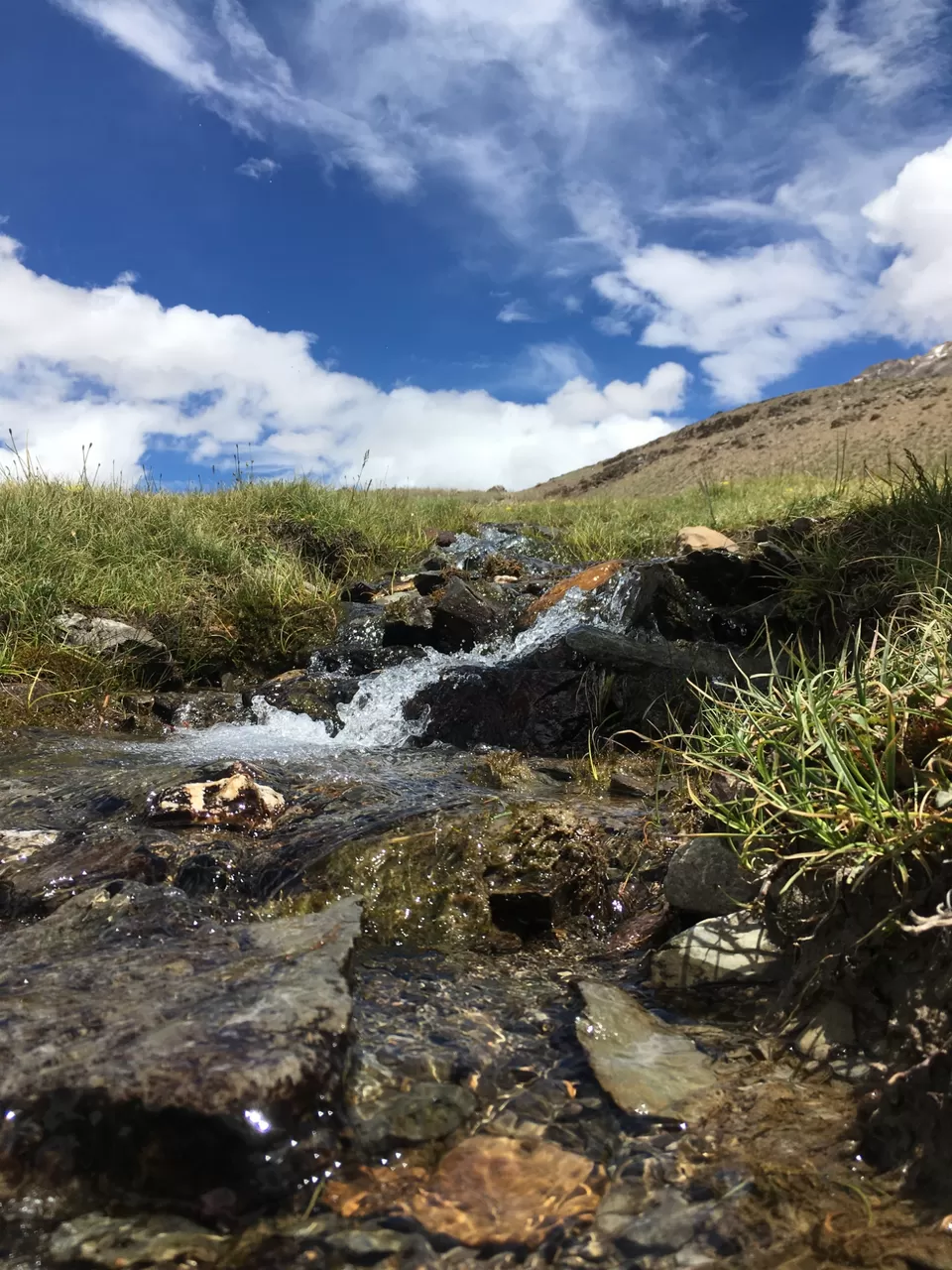
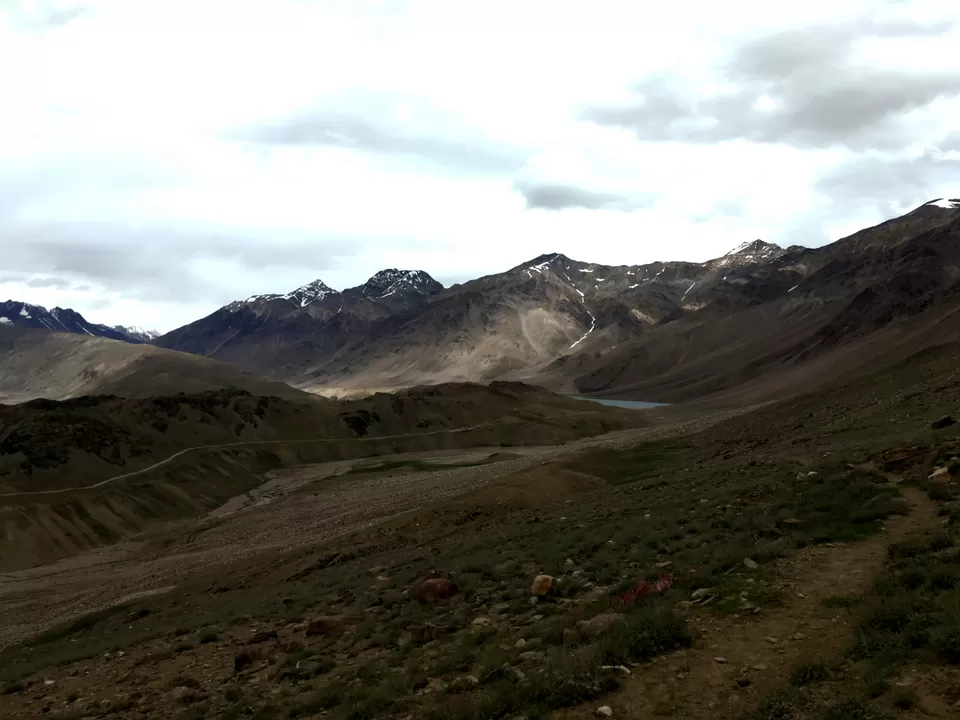
Day 8: Batal-Manali-Bhuntar
The weather did not improve and we had to get to Manali to catch our bus to Delhi so that we could be on time to leave for Bangalore. While looking for alternate in case of bus delay, the caretaker of the guesthouse suggested that we hitchhike as much as possible as there were chances that the more we waited, the more chances of road blockage from rain.
Our luck, we figured, was good when we were able to hitchhike with a support vehicle for riders. We were so glad that we were able to stay cosy inside the vehicle because of all the streams on the road, some of which were knee deep. Imagine this – rain, wind, and knee-deep water while riding on a bike. We were also very lucky in other ways – the person who was driving the support vehicle was incredibly skilled. Half the times, our hearts were in our mouths, thanks to the sheer drops on one side and gushing nalahs on the other. At other times, we were shocked he could even see the road ahead thanks to the fog. We stopped at one spot where we saw a goatherd herding about 500 goats, sheep including pashminas.
By noon our luck started running out though. We got stuck for hours at Rohtang Pass while the weather got steadily worse and more foggy. We somehow made it to the outskirts of Manali, only to find that rocks had fallen on the road from a probable landslide. We then had to take a mindnumbing detour over a super rickety bridge over the angry and frothing Sutlej River. One of the scariest bridge experience of my life at least. It did not help that the bridge was so rickety and that the person who was driving said “Jai Mata Di!” with resignation in his voice just before entering the bridge and that Sutlej was behaving like it was trying to take revenge on mankind.
By noon our luck started running out though. We got stuck for hours at Rohtang Pass while the weather got steadily worse and more foggy. We somehow made it to the outskirts of Manali, only to find that rocks had fallen on the road from a probable landslide. We then had to take a mindnumbing detour over a super rickety bridge over the angry and frothing Sutlej River. One of the scariest bridge experience of my life at least. It did not help that the bridge was so rickety and that the person who was driving said “Jai Mata Di!” with resignation in his voice just before entering the bridge and that Sutlej was behaving like it was trying to take revenge on mankind.
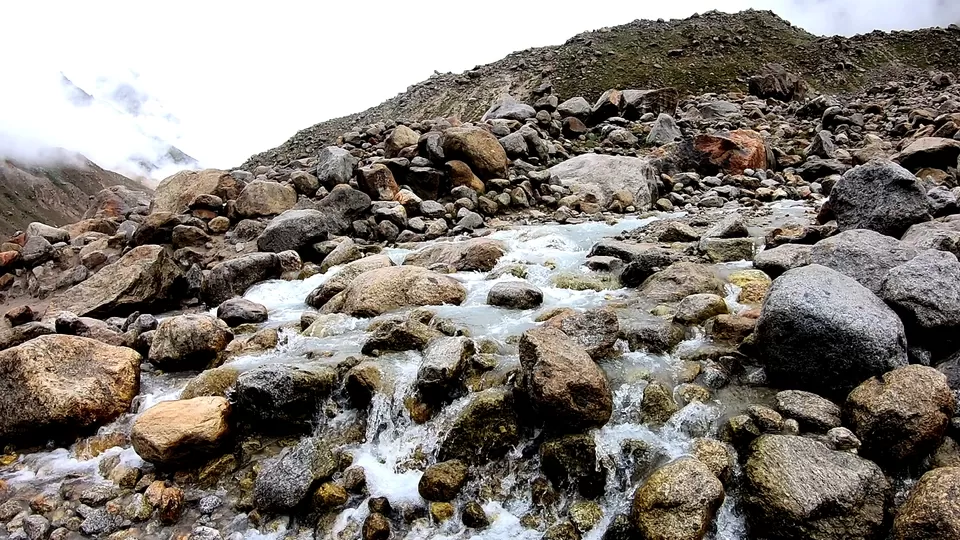
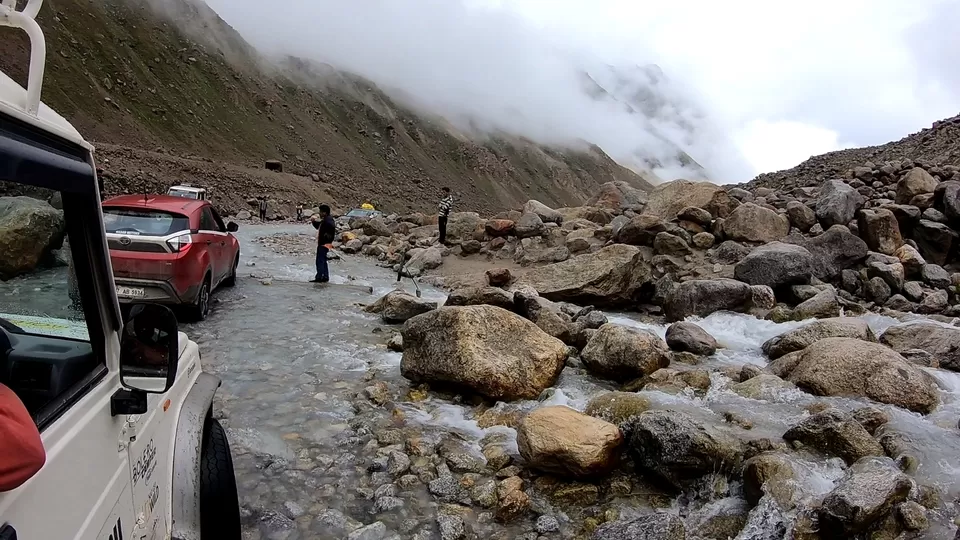
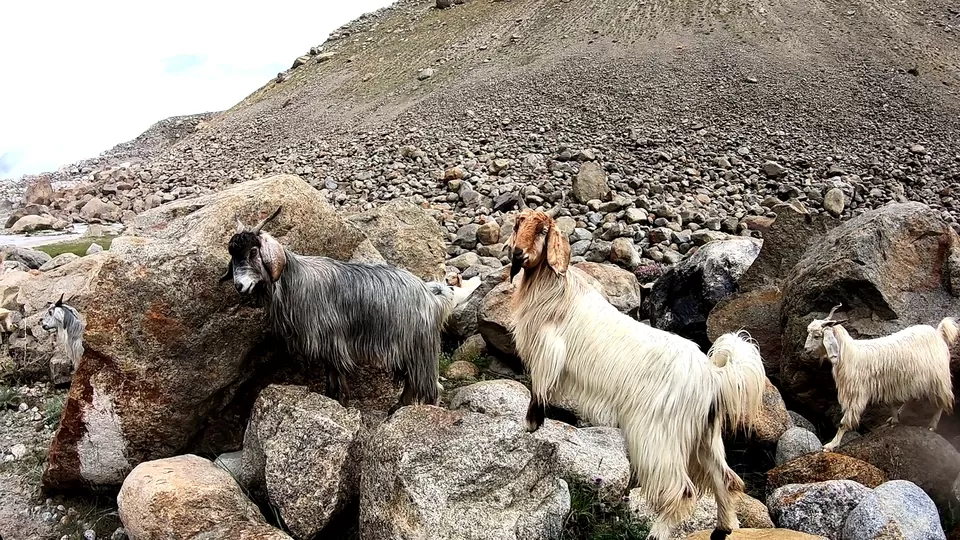
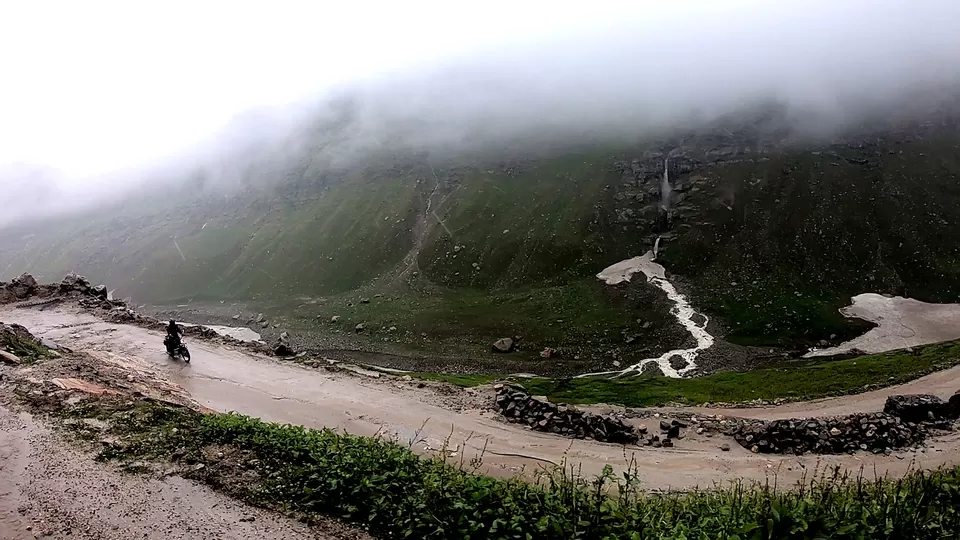
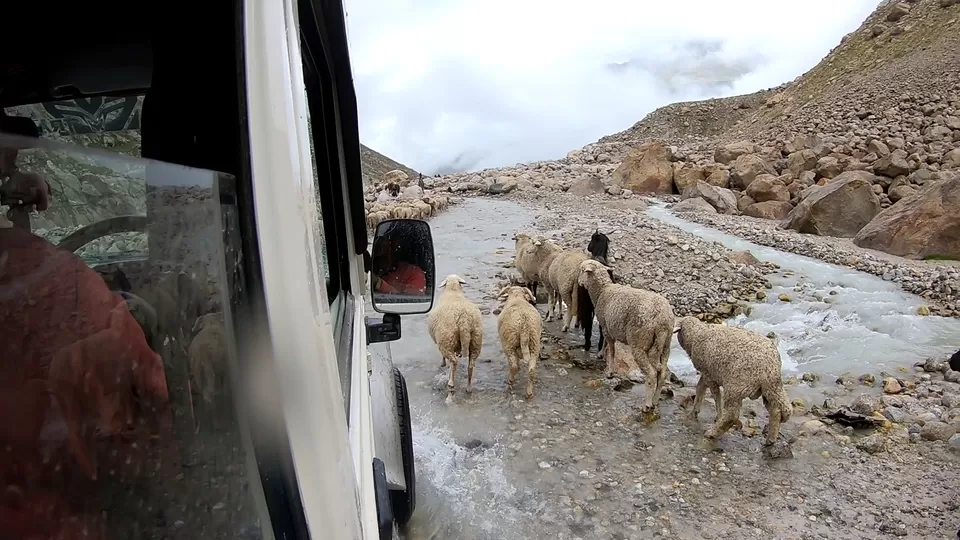
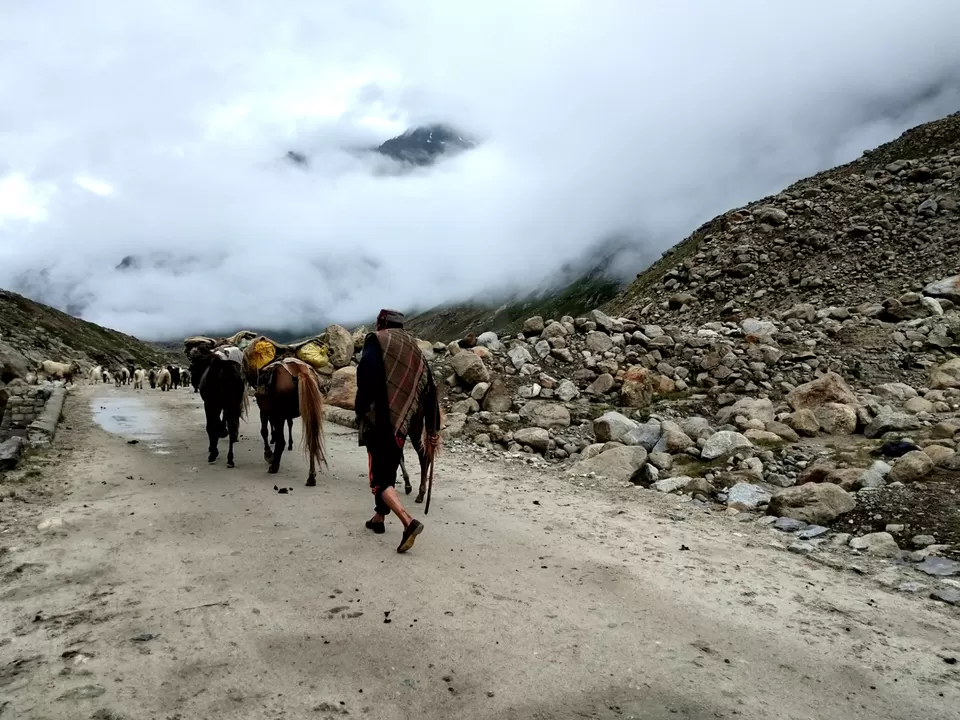
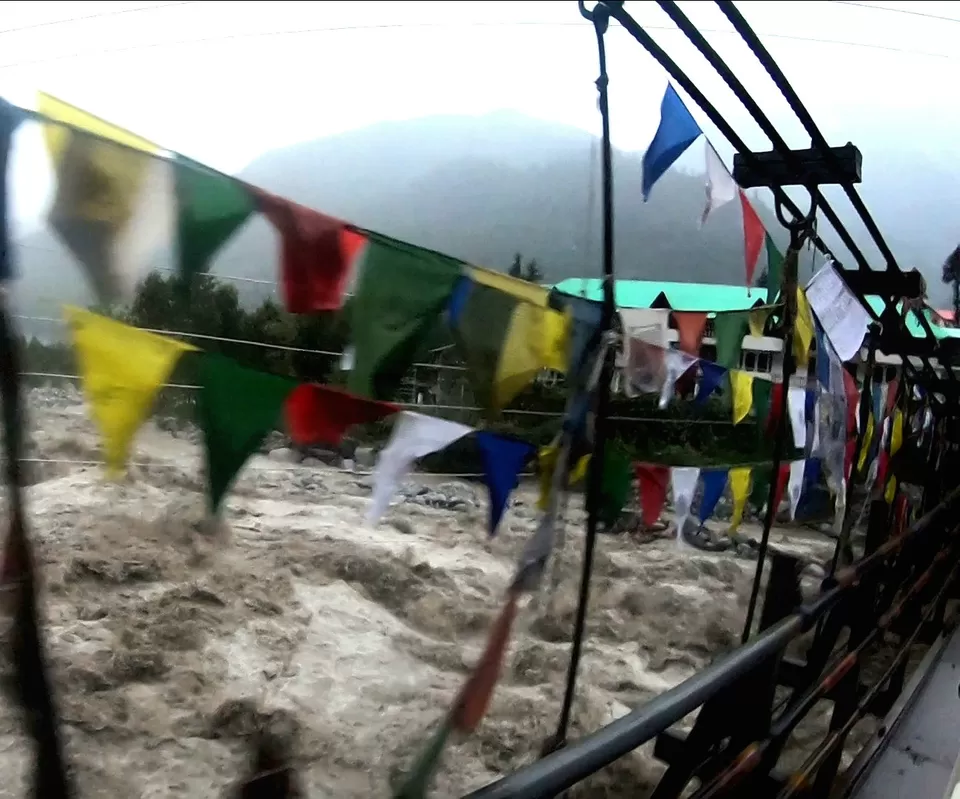
Day 9: Bhuntar
By morning, we realised that the bus would not move on to Delhi. We had started feeling desolate from lack of food. We had survived on junk like Kurkure and Lays the previous night. Around 10 am, we decided to book a room in a hotel nearby. The bus driver further scared us and said we may be stuck for another 10 days here. The place that we stayed in was really close to Manali airport. As we did not want to risk it any further, after severe dilly-dallying and because of flight timings, we rescheduled our flight from Delhi to Bangalore and booked a flight from Manali to Delhi the next day.
Day 10: Manali-Delhi-Bangalore
After our adventure of the past 2 days which included landslides and waterlogging of roads, we finally had a carefree day where we did not miss any bus, train or flight and we made it back safely home.
Pro-tips for Spiti:
1. Carry thermals.
2. Google Maps don’t work. There is no network anywhere once you enter Tabo. You can either download Maps offline or use Maps.Me App. We would definitely suggest using Maps.Me as it was generally accurate.
3. No network equals no way to swipe credit/ debit cards. Carry cash.
4. There are no ATMs on the entire route except in Kaza (2 of them). But the times that we went, the ATMs were not working or were low on cash. So please please carry ample amount of cash.
